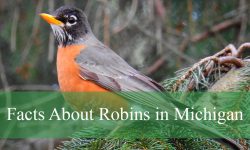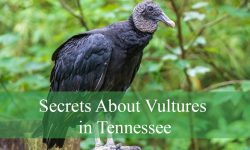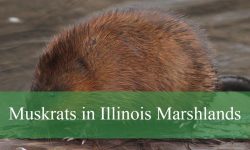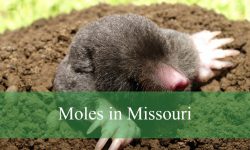Exploring the incredible diversity of the animal kingdom reveals just how many fascinating creatures start with the letter “E.” From tiny insects to majestic mammals, Animals That Start With E come in all shapes and sizes, each one unique in its own way.
This article takes you through 140 remarkable Animals That Start With E, showcasing a variety of species from around the world. You’ll discover animals that range from elegant and elusive to quirky and unusual, each one offering something different. With each entry, we’ll highlight key details to help you better appreciate these creatures.
For those eager to learn more about the wonders of wildlife, this collection of Animals That Start With E is sure to inspire. Get ready to explore their characteristics, habitats, and behaviors as you journey through this fascinating list!
List of Mammals That Start With E
Elephant
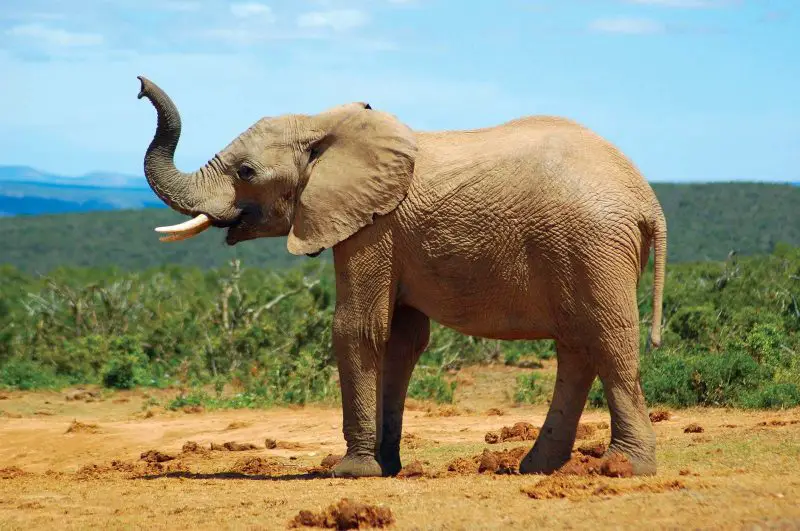
The elephant is the largest land animal on Earth, easily recognized by its massive body, long trunk, large ears, and ivory tusks. African elephants have larger ears shaped like the African continent, while Asian elephants have smaller, rounded ears. Their trunk contains over 40,000 muscles and serves multiple purposes, such as breathing, drinking, trumpeting, grasping objects, and even showing affection. Elephants are herbivores, consuming hundreds of pounds of vegetation daily, including grass, fruits, bark, and roots.
Elephants are native to both Africa and Asia, inhabiting a range of ecosystems from savannas and grasslands to forests and swamps. African elephants are found mainly in sub-Saharan Africa, while Asian elephants range from India to Southeast Asia. These intelligent and highly social animals live in matriarchal family groups led by the oldest female. Males usually leave the herd once they reach adolescence and may live alone or form loose bachelor groups.
One of the most fascinating facts about elephants is their incredible memory and emotional intelligence. They are known to recognize themselves in mirrors, mourn the loss of family members, and even display altruistic behavior. Elephants also communicate through low-frequency rumbles that can travel miles, helping herds stay in touch even when they are far apart.
Elk
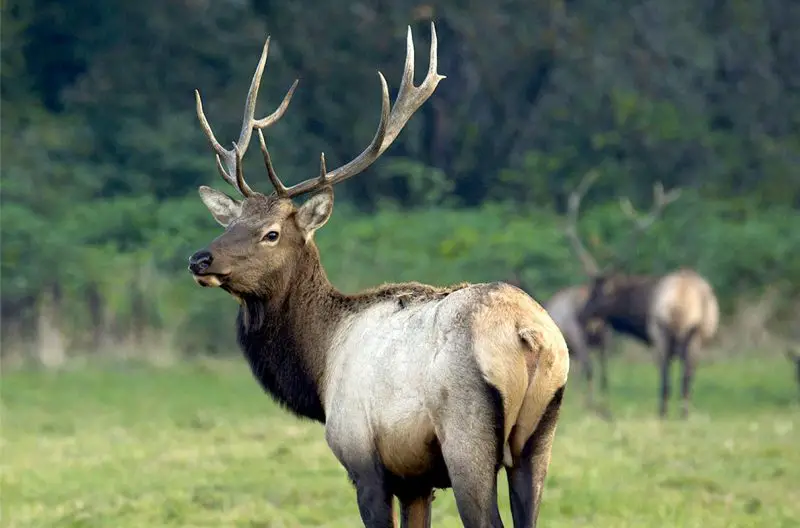
Elk are one of the largest species within the deer family, known for their majestic antlers and deep, resonating calls. Males, called bulls, grow massive antlers that can span over four feet and are shed and regrown annually. Their bodies are covered in brownish-tan fur with a pale rump patch and darker necks. Elk are primarily grazers, feeding on grasses, shrubs, and tree bark, and are most active during dawn and dusk.
Elk are native to North America and parts of Asia, often residing in forests, meadows, and mountainous areas. In North America, they are most commonly found in the Rocky Mountains, the Pacific Northwest, and parts of Canada. Elk migrate seasonally between lower elevations in the winter and higher elevations during the summer, covering vast distances in search of food and suitable habitat.
During the autumn breeding season, male elk engage in fierce battles for access to females, accompanied by bugling calls that echo through valleys. These vocalizations can travel long distances and serve to attract mates and warn off competitors. A remarkable fact is that elk herds can contain hundreds of individuals, and the social dynamics are surprisingly complex, with females often forming tight-knit groups with their young.
Eland
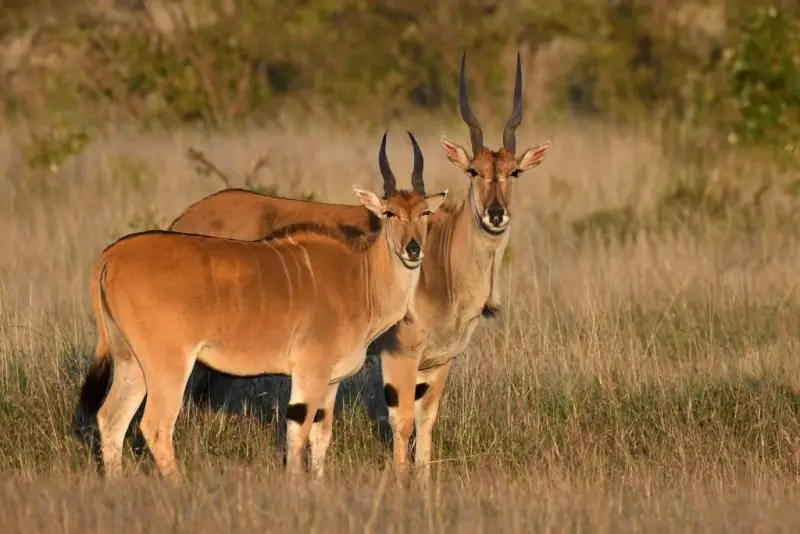
The eland is the largest antelope in the world, with mature males weighing up to 2,000 pounds and standing nearly six feet tall at the shoulder. They are characterized by their fawn-colored coats, long spiral horns (found in both sexes), and a prominent dewlap hanging from their necks. Elands are surprisingly agile for their size and can jump heights exceeding eight feet from a standing position. They are herbivores that feed on grasses, leaves, and fruits.
Elands inhabit the open plains, savannas, woodlands, and mountainous regions of eastern and southern Africa. They are well adapted to arid environments and can go for long periods without drinking, obtaining moisture from the vegetation they consume. These antelopes are generally shy and elusive, often moving in small herds that can grow into larger groups depending on the season and resource availability.
Though usually calm, elands can become aggressive when threatened, and males may fight using their sharp horns during the breeding season. One interesting fact is that elands produce a clicking sound with their knee joints while walking, which is thought to help them communicate within the herd or indicate dominance. Their ability to adapt to various climates makes them a valuable species in wildlife reserves and protected parks.
Echidna

The echidna, or spiny anteater, is a unique egg-laying mammal covered with coarse fur and sharp spines for protection. It has a long, slender snout and an extensible sticky tongue that it uses to feed primarily on ants and termites. Echidnas lack teeth and instead use hardened pads in their mouths to crush food. Their strong front claws are perfect for digging into insect nests and burrowing into the ground.
Echidnas are found throughout Australia and New Guinea, where they inhabit a wide range of environments, including forests, deserts, mountains, and even suburban gardens. They are solitary and nocturnal creatures, spending the day hidden under logs, rocks, or in self-dug burrows. When threatened, an echidna will curl into a ball, presenting its sharp spines to any would-be predator.
Echidnas are among the very few monotremes—mammals that lay eggs rather than giving birth to live young. After laying a single egg, the female keeps it in a pouch for about 10 days until it hatches, and then nurses the hatchling, known as a “puggle.” A fascinating fact is that echidnas can enter a state of torpor during cold weather, dramatically slowing their metabolism to conserve energy.
Ermine

The ermine, also known as the stoat in its summer coat, is a small, agile carnivore belonging to the weasel family. In summer, its coat is brown with a white belly, but during winter in colder regions, it turns pure white, except for the black tip of its tail—a perfect adaptation for camouflage in snow-covered landscapes. Ermines are swift, with flexible bodies and sharp teeth, making them efficient predators.
Ermines are native to northern parts of North America, Europe, and Asia. They thrive in woodlands, meadows, tundra, and farmlands, often taking over burrows made by other animals. They primarily hunt small mammals such as voles, mice, and rabbits but also eat birds, eggs, and insects. Their hunting style is characterized by quick bursts of speed and stealthy movements.
Despite their petite size, ermines are fearless and can take down prey larger than themselves. They are known for their erratic, playful movements, which may help confuse prey or predators. A fun fact is that in medieval Europe, ermine fur was considered a symbol of royalty and purity, often used in royal robes and garments.
Elephant Seal

Elephant seals are enormous, deep-diving marine mammals named for the adult male’s inflatable, trunk-like nose. Male elephant seals can reach up to 16 feet in length and weigh over 8,000 pounds, dwarfing the smaller females. Their blubbery bodies help insulate them from the frigid waters, and they spend the vast majority of their lives at sea, returning to land only to molt and breed.
There are two species: the northern elephant seal, found along the west coast of North America, and the southern elephant seal, which inhabits sub-Antarctic islands. These seals are exceptional divers, capable of plunging over 5,000 feet beneath the ocean’s surface to hunt squid, fish, and other deep-sea creatures. They can remain submerged for over an hour during these hunting trips.
During the breeding season, males fight brutal battles on beaches to establish dominance and control harems of females. These battles involve loud roaring, chest bumping, and biting. One amazing fact about elephant seals is their ability to fast for weeks or even months during breeding and molting periods, surviving entirely on their stored fat.
Elephant Shrew
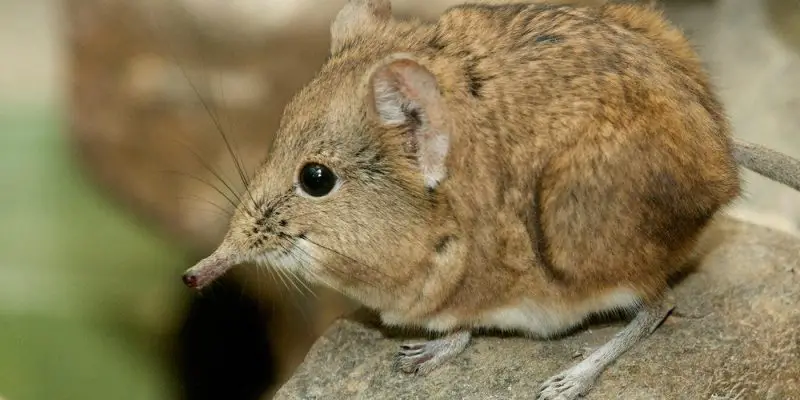
Despite its name, the elephant shrew is neither an elephant nor a shrew, but a small, insectivorous mammal with a long, flexible snout. Its name comes from the resemblance of its nose to an elephant’s trunk, which it uses to sniff out insects and other small prey. Elephant shrews have slender limbs, large eyes, and are covered in soft fur, often brown or gray to blend in with their surroundings.
Elephant shrews are native to Africa and inhabit a range of environments including forests, savannas, and rocky outcrops. They are extremely agile and fast, able to dart quickly across the ground to escape predators. Some species are territorial and construct intricate pathways through vegetation, which they memorize and use for foraging and escape routes.
One fascinating fact about the elephant shrew is its taxonomic uniqueness—it was once thought to be related to true shrews but is now classified under the order Macroscelidea and more closely related to elephants, sea cows, and aardvarks. Their monogamous pairing behavior and detailed trail systems make them one of the more socially interesting small mammals.
Eurasian Beaver
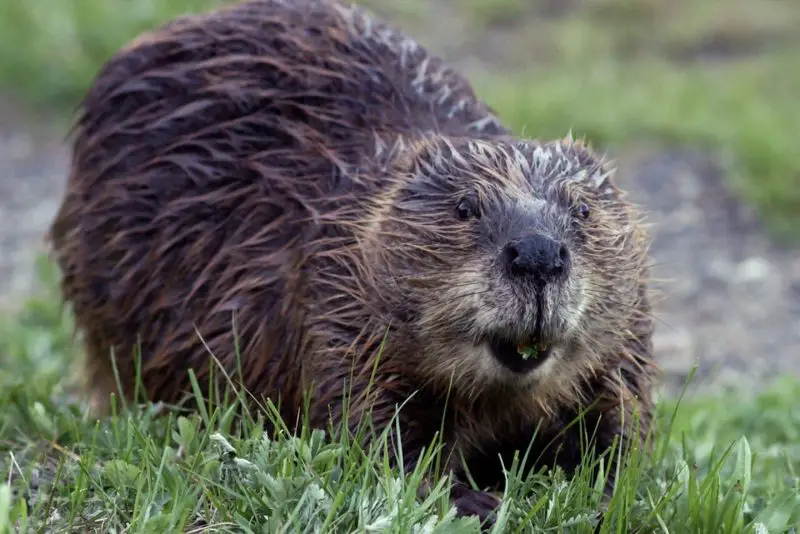
The Eurasian beaver is one of the largest rodent species in the world, known for its powerful jaws, webbed feet, and flat, scaly tail. With dense, waterproof fur and strong teeth that can cut through tree trunks, these beavers are excellent builders. They construct dams, lodges, and canals using branches, mud, and stones to create aquatic environments that suit their needs.
Eurasian beavers are found across Europe and parts of Asia, especially in rivers, streams, lakes, and wetlands. They are nocturnal and semiaquatic, spending much of their time in water to avoid predators. Beavers play a vital ecological role, creating habitats that benefit many other species and improving water quality through their engineering efforts.
These industrious animals were once hunted nearly to extinction for their fur and castoreum, but conservation efforts have led to successful reintroduction in many areas. An interesting fact is that their dams can become massive—some structures built by beavers have stretched over 2,500 feet long and are even visible from space.
Eurasian Lynx
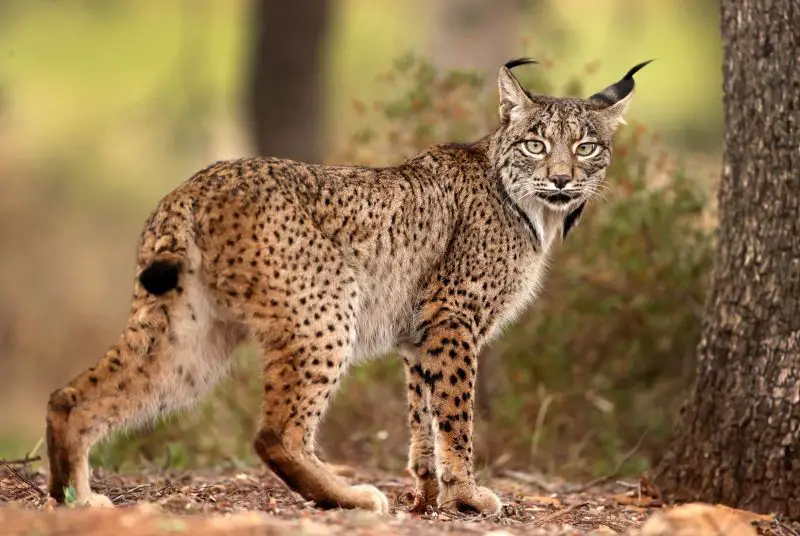
The Eurasian lynx is a powerful wild cat known for its tufted ears, thick spotted coat, and solitary nature. Larger than the North American bobcat, the Eurasian lynx has long legs and a short tail, with a fur coat that changes from reddish in summer to silvery gray in winter. Its sharp eyesight and hearing make it an expert hunter.
This lynx species inhabits forests across Europe, Russia, and Central Asia, favoring dense woodlands with plenty of cover. It preys on deer, hares, birds, and rodents, using stealth and ambush techniques to capture food. The Eurasian lynx plays a critical role in controlling populations of medium-sized herbivores in its ecosystem.
Despite its elusive nature, the Eurasian lynx is gradually making a comeback in areas where it had disappeared due to habitat loss and hunting. One intriguing fact is that lynx can cover several miles in a single night while hunting, and their padded feet help them move silently through snow and undergrowth.
Ethiopian Wolf
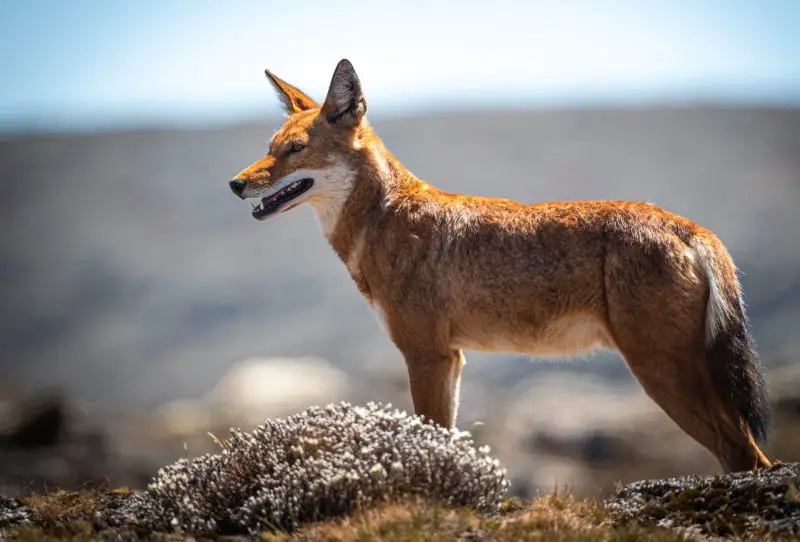
The Ethiopian wolf is one of the world’s rarest and most endangered canids, distinguished by its slender body, reddish coat, and white markings. It closely resembles a fox but is more closely related to gray wolves. Adapted to high-altitude life, it has long legs and a narrow snout suited for catching rodents.
This wolf species lives in the Ethiopian highlands, particularly in alpine grasslands above 10,000 feet. It prefers open, treeless terrain where it can spot and stalk small prey like mole rats, grass rats, and other highland rodents. Ethiopian wolves live in packs but tend to hunt alone, making them unique among social canids.
There are estimated to be fewer than 500 Ethiopian wolves in the wild, making conservation efforts crucial. One remarkable fact is their specialized diet and habitat preference make them extremely sensitive to environmental changes and human encroachment. Conservationists have focused on disease prevention and habitat protection to preserve this rare species.
Eurasian Red Squirrel
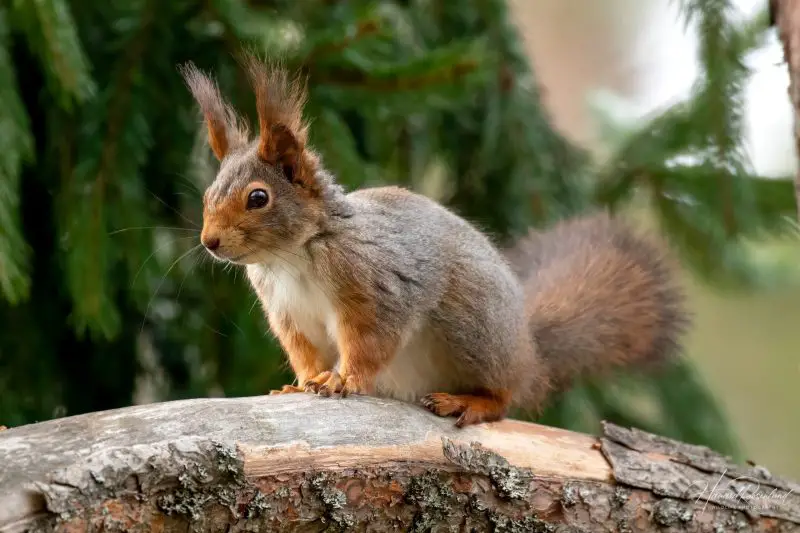
The Eurasian red squirrel is a small, agile rodent with a fluffy tail and sharp claws for climbing trees. It is best known for its reddish-brown fur, though the color can vary from deep red to almost black, and its large ear tufts that become more pronounced in winter. This squirrel is an important seed disperser and forest dweller.
Red squirrels are found across much of Europe and northern Asia, inhabiting coniferous and mixed forests. They are active during the day and build spherical nests called dreys in tree branches. Their diet includes seeds, nuts, fungi, berries, and occasionally bird eggs. They hoard food for the winter, often forgetting some caches, which leads to new tree growth.
In some areas, the Eurasian red squirrel is declining due to competition from the invasive gray squirrel, introduced from North America. A charming fact about them is that they use their bushy tails for balance while leaping through trees and also for warmth when curled up sleeping.
English Bulldog

The English Bulldog is a stocky, medium-sized dog with a broad chest, wrinkled face, and distinctive pushed-in nose. Despite its muscular build and somewhat intimidating appearance, bulldogs are known for their calm demeanor, loyalty, and affectionate nature. They have a smooth, short coat that comes in various colors like fawn, brindle, white, and piebald.
Originally bred in England for bull-baiting, a violent sport, the modern English Bulldog has been selectively bred for gentler traits. Today, they are affectionate companion animals that thrive in households where they receive consistent attention. Bulldogs are not high-energy dogs and are content with short walks and lounging indoors.
A quirky and endearing fact about English Bulldogs is their snoring and snorting—caused by their short snouts (brachycephalic structure)—which many owners find charming. However, their unique anatomy also makes them prone to overheating and respiratory issues, requiring extra care, especially in hot climates.
English Cocker Spaniel

The English Cocker Spaniel is a medium-sized dog known for its long, silky ears, expressive eyes, and merry personality. With a smooth, wavy coat that comes in a variety of colors including black, liver, red, and golden, this breed has a graceful and sturdy build. It’s an affectionate and energetic companion with a friendly temperament.
Originally bred in England as a hunting dog, particularly for flushing and retrieving game birds like woodcock (from which it gets its name), the English Cocker Spaniel thrives in both rural and urban environments. It adapts well to family life, loves playing outdoors, and needs daily physical activity to stay happy and healthy.
These dogs are known for their joyful disposition and are often referred to as the “merry” breed due to their constantly wagging tails. A fun fact about the English Cocker Spaniel is that they often excel in canine sports such as agility and obedience, thanks to their intelligence and eagerness to please.
English Foxhound

The English Foxhound is a strong, athletic breed developed for the traditional fox hunt in England. It has a lean yet muscular frame, a straight back, and long, powerful legs built for endurance. Its coat is short and dense, typically tricolored in black, white, and tan.
Bred to work in packs and follow scent trails for hours, English Foxhounds are most comfortable in open countryside and require a lot of exercise. Though primarily a working dog, they can adapt to home life if given adequate space, mental stimulation, and companionship. They are friendly and tolerant, especially with other dogs.
What sets the English Foxhound apart is its stamina and deep, melodious bark. A fun fact is that these hounds are still used in traditional fox hunts in some regions, and when kept as pets, they often enjoy activities like hiking or running with their owners.
English Pointer

The English Pointer, often simply called the Pointer, is an elegant and athletic hunting dog known for its remarkable ability to “point” toward game. It has a sleek, muscular body, a long neck, and a distinctive stance when locking onto a scent. Its short coat can be white with liver, lemon, black, or orange markings.
This breed was developed in England in the 17th century to assist hunters by locating and indicating the position of birds. English Pointers thrive in rural settings where they can run freely and exercise their natural instincts. They are friendly and affectionate but require plenty of exercise to prevent boredom.
One interesting fact about English Pointers is that their pointing behavior is instinctive—they will often freeze in place, with a raised paw and focused gaze, even as puppies. Their ability to scent game from long distances makes them exceptional field dogs.
English Setter

The English Setter is a graceful, medium-to-large gun dog known for its feathered coat and gentle, elegant movement. It has a long, lean body, a slightly domed head, and a soft, silky coat that is usually speckled or flecked in shades known as “belton”—blue, orange, lemon, or tricolor.
Bred for bird hunting, English Setters were designed to locate game and crouch or “set” until the hunter could cast a net. They do best in homes where they have space to roam and plenty of daily activity. Their sweet nature and sociable temperament also make them excellent family pets.
A fascinating trait of English Setters is their graceful gait—they seem to “float” when they run. They’re also known for their strong sense of smell and patience while hunting. Their combination of beauty and utility has made them popular in both the field and the show ring.
English Shepherd

The English Shepherd is a highly versatile and intelligent herding dog with a deep-rooted history in American agriculture, despite its name. It typically has a medium-length coat that can be black and white, sable, or tricolor, and a balanced, athletic build. This breed is known for its strong work ethic and loyalty.
Though it originated from English and Scottish sheepdogs, the English Shepherd was refined in the United States to herd livestock, guard property, and serve as a general farm dog. They are especially common on small farms and homesteads, where their versatility is most appreciated. They thrive in active environments with a job to do.
A fun fact about English Shepherds is their instinctive ability to manage animals with minimal training. They are also known for their strong bond with family members and their watchful, gentle demeanor around children, making them both excellent workers and devoted companions.
English Springer Spaniel

The English Springer Spaniel is a cheerful and energetic dog originally bred for flushing and retrieving game. It has a medium-sized, athletic frame with long ears, expressive eyes, and a wavy coat that’s usually liver and white or black and white. This breed is known for its enthusiastic and affectionate nature.
Highly trainable and eager to please, Springer Spaniels excel in hunting, agility, and obedience. They were developed in England for bird hunting and are still popular among sportsmen today. These dogs require regular exercise and mental stimulation, and they enjoy spending time with their families.
One interesting fact is that the breed name “Springer” refers to their hunting style—they “spring” game out of hiding for the hunter to shoot. Their joyous energy, paired with loyalty and intelligence, makes them a favorite among both working dog enthusiasts and active families.
Entlebucher Mountain Dog

The Entlebucher Mountain Dog is the smallest of the four Swiss Mountain Dog breeds. Compact, muscular, and agile, it has a short tricolor coat—typically black with white markings and rich rust accents. With a confident expression and a bushy tail, it is both alert and loyal, making it a dependable working companion.
Originally bred in the Swiss Alps, this breed was used for herding cattle and guarding farms. It thrives in active households and rural settings where it can engage in physical activities like hiking or agility sports. The Entlebucher forms strong bonds with its family but may be reserved around strangers.
One interesting fact about the Entlebucher Mountain Dog is its problem-solving ability and independent streak. Though affectionate, it tends to be a bit stubborn and does best with experienced owners who provide structured training and consistent leadership.
Estrela Mountain Dog

The Estrela Mountain Dog is a large, powerful livestock guardian breed from the Estrela Mountains of Portugal. It has a dense double coat that can be long or short, often fawn or brindle in color, and a dignified yet affectionate demeanor. Its deep chest and strong frame give it a commanding presence.
Historically used to guard sheep and cattle from predators, this dog thrives in wide, open spaces and mountainous terrains. It is naturally protective, calm, and loyal, making it an excellent watchdog and family guardian. However, early socialization is key to help it become confident and well-adjusted.
A unique trait of the Estrela Mountain Dog is its independence and strong territorial instinct—it will often patrol the property without needing direction. It’s also known for its devotion to its owners and can be especially gentle with children in the family.
Eurasian Wolf
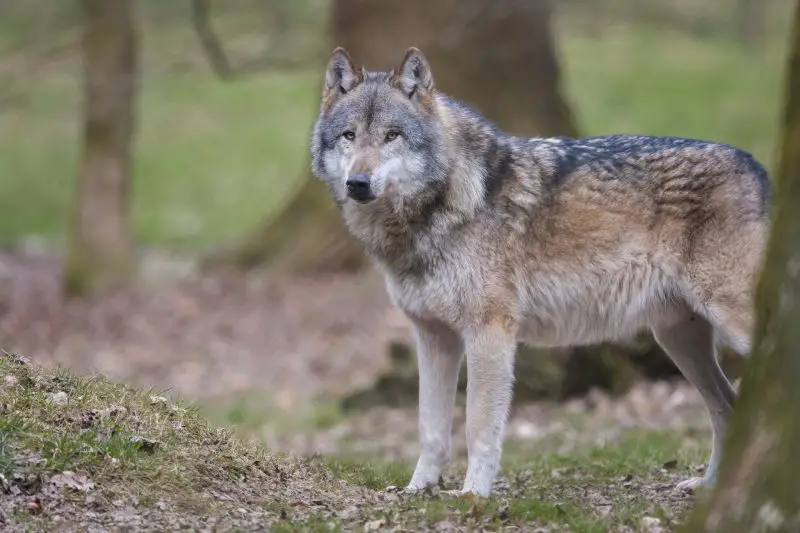
The Eurasian Wolf, a subspecies of the gray wolf, is native to Europe and parts of Asia. It has a lean, athletic build with thick grayish-brown fur that helps it survive cold climates. Known for its intelligence and adaptability, it is one of the most widely distributed wolf subspecies.
Eurasian Wolves inhabit forests, tundra, steppes, and mountainous areas. They live and hunt in packs, which are usually family-based and highly organized. Their diet consists mainly of large ungulates such as deer and wild boar, but they also consume smaller animals when necessary.
A remarkable fact about the Eurasian Wolf is its ability to adapt to varying environments and human pressures. In recent decades, conservation efforts have helped stabilize or even increase their populations in parts of Europe, allowing them to return to habitats from which they had once disappeared.
List of Birds That Start With N
Eagle

Eagles are large birds of prey known for their powerful build, sharp talons, and keen eyesight. Most species have broad wings and a strong, hooked beak, enabling them to tear into flesh with ease. Their majestic appearance and commanding flight have made them symbols of power and freedom across cultures.
Eagles can be found on every continent except Antarctica, with habitats ranging from mountainous regions and forests to open plains and coastal cliffs. They are solitary hunters, often seen soaring at high altitudes as they scan for prey such as fish, small mammals, and other birds.
One fascinating fact about eagles is their exceptional vision—they can spot prey from several kilometers away. The bald eagle, native to North America, is particularly well known and serves as the national bird of the United States.
Egret
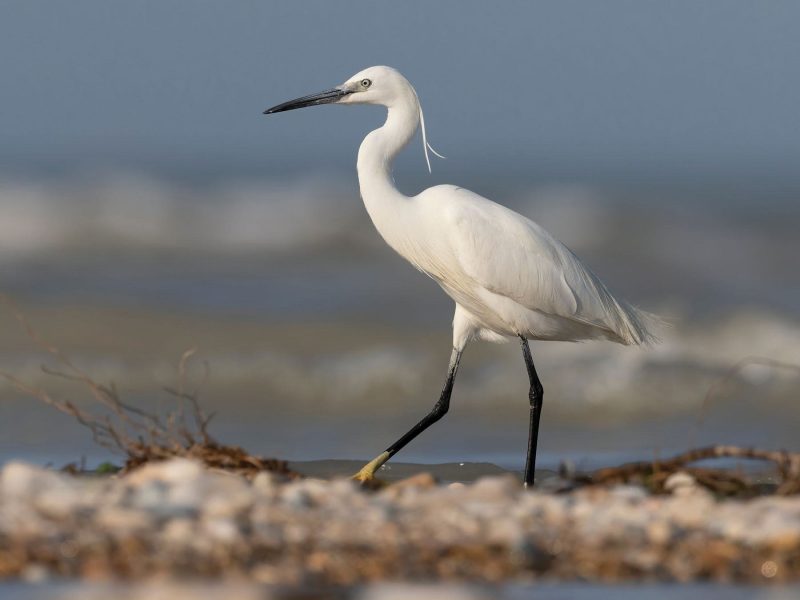
Egrets are elegant, long-legged wading birds, typically adorned with white plumage and slender necks. Belonging to the heron family, they are graceful in appearance and have a sharp bill suited for catching fish, frogs, and insects in shallow water.
They are commonly found near wetlands, rivers, lakes, and coastal regions. Egrets wade slowly or stand motionless as they wait for prey to come within reach. During breeding season, many species develop delicate plumes used in courtship displays.
One notable species, the Great Egret, was once nearly driven to extinction due to demand for its feathers in fashion. Conservation efforts have since helped populations recover, and they are now protected under several international laws.
Emu
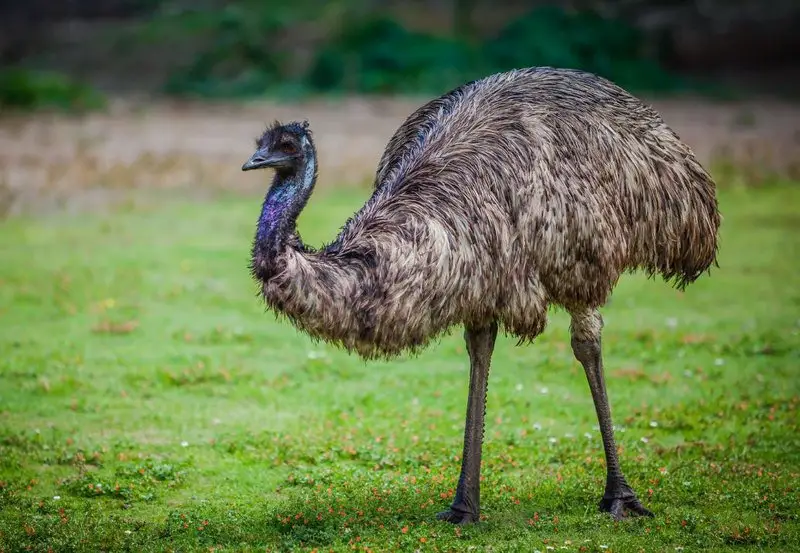
The Emu is the second-largest bird in the world, native to Australia. Flightless and towering up to six feet tall, emus have long legs, small wings, and soft brown feathers that provide camouflage in the wild. Despite their size, they are fast runners and can sprint up to 30 miles per hour.
Emus inhabit a variety of ecosystems across Australia, including open plains, woodlands, and semi-arid regions. They are omnivores, feeding on seeds, fruits, insects, and small animals, often traveling great distances in search of food and water.
A curious fact about emus is that the males are responsible for incubating the eggs and caring for the chicks. Once the female lays her eggs, the male sits on them for nearly two months, rarely leaving the nest and not eating much during that time.
Emperor Penguin

The Emperor Penguin is the largest and heaviest of all penguin species, standing nearly four feet tall. It has a striking appearance with black and white plumage and a splash of golden yellow on its neck. Adapted to frigid temperatures, its thick layer of blubber and densely packed feathers provide insulation.
This species is native to Antarctica and breeds during the harsh winter. Emperor Penguins are known for their remarkable breeding behavior, where males endure brutal cold while incubating eggs on their feet, covered by a flap of skin called a brood pouch.
A fascinating fact about Emperor Penguins is their ability to dive over 1,800 feet deep and stay underwater for more than 20 minutes in search of fish, squid, and krill. Their resilience and social bonding make them one of the most iconic animals of the polar region.
Eurasian Jay
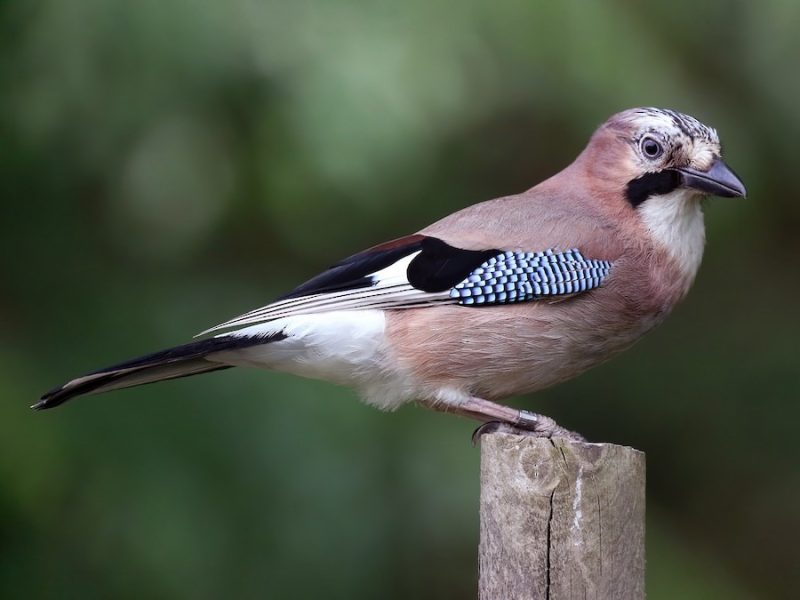
The Eurasian Jay is a colorful and intelligent member of the crow family, recognizable by its pinkish-brown body, black-and-white wings, and bright blue wing patches. Its expressive face and distinctive call make it easily identifiable in woodlands across Europe and Asia.
These birds thrive in deciduous and mixed forests but are also found in parks and gardens. Eurasian Jays are omnivorous, consuming acorns, insects, small vertebrates, and even bird eggs. They are known for their habit of storing food in the ground for later use, particularly acorns.
A remarkable trait of the Eurasian Jay is its ability to mimic sounds, including the calls of other birds and even human-made noises. This vocal mimicry, combined with problem-solving skills, has earned them a reputation as one of the most intelligent songbirds.
Eurasian Nuthatch
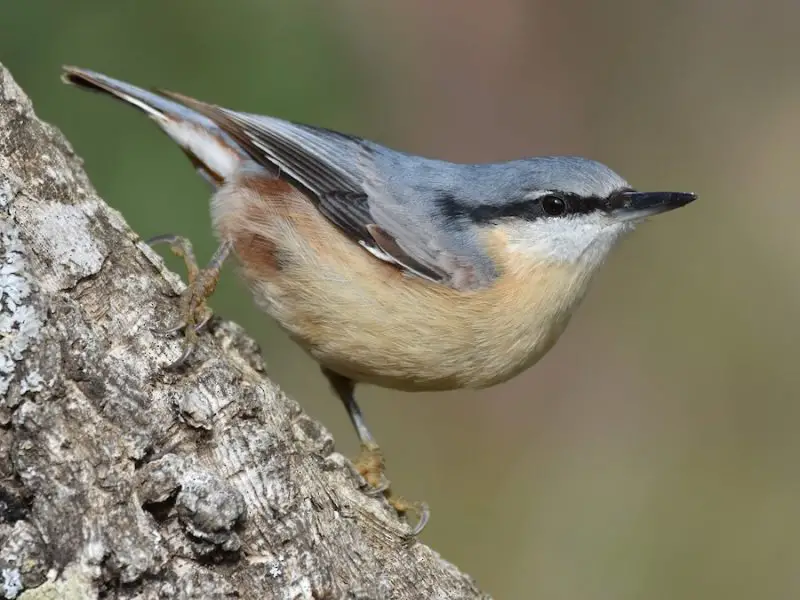
The Eurasian Nuthatch is a small, agile bird with a blue-gray back, a white underside, and a bold black eye stripe. It has a short tail and strong legs that allow it to move effortlessly up and down tree trunks—a unique behavior among birds.
It inhabits temperate forests across Europe and parts of Asia, especially woodlands with mature deciduous trees like oaks and beeches. Nuthatches feed on insects, spiders, and seeds, often wedging food into bark crevices and hammering it open with their sturdy beaks.
One fascinating fact about the Eurasian Nuthatch is that it can climb down trees headfirst—something most birds cannot do. They are also known for plastering mud around the entrance to their nesting holes to adjust the size and deter predators.
Eurasian Sparrowhawk
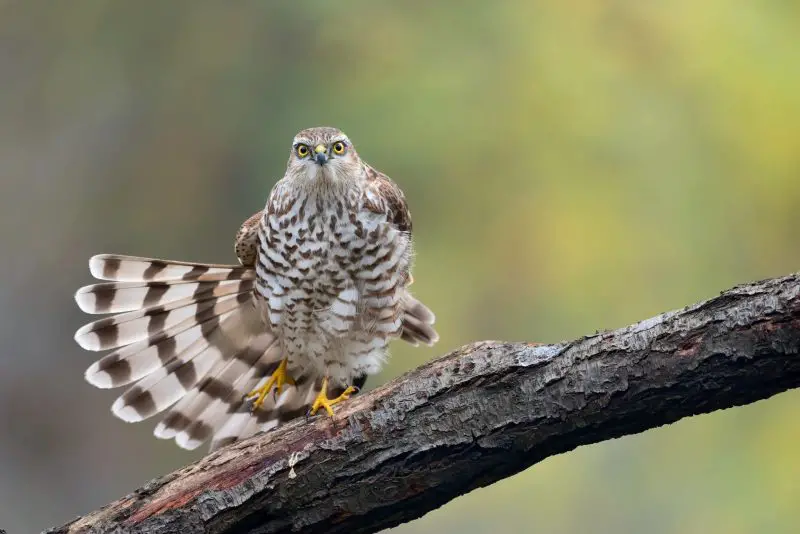
The Eurasian Sparrowhawk is a small, fast-flying bird of prey known for its short, broad wings and long tail that enable it to maneuver skillfully through dense woodland. Males are slate-gray with orange-barred chests, while females are larger with brown plumage and more subtle markings. Their piercing yellow eyes give them a fierce and focused appearance.
These raptors inhabit forests, parks, and gardens across Europe, Asia, and parts of North Africa. They specialize in ambush hunting, darting suddenly through vegetation to catch small birds mid-flight. Their diet mainly consists of finches, sparrows, and other passerines, which they pluck before eating.
An interesting fact about the Eurasian Sparrowhawk is that it shows strong sexual dimorphism—females can be up to 25% larger than males. This size difference allows them to hunt different prey, reducing competition between mates during breeding season.
Eurasian Collared Dove
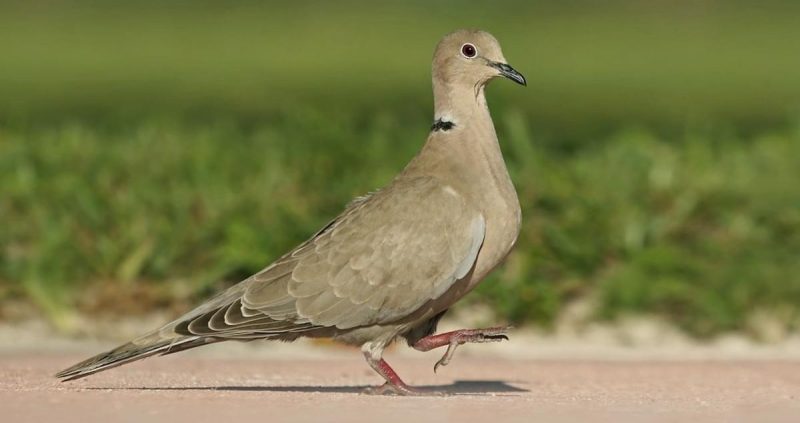
The Eurasian Collared Dove is a medium-sized dove recognized by its soft gray body and distinctive black half-collar on the nape of its neck. Its gentle cooing call and calm demeanor make it a familiar presence in both urban and rural areas. The species has a slender build, dark eyes, and a squared-off tail tipped in white.
Originally native to parts of Asia and the Middle East, it has rapidly expanded its range across Europe and into North America. Eurasian Collared Doves adapt well to human environments, often nesting on buildings, utility poles, or trees near homes and farms. They feed primarily on seeds, grains, and occasional fruits.
One fascinating fact is that this species’ massive range expansion in the 20th century is one of the fastest natural colonizations ever documented in birds. Despite their gentle appearance, they are known to be territorial and will compete with native doves and pigeons for space and food.
Eurasian Eagle-Owl
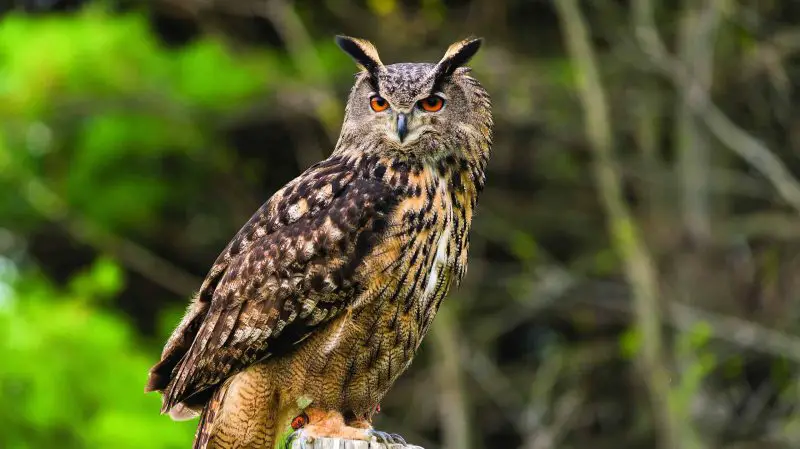
The Eurasian Eagle-Owl is one of the largest owls in the world, with a wingspan that can exceed six feet. It has striking orange eyes, prominent ear tufts, and mottled feathers in shades of brown, gray, and black, providing excellent camouflage in rocky and wooded habitats. Its powerful talons and silent flight make it a formidable nocturnal predator.
This owl inhabits forests, mountains, and cliffs throughout Europe and parts of Asia. It is highly territorial and prefers secluded areas for nesting, often using ledges, caves, or abandoned nests of other large birds. It feeds on a wide range of prey, including mammals, birds, reptiles, and even foxes.
An incredible fact about the Eurasian Eagle-Owl is its ability to take down animals larger than itself. Its low, booming hoot can be heard from miles away, especially during the mating season when pairs call back and forth to establish bonds and claim territory.
Eurasian Bullfinch
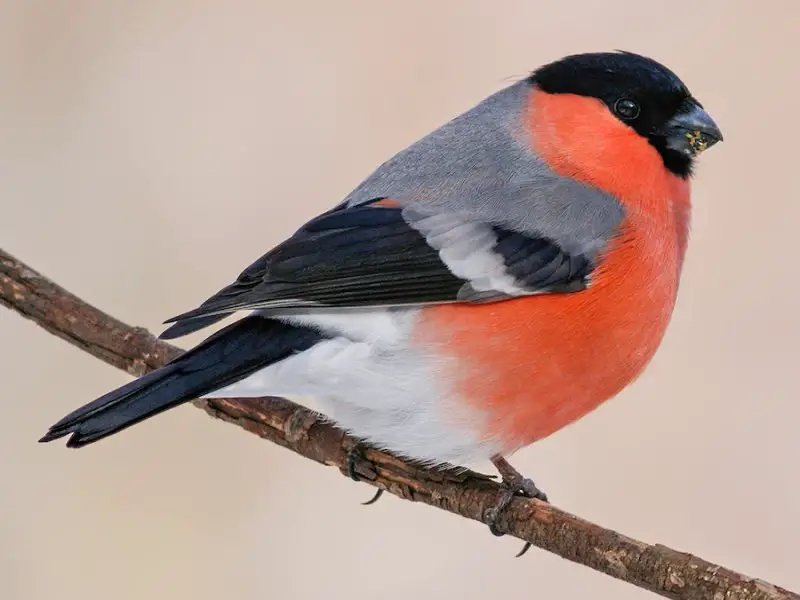
The Eurasian Bullfinch is a charming and stocky songbird known for its vivid coloration and soft, whistling call. Males are particularly eye-catching with bright rose-pink underparts, a black cap, and a white rump, while females have more muted tones of brown and gray. Both sexes have a short, stubby bill adapted for seed eating.
This species inhabits mixed woodlands, hedgerows, orchards, and gardens across Europe and parts of Asia. Bullfinches are relatively shy and often feed quietly in pairs or small groups. They consume buds, seeds, and berries, and are especially fond of fruit trees, which has sometimes put them at odds with farmers.
A unique fact about the Eurasian Bullfinch is its ability to mimic melodies. In the past, they were sometimes kept as cage birds and trained to whistle simple tunes—a reflection of their sweet and melodic song in the wild.
Eurasian Starling
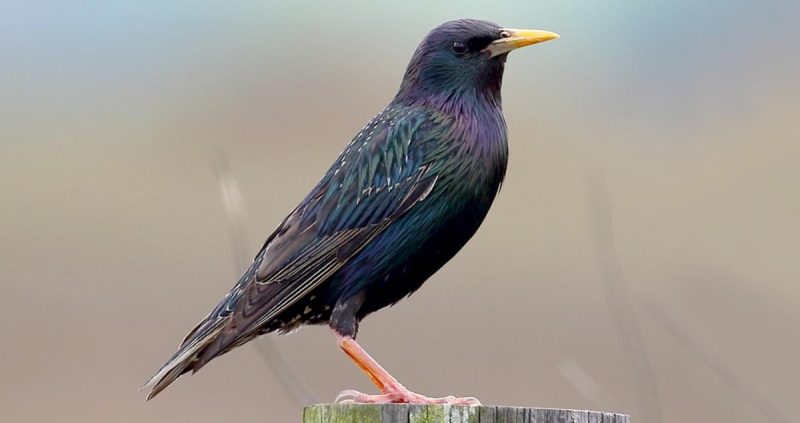
The Eurasian Starling is a highly social and adaptable bird known for its iridescent black plumage that shimmers with purple and green hues. In the right light, it can appear dazzling. Its yellow bill, especially bright in spring, contrasts sharply with its dark body, and it has a confident, strutting gait.
Native to Europe and western Asia, this species has been introduced to North America and other regions, where it has become widespread. Eurasian Starlings thrive in urban areas, farmlands, and open countryside, often forming massive flocks called murmurations that perform breathtaking aerial displays. They eat insects, fruits, and seeds.
One of the most fascinating traits of the Eurasian Starling is its incredible vocal mimicry. These birds can imitate the calls of other birds, machinery, and even human voices, and they incorporate a wide variety of sounds into their complex songs.
Eurasian Curlew
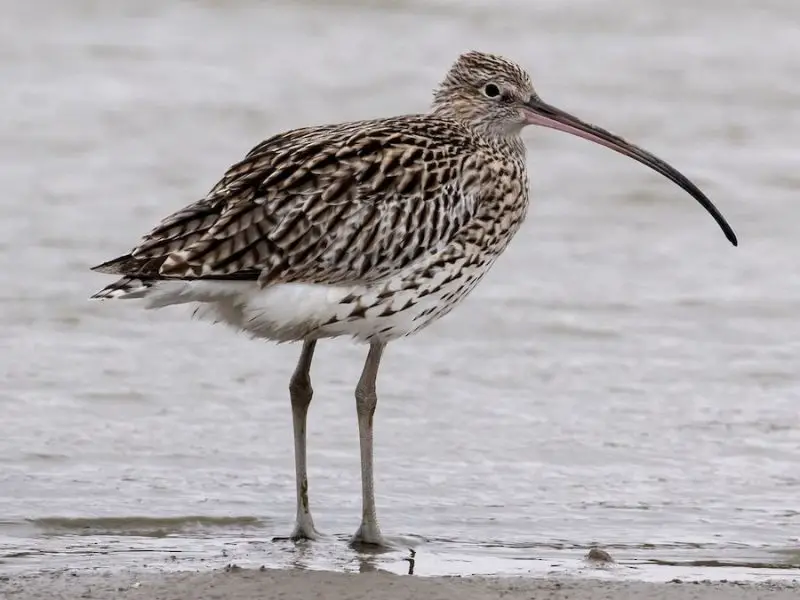
The Eurasian Curlew is a large wading bird easily recognized by its long, downward-curving bill and mottled brown plumage. This slender bill is perfectly adapted for probing into mud and soft ground in search of invertebrates. Its haunting, whistling call carries across wetlands and is a distinctive feature of the European countryside.
It is commonly found in coastal mudflats, estuaries, moorlands, and wet meadows across Europe and parts of Asia. During the breeding season, it moves inland to nest in grasslands and heath. In winter, Eurasian Curlews migrate to warmer regions, often forming flocks in tidal areas.
A fascinating fact about the Eurasian Curlew is that it has the longest bill in proportion to its body size of any wader. Unfortunately, the species is declining in some areas due to habitat loss, and conservation efforts are underway to protect its breeding grounds.
Eurasian Tree Sparrow
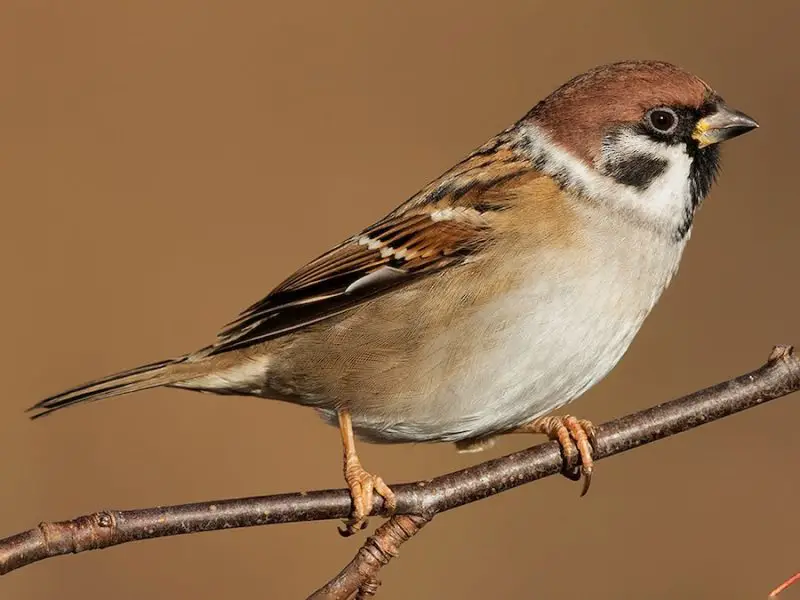
The Eurasian Tree Sparrow is a small, sociable bird with a rich chestnut-brown crown, black cheek spots, and a neat, white collar. It is often confused with the larger House Sparrow but can be identified by its more delicate features and consistent markings. Both sexes look alike, which is uncommon among sparrows.
These sparrows live in open countryside, farmland, woodland edges, and suburban gardens across Europe and parts of Asia. They nest in cavities—often old woodpecker holes or nest boxes—and prefer to stay in small, close-knit groups. Their diet consists mostly of seeds, grains, and insects, especially during breeding season.
An interesting fact is that Eurasian Tree Sparrows often form communal roosts in hedgerows or dense vegetation, especially during winter. While they are widespread in Europe, they are less common in urban areas than their cousin, the House Sparrow.
Eurasian Skylark
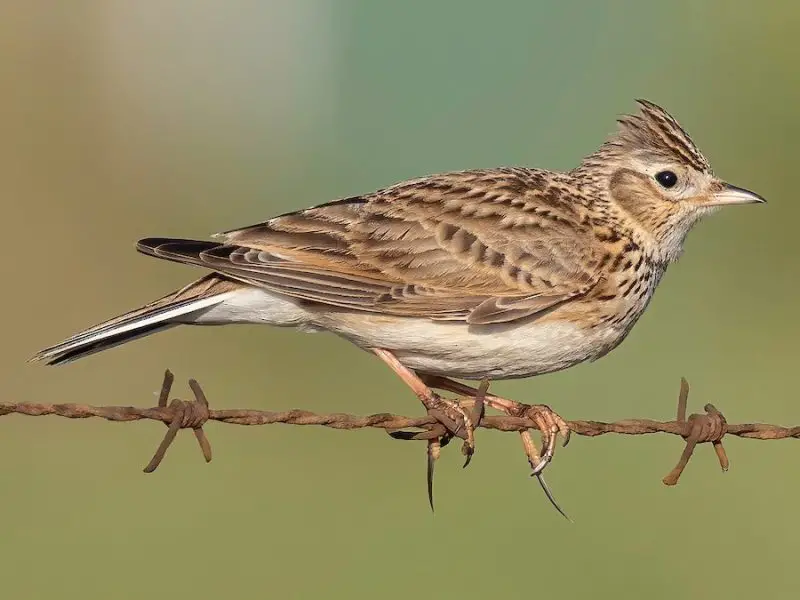
The Eurasian Skylark is a medium-sized songbird known for its remarkable singing flight. Its plumage is streaked brown and beige, providing camouflage among grasses, but it’s the skylark’s soaring song that truly sets it apart. Males ascend high into the sky, singing continuously as they hover to attract mates and defend territory.
It inhabits open fields, meadows, farmlands, and grasslands across Europe and parts of Asia. The Eurasian Skylark nests on the ground, creating well-hidden depressions in grassy areas. It feeds on seeds, grains, and insects, particularly during the breeding season when chicks need protein-rich food.
One amazing fact about the Eurasian Skylark is that its song can last for several minutes while the bird hovers hundreds of feet in the air. This extraordinary display has inspired poets and musicians for centuries.
Eurasian Magpie
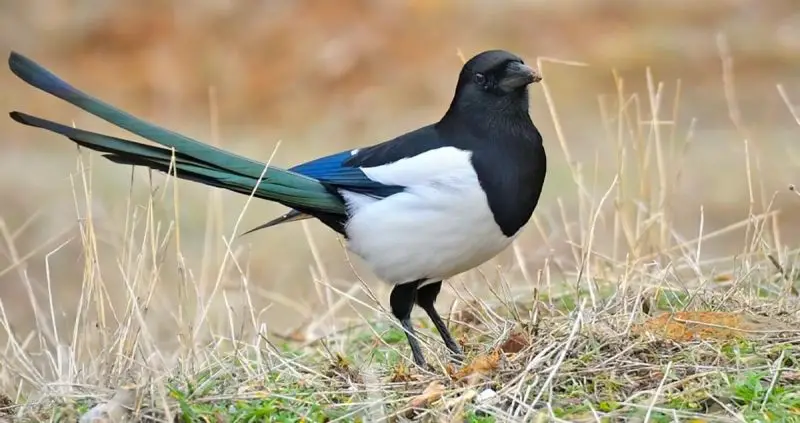
The Eurasian Magpie is a highly intelligent and striking bird with a glossy black-and-white body and iridescent blue-green wings and tail. It has a long tail, sturdy build, and a curious personality that makes it easily recognizable. Magpies are part of the crow family and share the group’s renowned problem-solving abilities.
They are found across Europe, parts of Asia, and North Africa, thriving in woodlands, farmland, and suburban areas. Eurasian Magpies are omnivorous, eating insects, small animals, eggs, carrion, seeds, and even shiny objects they sometimes collect out of curiosity.
An astonishing fact about the Eurasian Magpie is that it’s one of the few non-human species that can recognize itself in a mirror—a sign of advanced cognition. In some cultures, they are seen as symbols of good fortune or mischief, depending on the number seen.
Eurasian Golden Oriole
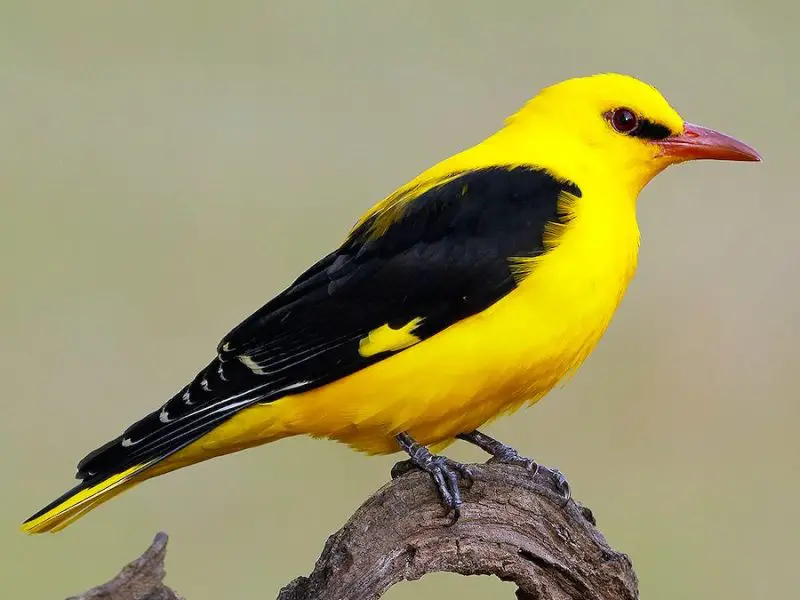
The Eurasian Golden Oriole is a bright and elusive songbird known for its vivid golden-yellow plumage and melodious, flute-like call. Males have striking black wings and tails that contrast with their yellow bodies, while females are more olive-green with streaked underparts. Despite their bold colors, they are often hard to spot due to their canopy-dwelling habits.
This species breeds in open woodlands, orchards, and parks throughout Europe and western Asia. It migrates to central and southern Africa for the winter. The oriole feeds on insects, berries, and nectar, often flitting silently through the treetops in search of food.
A fun fact is that despite the name, the Eurasian Golden Oriole is more closely related to crows than to New World orioles. Their whistled song is a sign of summer in many parts of Europe, though their shy nature makes them more often heard than seen.
Eurasian Hoopoe
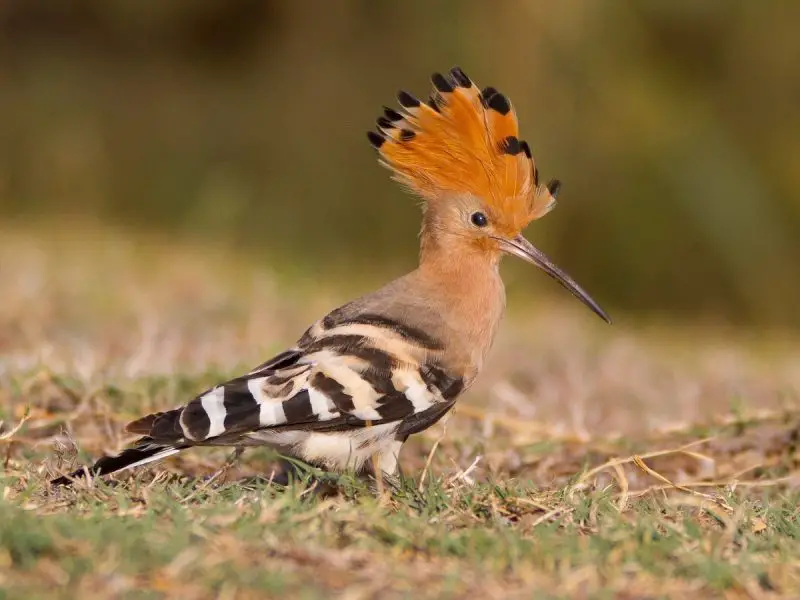
The Eurasian Hoopoe is a unique and colorful bird with a cinnamon-orange body, black-and-white striped wings, and a dramatic fan-shaped crest that it raises when excited. Its long, curved bill helps it probe the ground for insects, its primary food source.
Found across Europe, Asia, and parts of North Africa, the Hoopoe inhabits open landscapes like orchards, vineyards, grasslands, and savannas. It nests in tree cavities, walls, or crevices, and is especially known for its distinctive “hoo-poo” call from which its name derives.
One unusual fact about the Eurasian Hoopoe is that it produces a foul-smelling secretion during nesting, which helps deter predators. Despite this odd trait, its exotic appearance makes it one of the most visually striking birds in its range.
Eurasian Coot
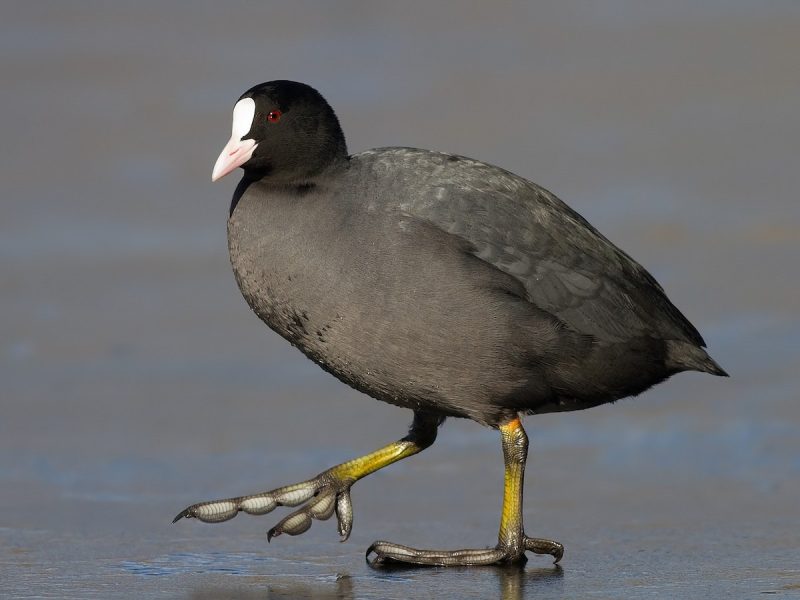
The Eurasian Coot is a medium-sized waterbird with black plumage, a distinctive white facial shield, and red eyes. Its lobed toes, unlike the webbed feet of ducks, allow it to swim efficiently while also walking easily on land. Despite its generally dark appearance, its stark white beak and forehead patch make it easy to recognize.
Eurasian Coots are commonly found in freshwater lakes, ponds, rivers, and marshes across Europe, Asia, and parts of North Africa. They prefer habitats with dense aquatic vegetation, which provides both food and nesting material. These birds are often seen aggressively defending their territory with splashes and chases.
One interesting fact about the Eurasian Coot is that it frequently engages in “turf wars” with other coots during breeding season. It also lays large clutches of eggs, sometimes more than it can care for, leading to sibling rivalry and competition among the chicks.
Eurasian Teal
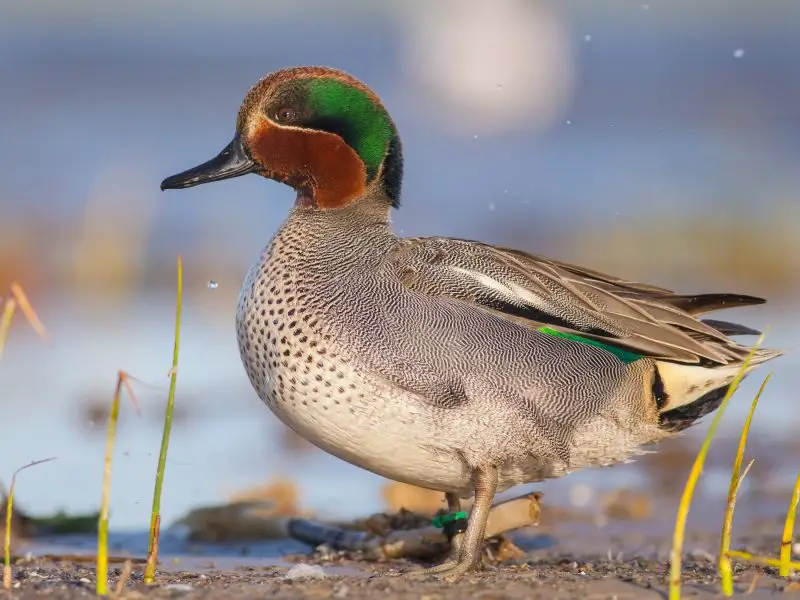
The Eurasian Teal is a small and elegant species of dabbling duck. Males in breeding plumage feature a chestnut-colored head with a bold green eye patch and a finely speckled gray body, while females are mottled brown with a more camouflaged appearance. They are agile flyers, often seen in fast, twisting flocks.
These ducks inhabit shallow wetlands, marshes, and floodplains across Europe and Asia, migrating southward in winter to North Africa and southern Asia. They forage in shallow waters, dabbling for seeds, aquatic plants, and small invertebrates.
A notable fact about the Eurasian Teal is that it is one of the smallest ducks in its range. Despite its size, it is highly migratory, and large numbers gather during migration seasons in key wetland stopover sites.
Eurasian Wigeon
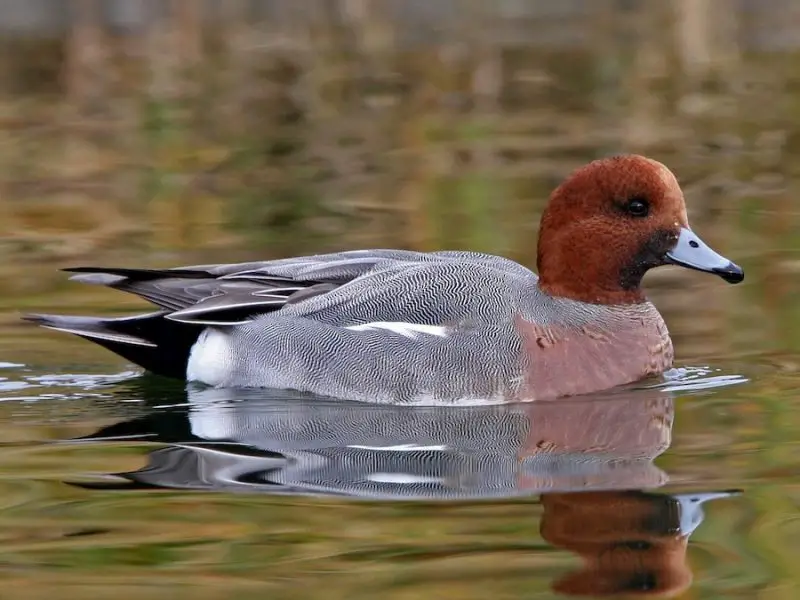
The Eurasian Wigeon is a handsome dabbling duck known for the male’s striking cinnamon-colored head, creamy crown, and soft gray body. Females are more subdued in color with a mottled brown appearance. Both sexes have a distinctive white belly and a high-pitched whistling call.
It breeds in northern Europe and Asia, favoring tundra lakes, bogs, and wet meadows, and migrates south to spend the winter in more temperate wetlands, estuaries, and coastal lagoons. The Eurasian Wigeon grazes on land and also feeds on aquatic vegetation while dabbling in shallow water.
A fascinating fact about this duck is its unique whistling voice, often heard in large flocks. Unlike many ducks that feed in the water, Wigeons are known to graze on grasslands like geese, often forming mixed-species feeding groups.
Eurasian Spoonbill

The Eurasian Spoonbill is a tall, white wading bird with long black legs and a distinctive spoon-shaped bill. In breeding season, it sports a graceful crest at the back of its head and develops a yellowish wash on its chest. Its unusual bill shape helps it sift through water to catch prey.
This species inhabits shallow wetlands, lakes, estuaries, and lagoons across southern and central Europe, parts of Asia, and North Africa. Spoonbills are often seen sweeping their bills side to side in the water as they search for fish, crustaceans, and aquatic insects.
An amazing fact about the Eurasian Spoonbill is its methodical feeding technique, which relies on touch rather than sight. This behavior makes it highly effective in murky waters where visibility is poor.
Eurasian Bittern
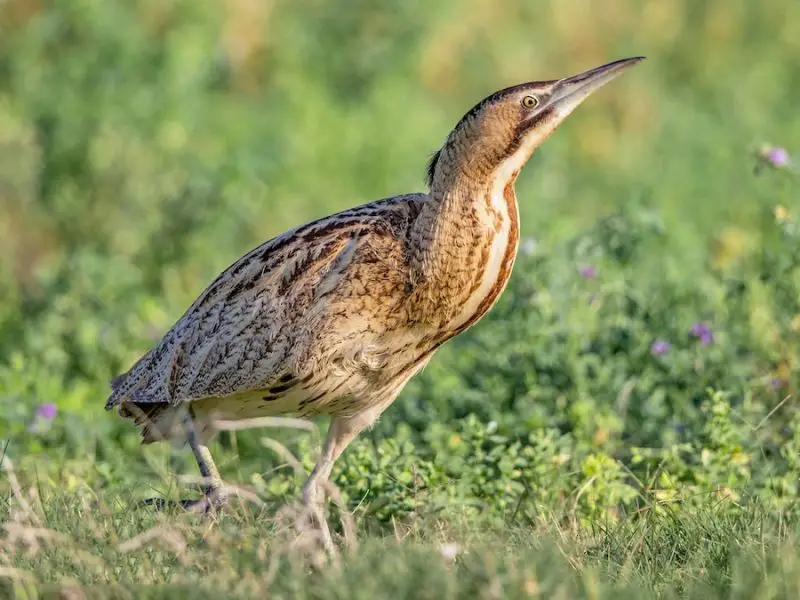
The Eurasian Bittern is a secretive, stocky heron-like bird with rich brown, streaked plumage that camouflages perfectly among reeds. Its stout body and upward-pointing bill give it a distinctive posture, especially when trying to blend into tall vegetation.
Bitterns inhabit reed beds and freshwater marshes across Europe and parts of Asia. They are most active during dusk and dawn, feeding on fish, amphibians, insects, and small mammals. During the breeding season, the male produces a deep, booming call that can carry over long distances.
A fascinating fact about the Eurasian Bittern is its unique camouflage behavior—when threatened, it freezes with its bill pointing upward and sways slightly to mimic reed stems in the wind. This “bitterning” pose makes it nearly invisible to predators and humans alike.
Eurasian Oystercatcher
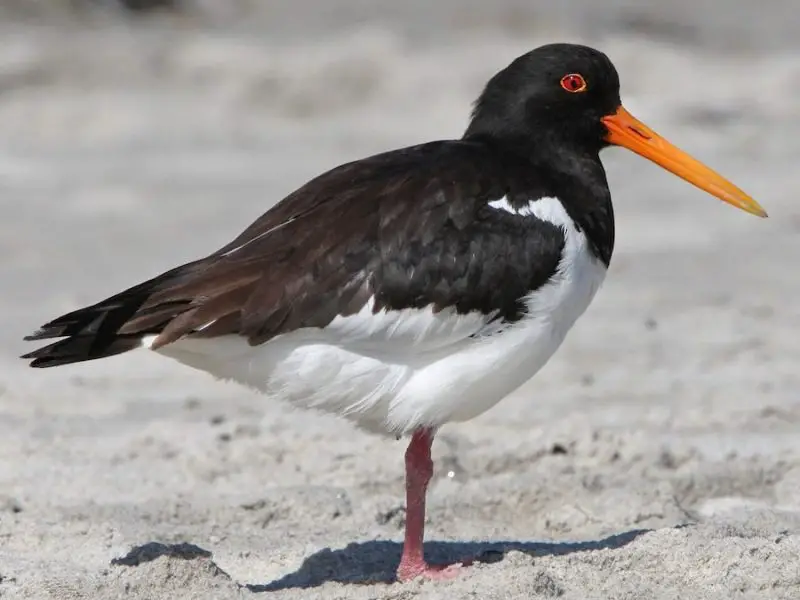
The Eurasian Oystercatcher is a bold black-and-white shorebird with a long, bright orange bill and matching legs. Its loud, piping calls are a familiar sound along rocky and sandy coasts. The bill is specially adapted for prying open shellfish like mussels and oysters.
It is found along coastlines, estuaries, and occasionally inland near rivers and lakes throughout Europe and parts of Asia. Oystercatchers nest on the ground, often in open areas with minimal vegetation, and both parents care for the chicks.
A fun fact is that Eurasian Oystercatchers show individual variation in feeding technique—some specialize in hammering shells open, while others pry them apart. These behaviors are passed down from parent to chick, showcasing a form of cultural learning in birds.
Eurasian Dotterel
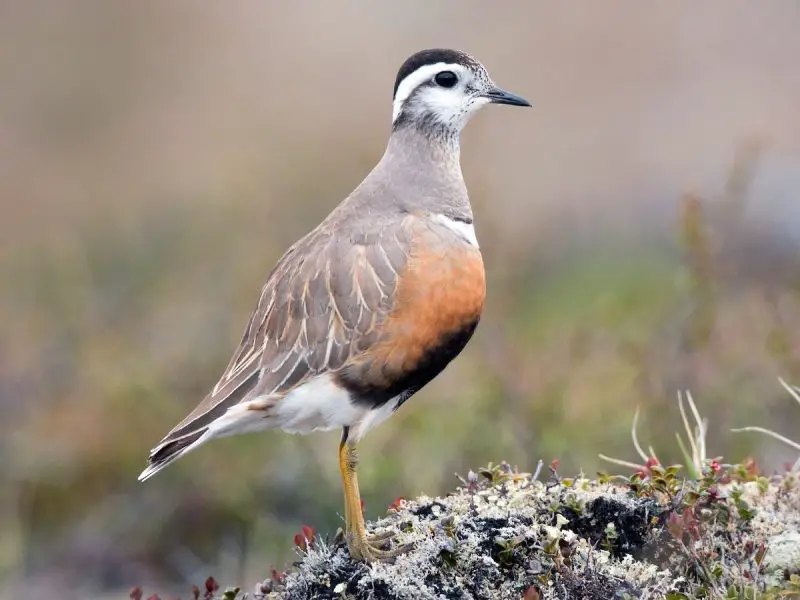
The Eurasian Dotterel is a small, elegant wader with a distinctive appearance during the breeding season. It has a warm brown breast, a white belly, and a bold white stripe above the eye that contrasts with its otherwise cryptic coloration. Interestingly, females are more brightly colored than males—a reversal of the norm in birds.
This bird breeds in high-altitude tundra and mountainous regions across northern and central Eurasia, especially in Scotland, Norway, and parts of Russia. It prefers open, stony ground where it can blend into the environment. During migration, it stops over in lowland fields and coastal areas.
A fascinating behavior of the Eurasian Dotterel is its reversed roles in parenting—males are responsible for incubating the eggs and caring for the chicks, while females may mate with multiple males. This rare behavior among birds has made it a subject of scientific interest.
Eurasian Woodcock
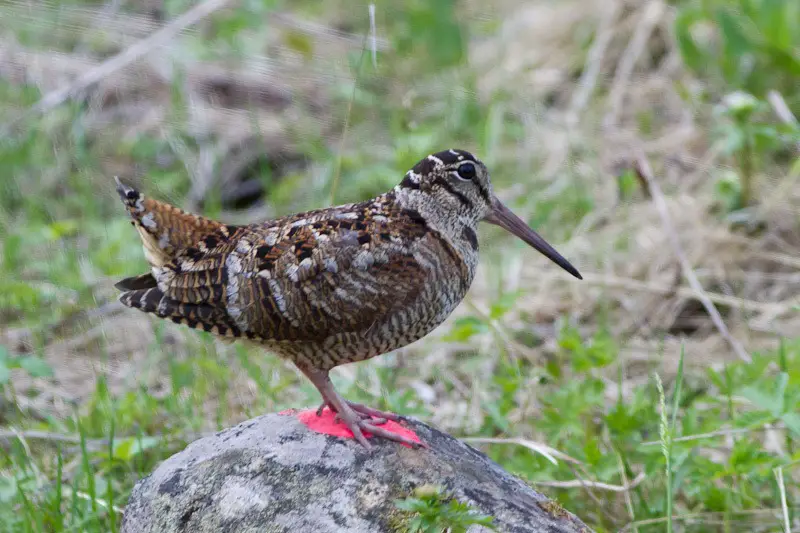
The Eurasian Woodcock is a chunky, well-camouflaged woodland bird with a long, straight bill and intricately patterned brown plumage. Its large eyes are set high on the head, providing nearly 360-degree vision to detect predators.
It is primarily found in dense forests, woodlands, and thickets across Europe and Asia. Woodcocks are secretive and nocturnal, feeding at night on earthworms, insects, and larvae by probing the soil with their bill. During the breeding season, males perform a dramatic aerial display known as “roding.”
An unusual fact about the Eurasian Woodcock is that it can carry its chicks short distances by holding them between its legs as it flies. This rare behavior is believed to help protect vulnerable young from predators or danger.
Eurasian Nightjar
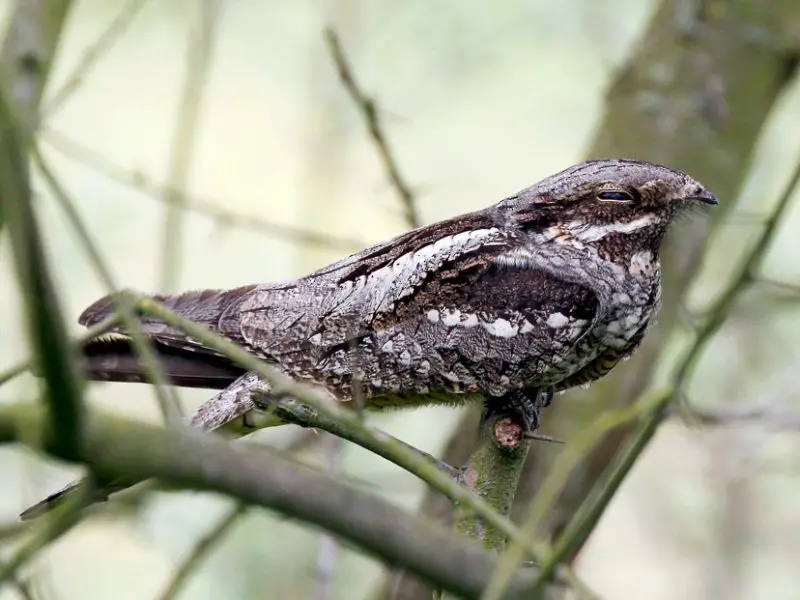
The Eurasian Nightjar is a nocturnal bird with cryptic, bark-like plumage that blends seamlessly into forest floors and tree branches. It has a small bill but a large gape, which helps it catch flying insects at night. Its silent flight and haunting “churring” call are hallmarks of summer evenings.
It inhabits heathlands, open woodlands, and scrubby areas throughout Europe, Asia, and parts of North Africa, migrating to sub-Saharan Africa for the winter. During the day, it roosts motionless on the ground or along tree branches, relying on camouflage for protection.
A unique fact about the Eurasian Nightjar is that it feeds almost entirely on moths and beetles, which it catches mid-flight using its wide mouth and bristle-fringed beak. It is also known for its erratic, bat-like flight pattern.
Eurasian Hobby
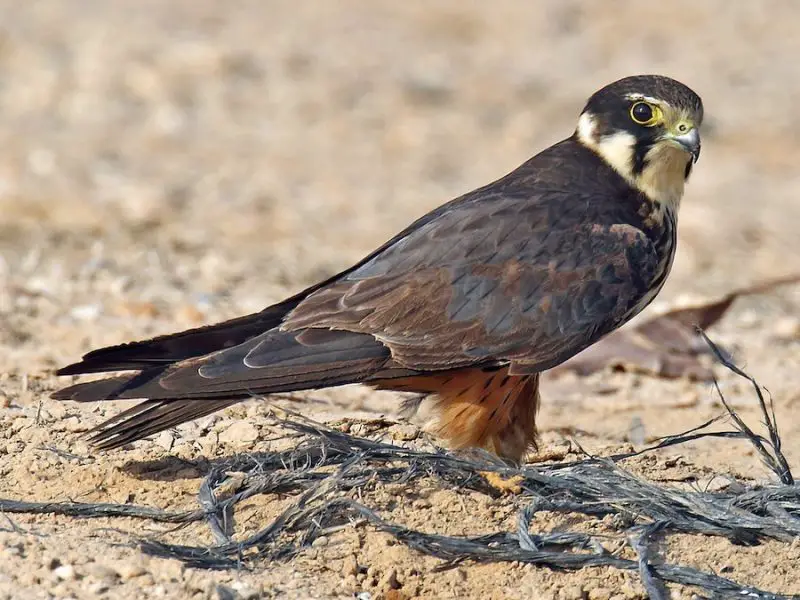
The Eurasian Hobby is a sleek, fast-flying falcon known for its acrobatic flight and agile hunting style. It has long, pointed wings, a dark back, and contrasting red “trousers” on its underparts. Its white face and dark moustache stripe give it a distinctive falcon look.
This bird breeds across Europe and Asia, favoring open woodlands, forest edges, and wetlands, and migrates to Africa and southern Asia for the winter. It often hunts on the wing, preying on dragonflies, swallows, and other small birds.
One impressive trait of the Eurasian Hobby is its ability to catch and consume prey mid-air. It can even transfer food from its talons to its beak while flying—a remarkable display of aerial coordination and speed.
Eurasian Kestrel
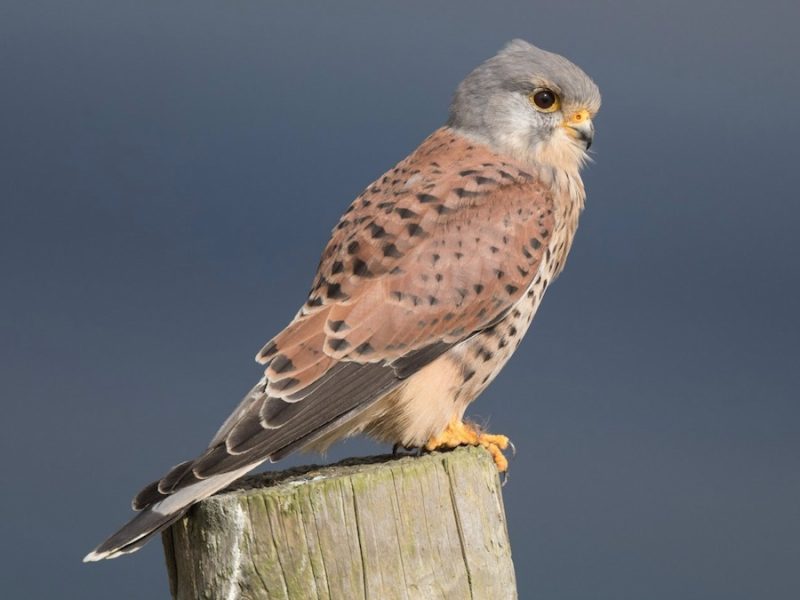
The Eurasian Kestrel is a small and widespread falcon recognized for its habit of hovering mid-air while scanning the ground for prey. Males typically have a gray head and tail with a rust-colored back, while females are browner and more streaked.
It is found across Europe, Asia, and North Africa in a wide variety of open habitats including farmland, moorlands, and even urban areas. The kestrel primarily feeds on small mammals, insects, and occasionally small birds.
A fascinating behavior of this raptor is its ability to hover in place using rapid wing beats while keeping its head perfectly still to focus on prey below. This “wind-hovering” technique allows it to detect movement and strike with precision.
Eurasian Buzzard
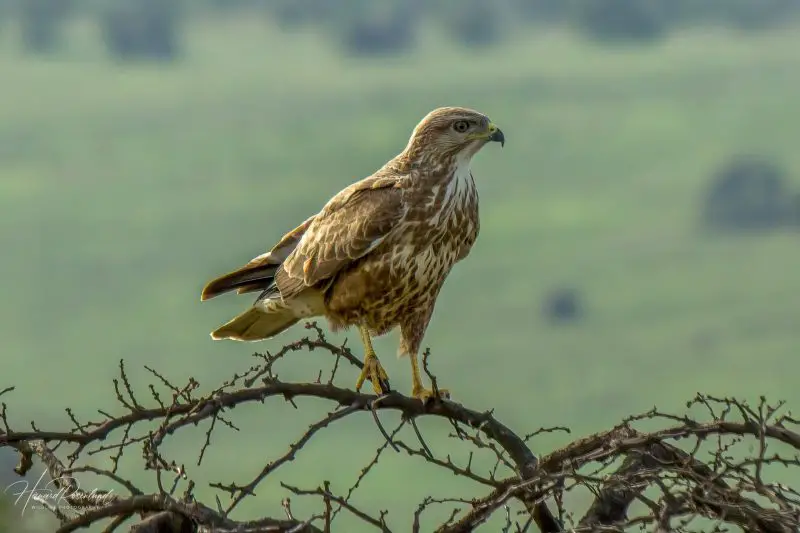
The Eurasian Buzzard is a medium-sized raptor with broad wings, a short neck, and a wide variety of plumage colors ranging from dark brown to pale cream. Its mewing call is often compared to a cat’s cry and can be heard echoing over hills and fields.
This bird occupies a broad range across Europe and western Asia, inhabiting forests, farmland, and upland moors. It is highly adaptable, often seen soaring in thermals or perched on fence posts scanning for small mammals, carrion, and reptiles.
A remarkable fact about the Eurasian Buzzard is its increasing presence in urban areas and its ability to thrive despite human development. Its diet is so versatile that it can switch from live prey to scavenging, allowing it to survive in diverse conditions.
Eurasian Goshawk

The Eurasian Goshawk is a large, powerful bird of prey with broad wings, a long tail, and striking orange or red eyes. It has a slate-gray back and finely barred underparts, giving it a sharp, fierce appearance. As an apex forest predator, it is often stealthy and elusive in its movements.
Goshawks inhabit mature woodlands and forests across Europe and Asia, where they use their agility and speed to chase down prey among the trees. They feed on birds such as pigeons and crows, as well as small mammals like squirrels and hares. Their strong talons and beak allow them to dispatch prey quickly.
A fascinating fact about the Eurasian Goshawk is that it has been used for centuries in falconry due to its strength and determination. Known as the “cook’s hawk” in old times, it was prized for its ability to hunt game birds for the table.
Eurasian Pygmy Owl

The Eurasian Pygmy Owl is the smallest owl species in Europe, measuring only about 6–7 inches in length. Despite its tiny size, it has a large head, piercing yellow eyes, and a fierce attitude. Its plumage is a mix of grayish-brown with white spotting on the head and body.
It lives in coniferous forests throughout northern and central Europe and parts of Asia, often nesting in old woodpecker holes. The owl is active during the day, especially at dawn and dusk, and feeds primarily on small birds, mice, and insects, which it hunts with silent flight.
A remarkable behavior of the Eurasian Pygmy Owl is its habit of storing surplus prey by impaling it on branches or stuffing it into tree cavities. This helps it survive during harsh winter months when food is scarce.
Eurasian Scops Owl
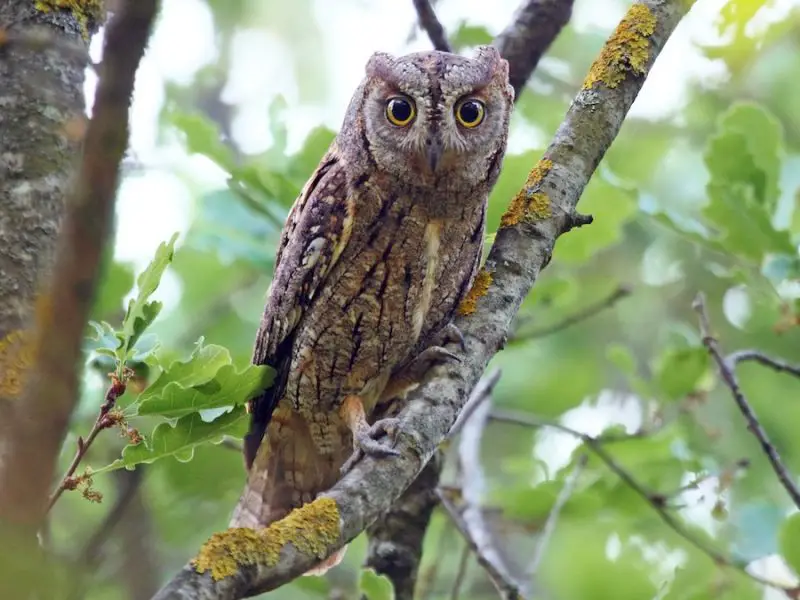
The Eurasian Scops Owl is a small, cryptically colored owl with grayish or brown plumage that helps it blend seamlessly into tree bark. It has large yellow eyes and small ear tufts, and its body is slender compared to other owls.
This owl prefers warm, open woodlands, groves, and orchards throughout southern Europe, the Middle East, and parts of Central Asia. It is a migratory species that winters in Africa. It is nocturnal and feeds on insects, especially moths and beetles, which it captures in mid-air or on the ground.
An interesting fact about the Eurasian Scops Owl is its distinctive call—a soft, rhythmic “kew” that it repeats every few seconds. This vocalization is often the only clue to its presence, as it remains well-hidden during the day.
Eurasian Tawny Owl
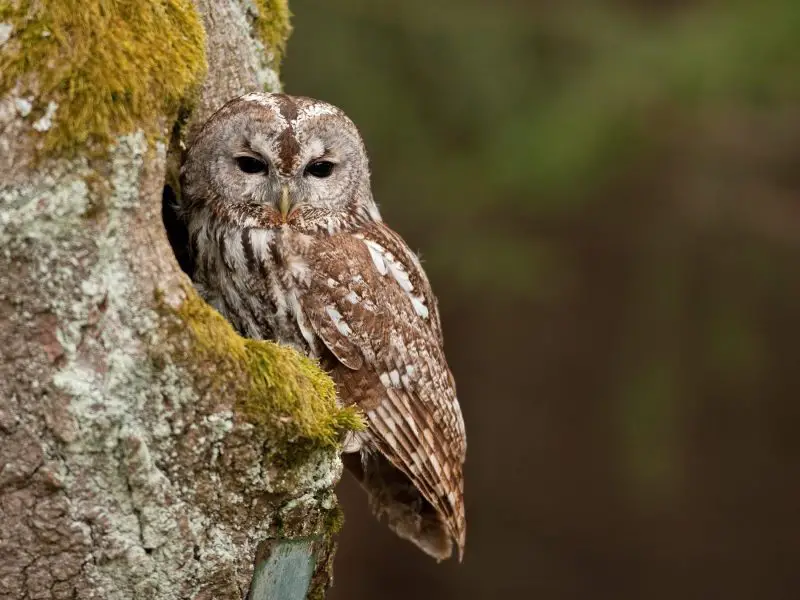
The Eurasian Tawny Owl is a medium-sized, stocky owl with a rounded head, no ear tufts, and large dark eyes. Its plumage varies from reddish-brown to grayish-brown, all streaked and mottled to provide camouflage in woodland environments.
It is widespread across Europe and parts of western Asia, favoring deciduous and mixed forests, parks, and even suburban gardens. Tawny owls are strictly nocturnal and feed on rodents, birds, insects, and amphibians. They are known for their haunting and iconic “hoo-hoo” calls, especially heard during the night.
A fascinating fact about the Eurasian Tawny Owl is that once it establishes a territory, it typically stays there for life. This strong territorial instinct has even led to documented cases of owls attacking intruders, including humans, near their nests.
Eurasian Long-eared Owl
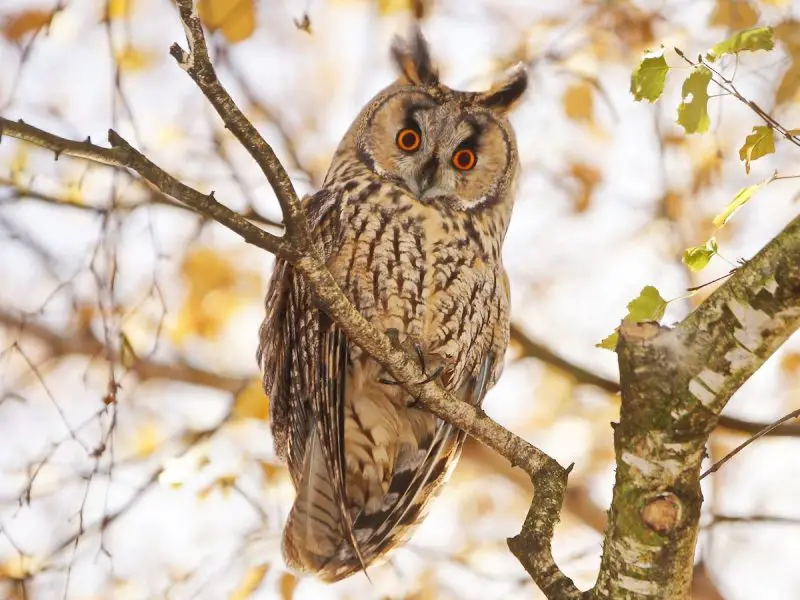
The Eurasian Long-eared Owl is a slender owl with long, upright ear tufts and piercing orange eyes. Its plumage is mottled with shades of brown, black, and cream, allowing it to blend perfectly into coniferous trees during daylight roosts.
This owl is found across Europe and Asia in woodlands near open hunting grounds such as meadows and grasslands. It is mostly nocturnal and preys primarily on small mammals like voles and mice, using its excellent hearing and silent flight to locate them in the dark.
One remarkable aspect of the Eurasian Long-eared Owl is its communal roosting behavior during winter. Dozens of individuals may gather in the same tree, sometimes even in urban parks, where their camouflage makes them difficult to spot.
Eurasian Short-eared Owl
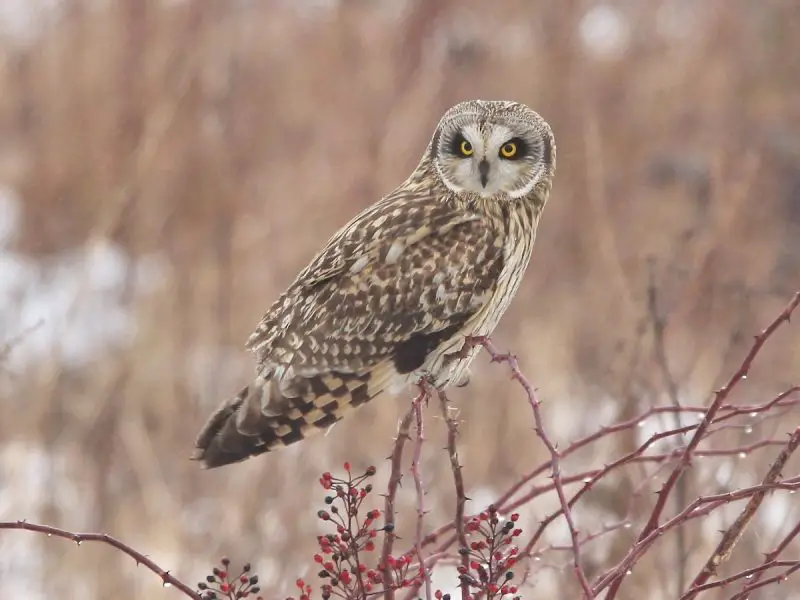
The Eurasian Short-eared Owl is a medium-sized owl with short, often barely visible ear tufts and bright yellow eyes surrounded by a dark rim. It has buff-colored plumage with heavy streaking and mottling, making it well-suited to open habitats.
Unlike most owls, this species is active both during the day and night, especially around dawn and dusk. It inhabits grasslands, marshes, and tundra across Europe, Asia, and North Africa. It hunts by flying low over the ground, searching for small mammals such as voles.
A fascinating trait of the Eurasian Short-eared Owl is its global distribution—it’s one of the most widespread owls in the world. Its breeding behavior includes aerial displays and wing-clapping, adding to its distinctiveness during the mating season.
Eurasian Little Owl

The Eurasian Little Owl is a small, compact owl with a flat-topped head, bright yellow eyes, and a fierce expression. Its plumage is a mix of brown and white with streaks and spots that provide effective camouflage against tree bark or rocky surfaces. Despite its small size, it is bold and territorial.
This owl is native to Europe, North Africa, and parts of Asia. It prefers open countryside with scattered trees, farmlands, orchards, and even human settlements. The Little Owl is active at dawn and dusk, hunting insects, small birds, and rodents from perches like fence posts or rocks.
An interesting fact about the Eurasian Little Owl is its cultural significance—often associated with wisdom and the goddess Athena in ancient Greece. It also has a wide vocal range, with calls that can sound like chirps, whistles, or even cat-like meows.
Eurasian Barn Owl
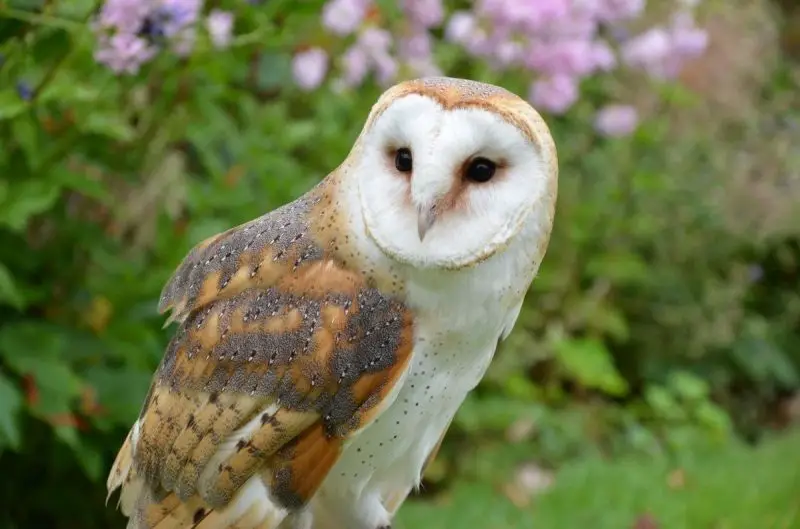
The Eurasian Barn Owl is instantly recognizable for its heart-shaped white facial disc, pale underparts, and golden-buff back. It has long legs and a graceful flight, gliding silently through the night. Its black eyes are set within a ghostly face, adding to its mysterious appearance.
This owl is found across Europe, Asia, and parts of Africa, preferring farmlands, grasslands, and open habitats with nearby barns or hollow trees for nesting. It feeds mainly on rodents like voles, rats, and mice, using its incredible sense of hearing to locate prey in total darkness.
A fascinating trait of the Eurasian Barn Owl is its almost completely silent flight, thanks to the specialized structure of its wing feathers. This allows it to hunt undetected and also makes it a symbol of mystery in folklore across many cultures.
Eurasian Kingfisher

The Eurasian Kingfisher is a small, vibrantly colored bird with electric blue and orange plumage, a long sharp bill, and a short tail. Its dazzling colors make it one of Europe’s most striking birds, often seen as a blur of blue darting over a stream.
It inhabits slow-moving rivers, lakes, and streams with clear water and abundant fish. Found across Europe and Asia, the kingfisher nests in burrows dug into sandy banks and is highly territorial. It feeds almost exclusively on small fish, which it catches by diving headfirst from a perch.
A fun fact about the Eurasian Kingfisher is that it has excellent binocular vision and a nictitating membrane that allows it to see underwater. Despite its beauty, it’s a secretive bird and can be surprisingly difficult to spot.
Eurasian Wryneck
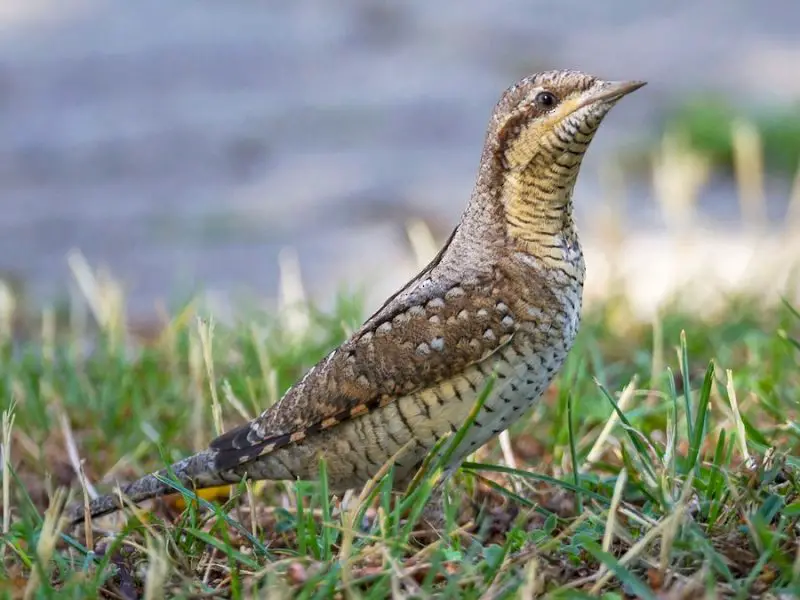
The Eurasian Wryneck is a curious member of the woodpecker family, notable for its snake-like neck movements and cryptic, bark-colored plumage. It has a mottled brown and gray body with a slender build, making it well-suited for blending into tree bark.
Wrynecks are found across Europe, Asia, and parts of Africa, favoring open woodlands, orchards, and parklands. Unlike most woodpeckers, they don’t drill into wood but instead nest in existing holes. They primarily eat ants and other insects, which they gather using a long, sticky tongue.
One fascinating behavior of the Eurasian Wryneck is its ability to twist its head in a snake-like fashion when threatened—hence the name “wryneck.” This behavior was once thought to have magical or eerie associations in folklore.
Eurasian Green Woodpecker
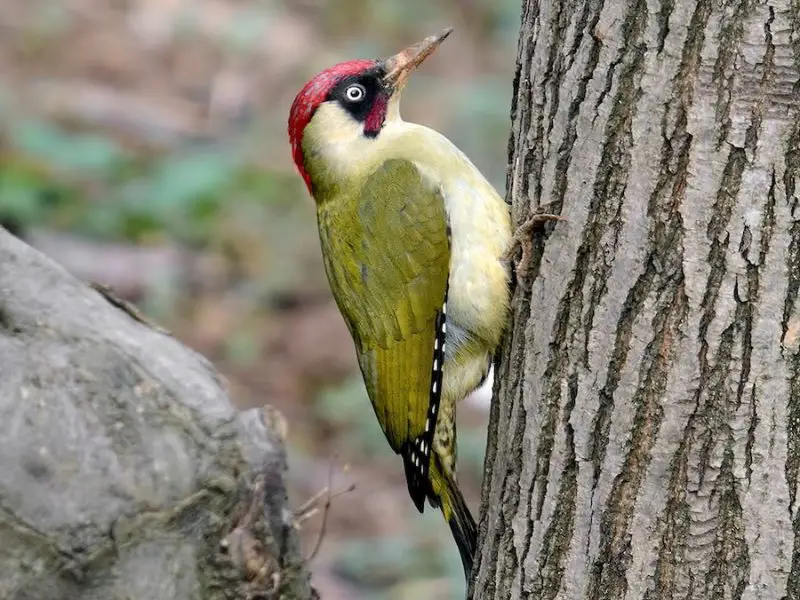
The Eurasian Green Woodpecker is a large woodpecker with a vivid green back, yellow rump, and a red crown. Its loud, laughing call—often described as a “yaffle”—is a familiar sound in the countryside.
This species is widespread across Europe and parts of western Asia. It prefers open deciduous woodlands, meadows, and gardens. Unlike other woodpeckers, it spends a lot of time on the ground feeding on ants, which make up the bulk of its diet.
A unique fact about the Eurasian Green Woodpecker is its specialized tongue—it can extend up to 10 cm and is covered with sticky saliva and barbs to help catch ants from deep tunnels. It rarely drums on trees, relying more on vocal communication.
Eurasian Three-toed Woodpecker
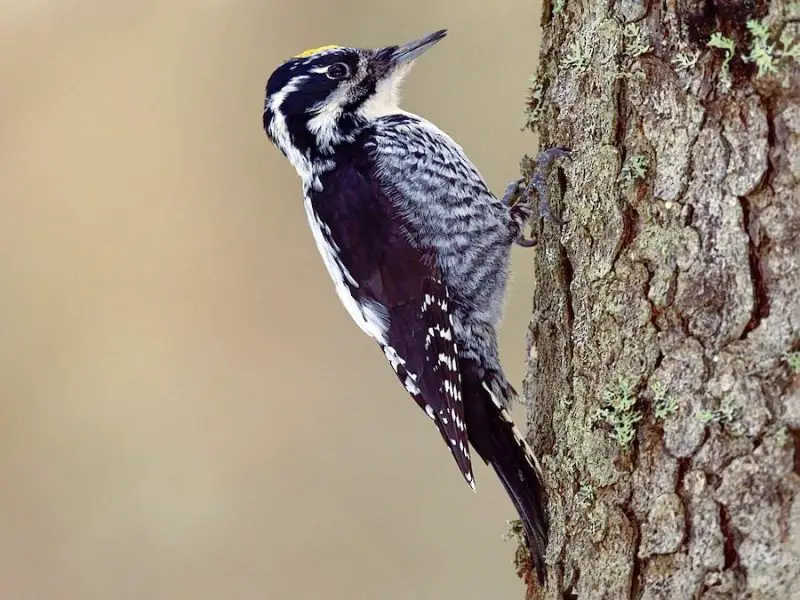
The Eurasian Three-toed Woodpecker is a medium-sized bird with a black-and-white body, white barring on the wings, and a yellow crown patch on males. As its name suggests, it has only three toes instead of the usual four, a rare trait among woodpeckers.
It inhabits boreal and montane coniferous forests across northern and central Europe and Asia. This woodpecker prefers old or decaying trees infested with wood-boring beetle larvae, which it excavates with its strong bill. It also feeds on ants, spiders, and other insects.
A fascinating fact about the Eurasian Three-toed Woodpecker is its role as an indicator species—its presence can signal the health of old-growth forests. It’s also remarkably quiet compared to other woodpeckers, relying more on drumming than vocal calls.
Eurasian Great Spotted Woodpecker

The Eurasian Great Spotted Woodpecker is a medium-sized bird with bold black and white plumage and striking red under-tail coverts. Males also have a red patch on the back of the head, while juveniles show a red crown. Its strong, chisel-like bill is perfect for drilling into trees.
This species is widespread across Europe and parts of Asia, inhabiting woodlands, parks, and gardens with mature trees. It feeds on insects hidden beneath bark, as well as seeds, nuts, and occasionally bird eggs or chicks. During winter, it may visit feeders in suburban areas.
One fascinating fact about the Eurasian Great Spotted Woodpecker is its drumming behavior—it creates rapid bursts of sound on tree trunks that serve as both territorial displays and communication signals. Each individual has a unique drumming rhythm.
Eurasian Lesser Spotted Woodpecker

The Eurasian Lesser Spotted Woodpecker is the smallest woodpecker in Europe, with black-and-white plumage and fine barring on the wings and back. Males feature a red crown, while females have an all-black head. Unlike its larger relatives, it has a dainty, more delicate appearance.
It favors deciduous woodlands, orchards, and riverside areas with dead or dying trees, which it uses for nesting and foraging. Found across much of Europe and parts of Asia, the bird feeds on wood-boring insects and larvae, using its small bill to tap into soft wood and bark.
Unlike other woodpeckers, the Lesser Spotted Woodpecker is quiet and elusive, often going unnoticed even when nearby. It rarely visits feeders and is often heard through its soft, high-pitched call or delicate drumming on slender branches.
Eurasian Black Woodpecker
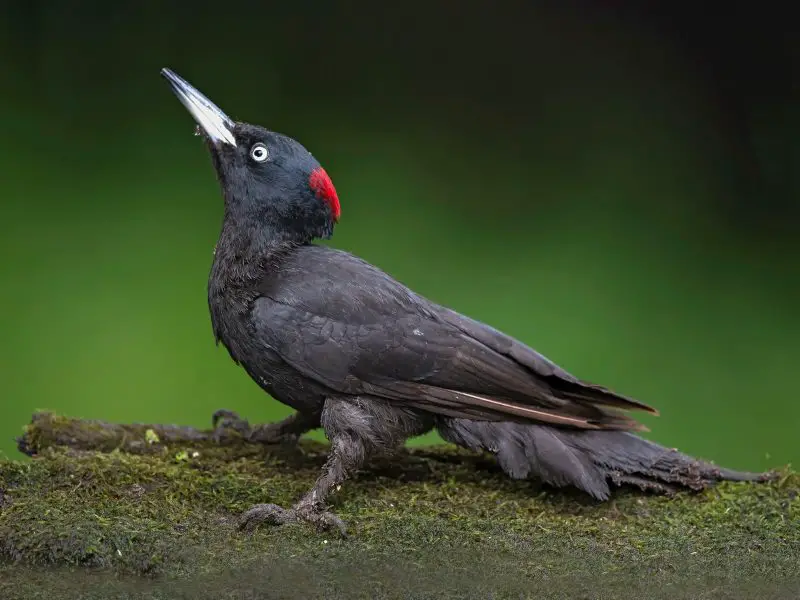
The Eurasian Black Woodpecker is the largest woodpecker species in Europe, notable for its all-black plumage and red crown—males have a full red cap, while females have a smaller red patch. Its strong, hammering call and loud drumming make it easy to detect in the forest.
This bird prefers dense coniferous or mixed forests across Europe and parts of Asia. It relies on large, mature trees for nesting and foraging, often carving deep holes in trunks to extract carpenter ants and wood-boring beetle larvae.
A remarkable trait of the Eurasian Black Woodpecker is its ability to create large, oval nest cavities that are later used by other forest creatures like owls, ducks, and bats. It plays a vital role in maintaining the biodiversity of forest ecosystems.
Eurasian Treecreeper

The Eurasian Treecreeper is a small, secretive songbird with a slender, curved bill and mottled brown upperparts that blend perfectly into tree bark. Its underparts are pale, and it has a long, stiff tail that helps it balance as it climbs tree trunks.
It lives in woodlands, parks, and gardens throughout Europe and temperate Asia. The treecreeper spirals up tree trunks in search of insects and spiders hiding in crevices, often starting from the base and working its way upward in a distinctive pattern.
One curious behavior of the Eurasian Treecreeper is its nesting habit—it builds its nest behind loose bark or in tree cavities, using moss, feathers, and twigs. Its elusive nature and excellent camouflage make it a challenge to spot despite its widespread range.
Eurasian Wren
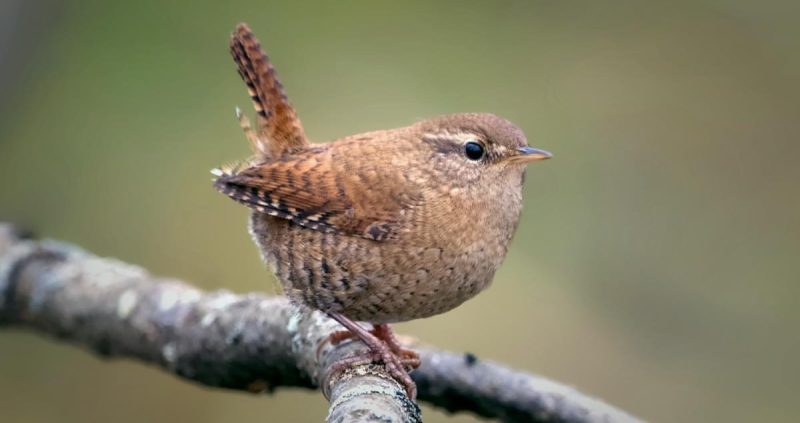
The Eurasian Wren is a tiny, round-bodied bird with a short tail often held upright, and a loud, bubbly song that belies its small size. Its brown plumage is streaked with fine barring, allowing it to blend into leaf litter and undergrowth with ease.
Wrens are found throughout Europe, Asia, and North Africa in woodlands, gardens, and hedgerows. They are active and agile, foraging for insects and spiders in low vegetation and crevices. Despite being shy, males sing energetically to defend territories.
A fun fact about the Eurasian Wren is its status as one of the loudest birds relative to body size. In folklore, it’s sometimes called the “king of birds” due to a fable in which it cleverly won a flight competition among birds.
Eurasian Dipper

The Eurasian Dipper is a robust, thrush-sized bird with a dark brown body and a contrasting white throat and chest. It is uniquely adapted for life along fast-flowing streams and rivers, where it can be seen bobbing up and down on rocks or logs.
This bird is widely distributed across Europe and western Asia, especially in upland regions. It feeds on aquatic invertebrates like insect larvae, which it catches by diving and walking underwater—an unusual trait for a passerine bird.
The Eurasian Dipper has special adaptations for its aquatic lifestyle, including dense plumage, nasal flaps, and a nictitating membrane over its eyes. Its presence is often an indicator of clean, well-oxygenated water, making it a symbol of healthy river ecosystems.
Eurasian Robin

The Eurasian Robin is a small, charming bird best known for its bright orange-red breast and face, contrasting with its brown upperparts and whitish belly. It has a round body, thin legs, and a curious, alert posture that makes it instantly recognizable across its range.
This robin is found throughout Europe, parts of western Asia, and North Africa, frequenting woodlands, gardens, parks, and hedgerows. It is a ground feeder, often hopping around leaf litter to find insects, worms, and berries, especially in colder months.
Eurasian Robins are famously bold and territorial. Males and females both defend their spaces year-round, singing a melodious, flute-like song. In British folklore, the robin is associated with Christmas and often appears on holiday cards and decorations.
Eurasian Blackbird

The Eurasian Blackbird is a common thrush species with glossy black plumage in males and warm brown tones in females. Males have a bright yellow-orange bill and eye ring, while females are more subtly colored and sometimes have faint speckles on the chest.
This adaptable bird is found across Europe, North Africa, and parts of Asia, thriving in woodlands, gardens, farmland, and urban areas. It feeds mainly on insects, earthworms, and berries, and is often seen hopping across lawns or scratching through mulch.
The Eurasian Blackbird is celebrated for its rich, fluting song, often heard at dawn and dusk, especially in spring. It sings from rooftops, treetops, or high branches, and its melodious phrases have made it a beloved part of the European soundscape.
Eurasian Song Thrush
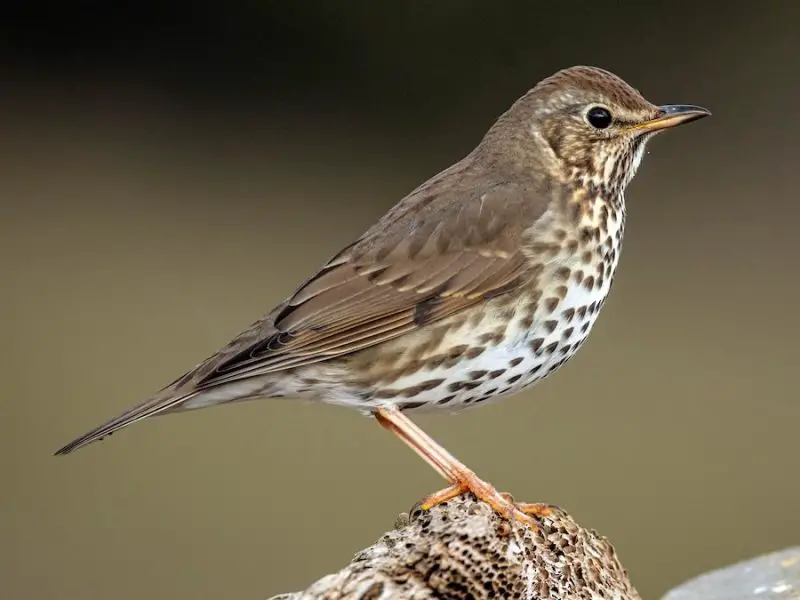
The Eurasian Song Thrush is a medium-sized songbird with warm brown upperparts and pale underparts heavily marked with dark arrow-shaped spots. It has a sturdy build, a short tail, and a powerful voice that can be heard over long distances.
This species is widespread across Europe, western Asia, and North Africa, living in woodlands, gardens, parks, and farmland. It primarily feeds on insects, snails, and fruits. Remarkably, it uses stones as “anvils” to break snail shells open—a distinctive behavior.
True to its name, the Song Thrush is a vocal marvel, repeating musical phrases two or three times with impressive clarity. Its varied, flute-like notes can be heard throughout the breeding season and are often described as uplifting and cheerful.
Eurasian Mistle Thrush
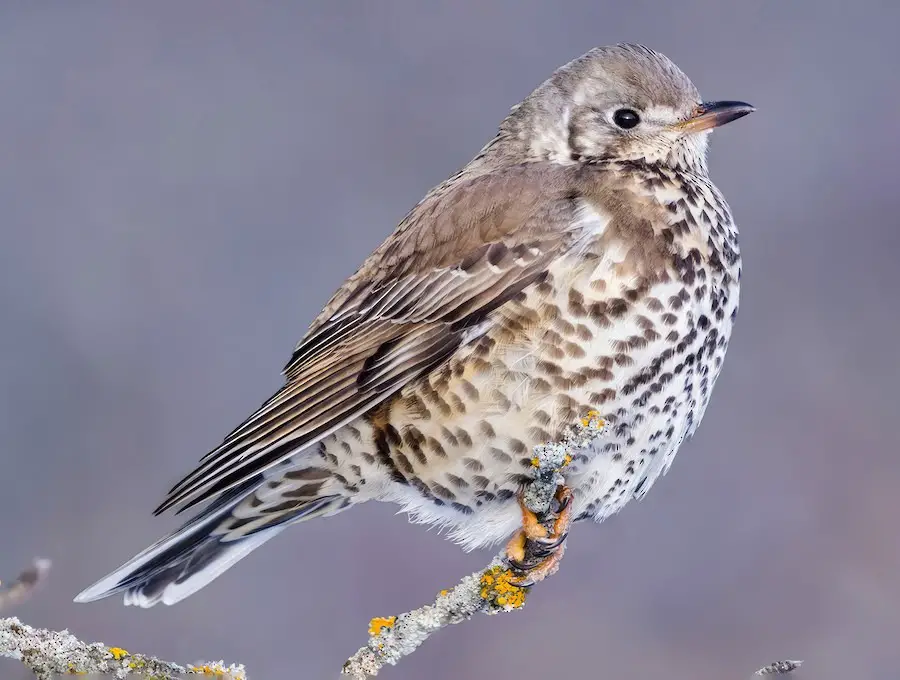
The Eurasian Mistle Thrush is a large thrush with gray-brown upperparts and a white belly covered in large, round black spots. It is more upright and long-legged than other thrushes, giving it a somewhat stately appearance when foraging or perched.
This bird inhabits woodlands, open countryside, parks, and gardens across Europe and parts of Asia and North Africa. It feeds on invertebrates and berries—especially mistletoe, which is how it got its name. It is known to aggressively defend berry-rich trees in winter.
One of the Mistle Thrush’s most notable traits is its powerful, far-carrying song, which it sings even during stormy weather, earning it the nickname “stormcock” in parts of Britain. Its melancholic yet bold song often rings out from the tops of tall trees.
Eurasian Fieldfare
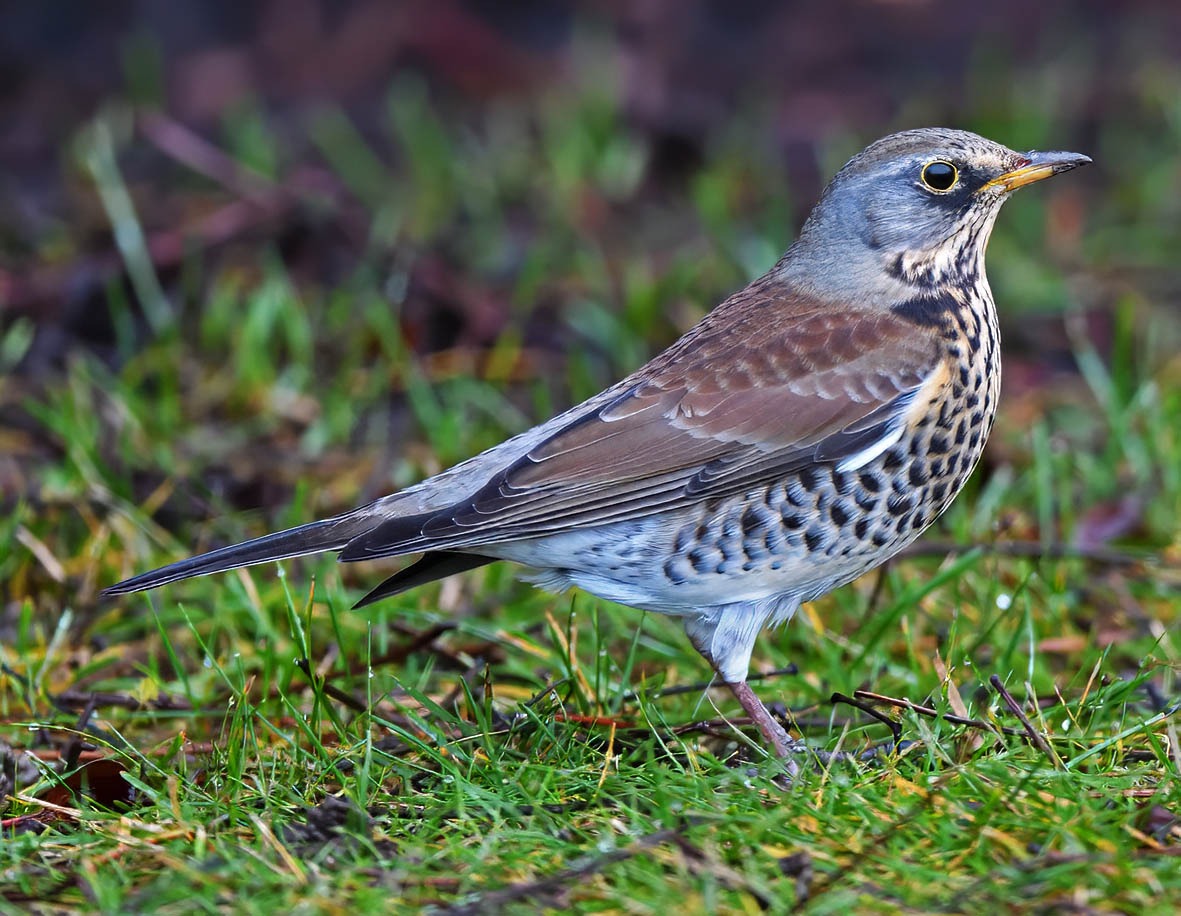
The Eurasian Fieldfare is a striking thrush with a gray head and rump, chestnut-brown back, and heavily spotted underparts. Its long tail and bold markings make it easy to distinguish from other thrushes, especially in winter flocks.
Fieldfares breed in northern Europe and migrate southward in winter, forming large, noisy flocks that descend on open fields, orchards, and hedgerows. They feed on berries, fallen fruit, and invertebrates, especially earthworms in thawed ground.
Unlike many thrushes, Fieldfares are social, roosting and feeding in groups. When threatened, they may mob predators with loud chattering calls and even defecate on them to drive them away—a rather unusual and effective defensive tactic.
Eurasian Redwing

The Eurasian Redwing is a small thrush easily recognized by the bold creamy stripe above its eye and the reddish-orange flanks and underwing. Its back is brown, and its belly is pale with distinct streaking across the chest and sides.
Redwings breed in northern Europe and Asia but migrate southward in large flocks to spend the winter in milder parts of Europe. They are often found in fields, woodlands, and gardens, especially where there are berry-laden shrubs and trees.
Their fluting, high-pitched flight call is often heard on crisp autumn nights as they migrate overhead. Though shy and elusive, they play a vital role in seed dispersal and are a welcome sight for birdwatchers during the colder months.
Eurasian Bluethroat

The Eurasian Bluethroat is a striking, small songbird known for the vivid blue patch on its throat, often bordered with white, rust, or black depending on the subspecies. Males are particularly colorful, while females are more subdued with brownish-gray tones and pale undersides.
This bird inhabits wetlands, thickets, and damp meadows across northern and central Europe and into Asia. During breeding season, it prefers reed beds and willow scrub, while in migration it can be found in gardens and coastal areas. It forages on insects and spiders, occasionally taking berries.
Eurasian Bluethroats are celebrated for their complex and melodious song, which includes mimicry of other birds. Males often sing from prominent perches and perform short, fluttering display flights to attract females. Their vivid appearance and lively song make them a favorite among birdwatchers.
Eurasian Stonechat

The Eurasian Stonechat is a compact, upright bird with a bold, contrasting appearance. Males feature a black head, white neck patch, orange-red breast, and mottled brown back. Females are more muted but still display a similar color pattern in softer tones.
This species is found across Europe, North Africa, and parts of Asia, inhabiting heathlands, grasslands, and coastal scrub. It prefers open areas with low vegetation, often perching on fences, bushes, or tall weeds to scan for insects, which make up the bulk of its diet.
Stonechats are territorial and often communicate with a sharp, “chatting” call that resembles two stones being knocked together—hence the name. They are active and inquisitive birds, constantly flicking their tails and moving about in short, jerky flights.
Eurasian Whinchat
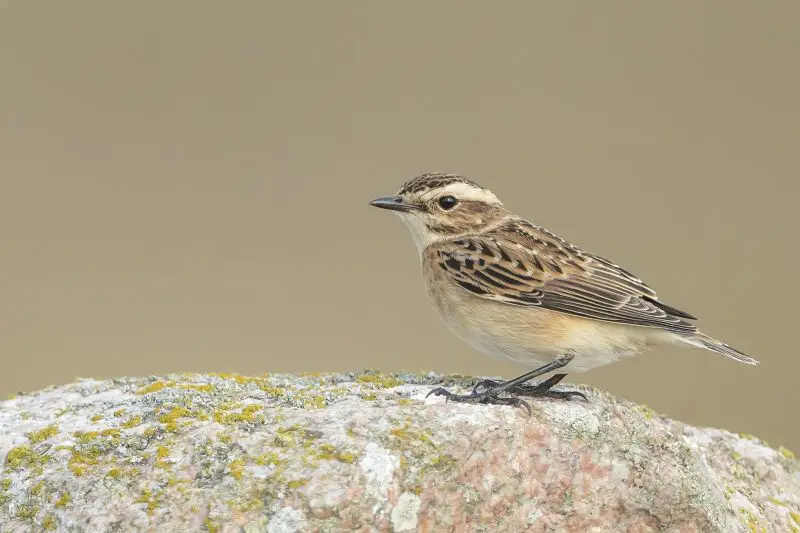
The Eurasian Whinchat is a small migratory songbird with a distinct pale eye stripe, orange-buff breast, and streaked brown back. It also has white patches at the base of its tail that are visible in flight, aiding identification.
Whinchats breed across Europe and western Asia, favoring open countryside, meadows, and grassy clearings with scattered shrubs. In winter, they migrate to sub-Saharan Africa. They primarily eat insects and small invertebrates, darting from perches to catch prey on the ground.
These birds are known for their alert behavior and melodic song, often delivered from a prominent perch. During the breeding season, males perform fluttering display flights to establish territory and attract mates. Their cheerful presence adds charm to summer fields.
Eurasian Wheatear

The Eurasian Wheatear is a small, ground-dwelling bird with a gray back, black wings, and a distinctive white rump and black-tipped tail. Males have a pale orange chest and a black mask across the eyes, while females are more subtly colored.
This widespread species breeds across Eurasia and northern Africa and migrates to sub-Saharan Africa for the winter. It favors open, rocky terrain, moorlands, coastal cliffs, and pastures, often nesting in crevices, burrows, or even old stone walls.
Eurasian Wheatears are active and agile insect hunters. They run or hop across the ground in search of prey and often return to the same lookout point. Their name comes from the old English “white-arse,” referencing their prominent rump patch seen in flight.
Eurasian Blackcap

The Eurasian Blackcap is a sleek, warbler-like bird with olive-gray plumage and a distinctive cap—black in males and rusty-brown in females. Its rounded body and neat appearance make it easily distinguishable among other woodland birds.
It is commonly found in woodlands, gardens, and hedgerows across Europe and parts of North Africa and western Asia. Blackcaps feed mainly on insects and fruits, particularly berries, and are known to visit bird feeders in winter in milder climates.
Blackcaps are famous for their beautiful, fluting song, often likened to that of a nightingale. Males sing prominently during the breeding season to claim territory and attract mates. These birds have adapted well to suburban environments and have even changed their migratory patterns in recent decades.
Eurasian Garden Warbler

The Eurasian Garden Warbler is a small, plain-looking bird with brownish-gray upperparts and a lighter underbelly. It lacks distinctive markings, which makes it harder to identify compared to more colorful songbirds, but it is known for its rich, melodic song.
Garden warblers breed throughout Europe and western Asia and winter in sub-Saharan Africa. They prefer deciduous woodlands, forest edges, thickets, and large gardens with dense undergrowth. Their diet consists of insects, spiders, and soft fruits.
Despite its nondescript appearance, the garden warbler is a skilled vocalist, producing long, sweet, and complex songs that rival those of better-known songbirds. Its song is one of the best clues to its presence, as the bird often stays hidden among thick vegetation.
Eurasian Chiffchaff
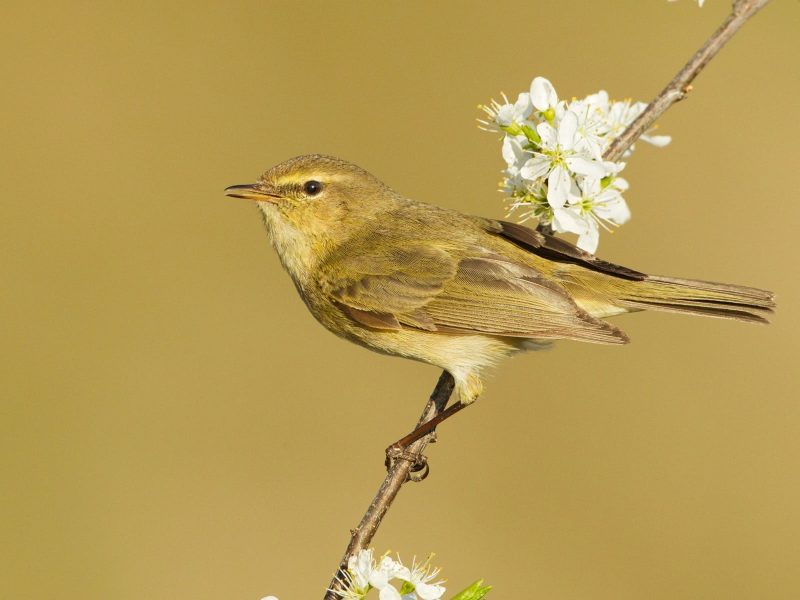
The Eurasian Chiffchaff is a small, olive-brown warbler with a pale underside and a faint, creamy eye stripe. Though visually similar to other warblers, it is most easily identified by its repetitive “chiff-chaff” song, which gives the bird its name.
Chiffchaffs are widespread across Europe and western Asia, favoring woodlands, scrublands, parks, and gardens, especially those with dense undergrowth. They are migratory, wintering in southern Europe, North Africa, and parts of Asia. They feed mainly on insects and small invertebrates, catching them mid-air or picking them from foliage.
These birds are active and agile, often flicking their wings and tail as they forage. Males sing persistently during spring to establish territory and attract mates. Though inconspicuous in appearance, their song is one of the earliest signs of spring across their range.
Eurasian Willow Warbler
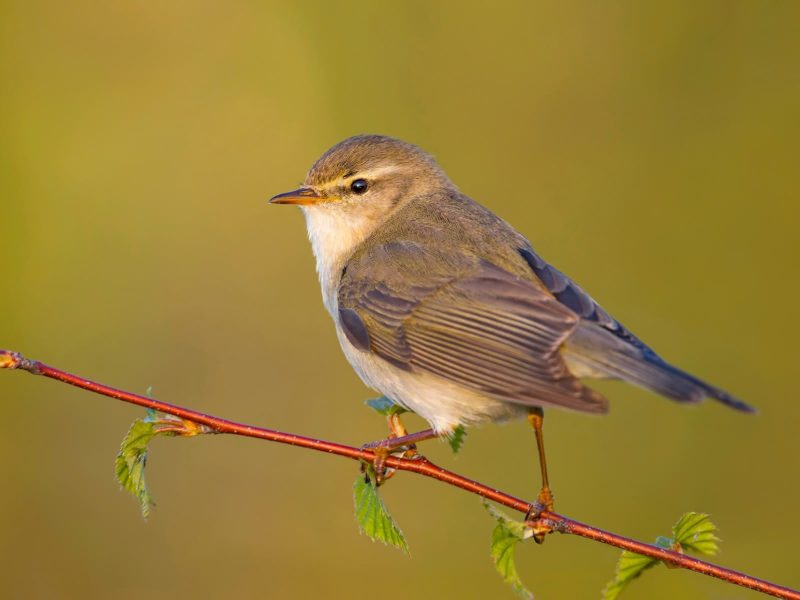
The Eurasian Willow Warbler is a graceful, pale greenish warbler with a yellowish underside and a distinct pale eyebrow stripe. It closely resembles the chiffchaff but has paler legs and a more melodious, descending song.
This bird breeds across much of Europe and Asia, particularly in young forests, willow thickets, and scrubby habitats. It migrates to sub-Saharan Africa for the winter, undertaking one of the longest migrations of any small bird. It feeds on insects, spiders, and sometimes berries.
Willow warblers are known for their sweet, cascading song and gentle behavior. During migration and breeding, they can be seen hopping delicately through branches, often pausing to sing. They play an important role in controlling insect populations in their breeding territories.
Eurasian Wood Warbler
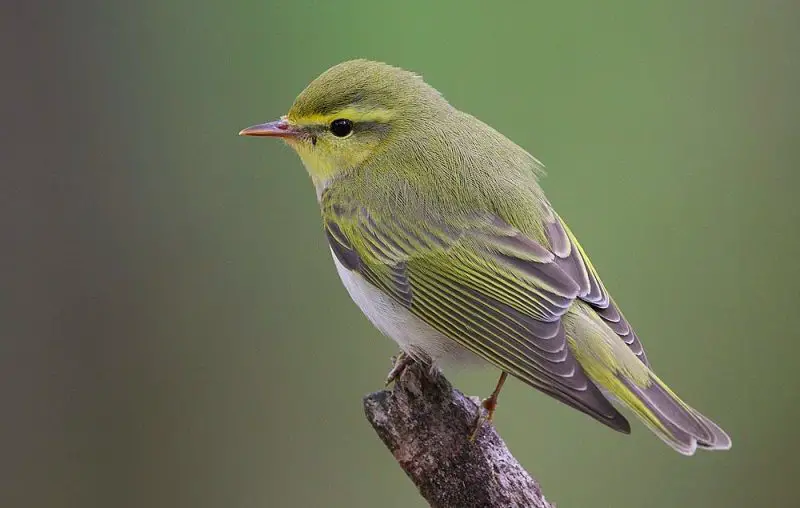
The Eurasian Wood Warbler is a striking warbler with bright yellow underparts, greenish upperparts, and a clean white belly. Its large, dark eyes and sharp contrast between upper and lower body colors make it relatively easy to distinguish from other warblers.
This species breeds in mature deciduous woodlands across Europe and migrates to West Africa for the winter. It prefers forests with sparse undergrowth and a rich canopy, where it forages high in the trees for insects and other small arthropods.
Its song is a distinctive series of accelerating, descending notes that sound like a spinning coin coming to a rest. Wood warblers are less common than other European warblers, and their populations are declining in some regions due to habitat loss.
Eurasian Sedge Warbler
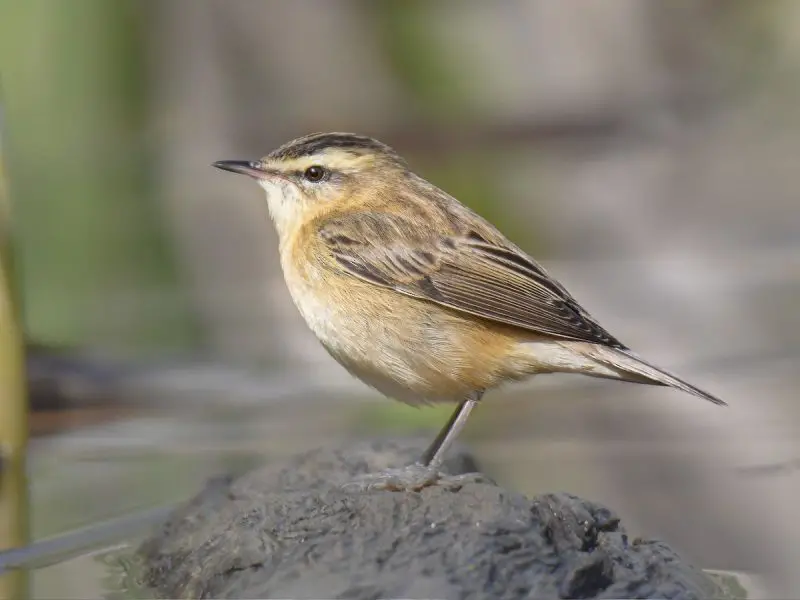
The Eurasian Sedge Warbler is a small, brown-streaked songbird with a prominent pale eyebrow and a short, slightly curved bill. Its plumage provides excellent camouflage in reedbeds and wetland vegetation where it resides.
It is found in marshes, reedbeds, and wet meadows throughout Europe and western Asia, migrating to sub-Saharan Africa for the winter. It feeds on a variety of insects, especially flies, beetles, and caterpillars, which it gleans from reeds and grasses.
Sedge warblers are known for their loud, energetic, and often improvisational song, incorporating mimicry of other birds. Males sing from high perches or during short, fluttering flight displays. They are highly territorial and energetic during the breeding season.
Eurasian Reed Warbler
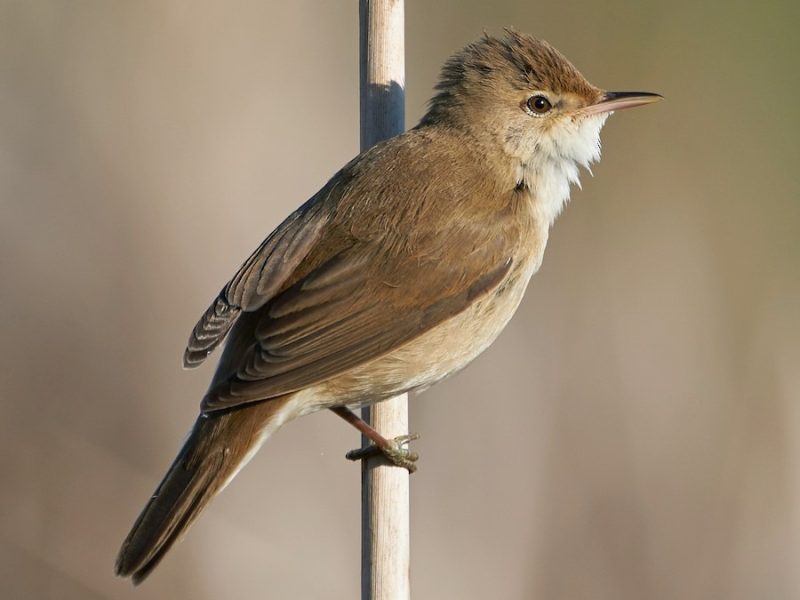
The Eurasian Reed Warbler is a plain, warm-brown bird with a pale buff underside and a pointed bill. Though visually unremarkable, it is well adapted to life in reedbeds and is more often heard than seen.
It breeds across Europe and western Asia in dense reedbeds along lakes, rivers, and wetlands. It winters in tropical Africa. This bird is insectivorous, catching insects and spiders among reeds and occasionally flying out to catch prey mid-air.
The reed warbler’s song is a rhythmic and repetitive series of chattering and scratching notes, often delivered from deep within reeds. Interestingly, this species is a common host for the parasitic Common Cuckoo, which lays its eggs in the reed warbler’s nest.
Eurasian Marsh Warbler
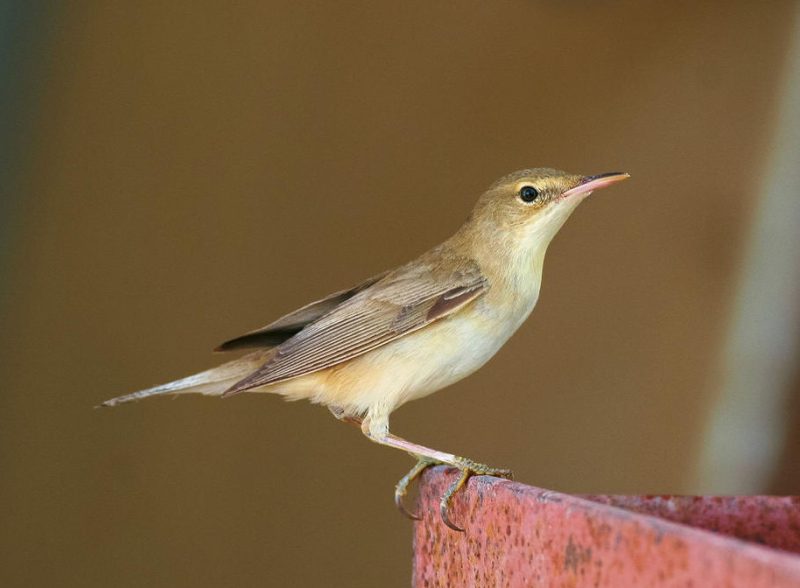
The Eurasian Marsh Warbler is a subtly-colored bird, with brown upperparts and a whitish underside. It looks similar to the reed warbler but has more rounded wings and a slightly more upright posture when perched.
This species prefers damp meadows, willow thickets, and tall herbaceous vegetation, often near rivers and streams. Its range spans central and eastern Europe and extends into parts of Asia, with wintering grounds in southeast Africa. It feeds on insects and occasionally berries.
Marsh warblers are celebrated for their extraordinary vocal mimicry. Males have a rich and varied song that includes imitations of dozens of other bird species, particularly those heard during migration. They are elusive and often stay hidden among tall grasses and shrubs.
Eurasian Grasshopper Warbler

The Eurasian Grasshopper Warbler is a small, elusive bird with brown-streaked plumage that blends perfectly into its grassy and shrubby surroundings. Its most distinctive feature is its long, insect-like song, which sounds remarkably like a grasshopper’s buzz, giving the species its name.
This warbler inhabits dense, damp vegetation such as reedbeds, overgrown meadows, and woodland edges across Europe and western Asia. It is migratory, spending the breeding season in temperate zones and wintering in parts of Africa and southern Asia. It forages for insects and spiders close to the ground, rarely showing itself openly.
Despite its secretive nature, the Grasshopper Warbler becomes most vocal at dawn and dusk during the breeding season. Males perform their reeling song from deep within cover, often without revealing their position. Their ability to remain hidden has made them a favorite among birdwatchers eager for a rare glimpse.
Eurasian Cetti’s Warbler
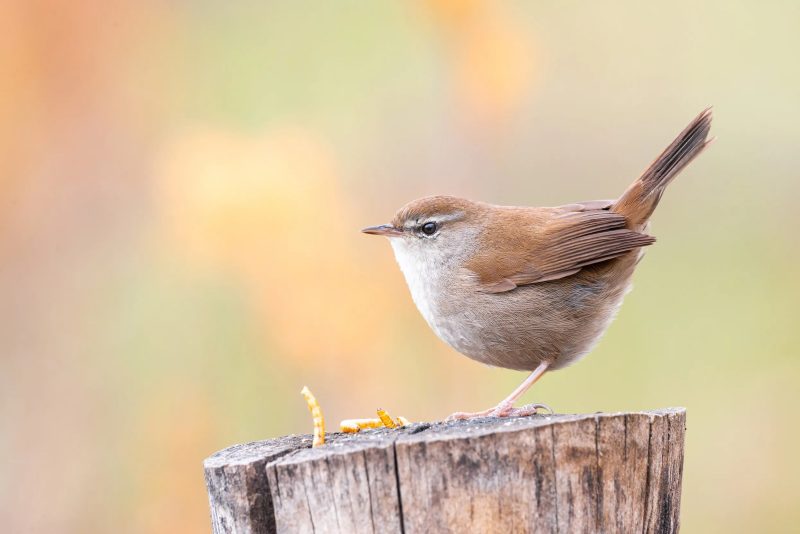
Cetti’s Warbler is a compact, rounded warbler with rich chestnut-brown plumage and a faint pale eyebrow. It has a short, rounded tail and a surprisingly loud, explosive song that echoes across wetland habitats where it resides.
Native to Europe, North Africa, and parts of western Asia, this bird favors dense, waterside vegetation such as brambles, reeds, and willows. Unlike many other warblers, Cetti’s Warbler is largely sedentary, enduring even cold winters in temperate climates. Its diet consists primarily of insects and other invertebrates.
Despite being difficult to see, it is often heard, as males deliver sharp bursts of song from hidden perches. They are territorial and active throughout the year, often darting quickly between dense patches of foliage. Their presence is often revealed only by their distinctive call.
Eurasian Bearded Tit
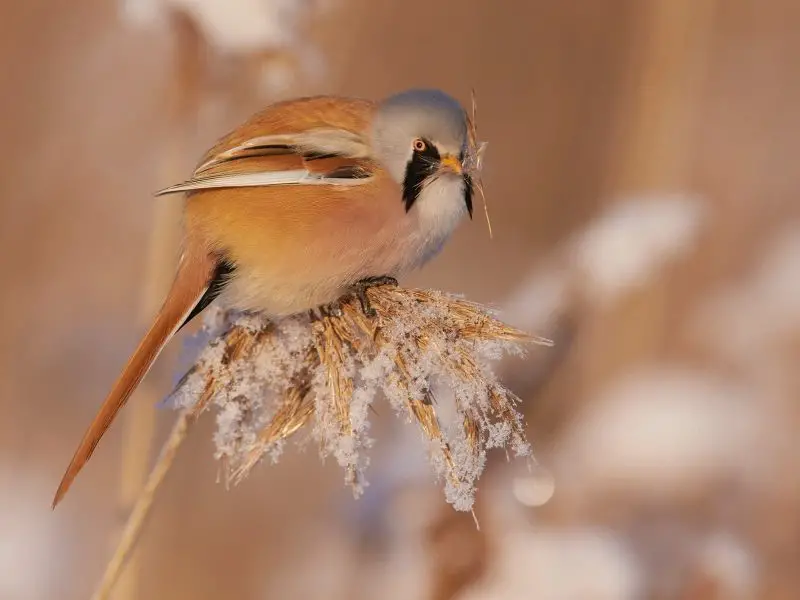
Also known as the Bearded Reedling, the Eurasian Bearded Tit is a striking small bird with a long tail and soft buff and grey plumage. Males sport a black “moustache” or “beard” on each side of their face, while females lack this feature but share the same elegant build.
These birds are residents of large reedbeds across Europe and central Asia, especially near freshwater marshes and lakes. They are highly adapted to life in reeds, where they climb and balance using their strong feet and long tails. In summer, their diet consists of insects, while in winter, they switch to seeds.
Bearded Tit is social and often seen in small, noisy flocks. Their soft “ping” calls can be heard echoing through reedbeds as they flit between stalks. Though they don’t migrate far, their populations can fluctuate depending on the harshness of winter and the availability of reed seed.
Eurasian Penduline Tit
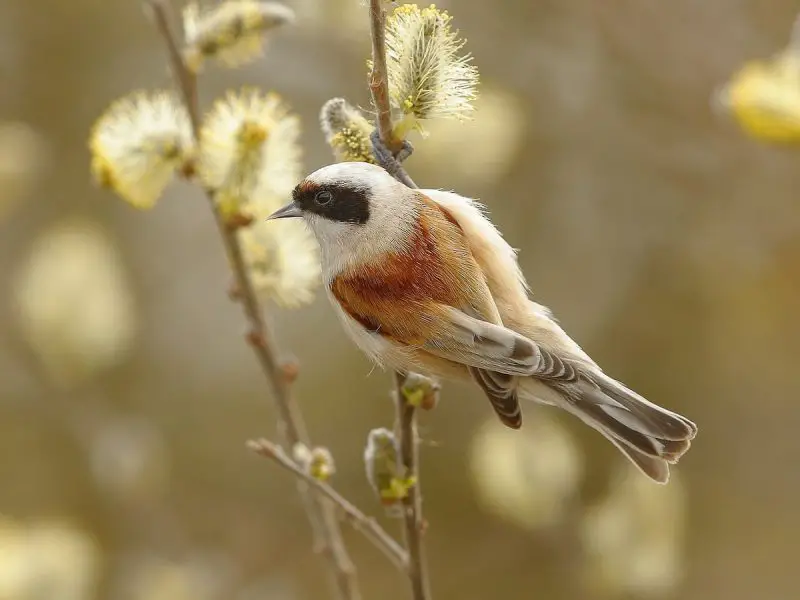
The Eurasian Penduline Tit is a delicate, acrobatic bird with a soft brown back, pale underparts, and a distinctive black mask across its face. Males and females look similar, although males tend to show brighter facial markings.
Penduline Tit prefers wetlands and riverbanks with willows, reeds, and tall grasses. Their range spans southern and central Europe, extending into parts of Asia. They are most famous for their intricately woven, hanging nests made of plant fibers and spider webs, suspended like pouches from thin branches.
These birds are mostly insectivorous and forage by clinging acrobatically to reeds and twigs. They are generally quiet outside the breeding season but become more vocal when nesting. Their nest-building skills are not only impressive but also play a major role in attracting mates.
Eurasian Long-tailed Tit

The Eurasian Long-tailed Tit is a small, fluffy songbird with a tiny, round body and a strikingly long, narrow tail—often longer than its body. Its plumage is soft white, pink, and black, giving it an endearing and almost toy-like appearance.
It lives in woodlands, hedgerows, and gardens across Europe and parts of Asia, forming tightly-knit family groups that forage together throughout the year. These birds feed mainly on insects, spiders, and sometimes seeds, scouring branches and twigs for prey with nonstop energy.
Long-tailed Tit is famous for their teamwork and cooperative nesting behavior. Their nests are carefully crafted from moss, feathers, and spider silk, camouflaged and durable. Outside of the breeding season, they roost communally to conserve heat during cold nights, huddling close on branches.
Eurasian Blue Tit
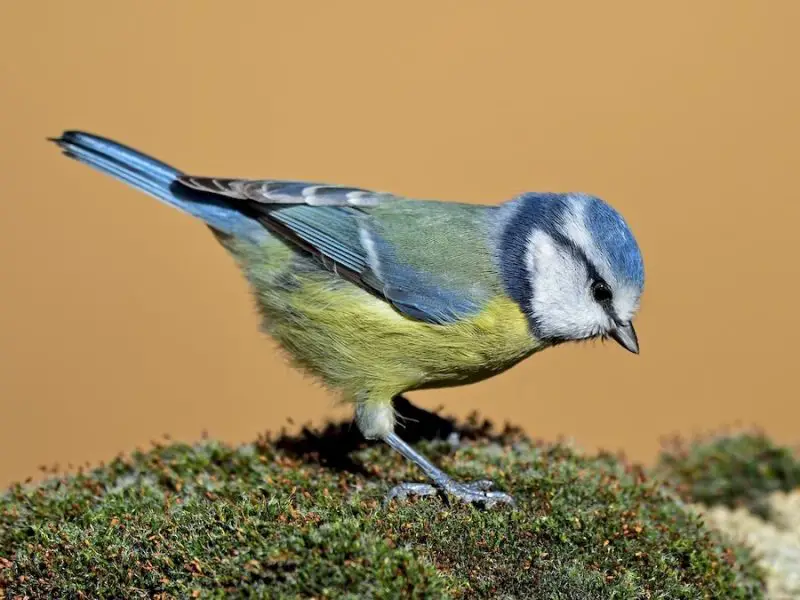
The Eurasian Blue Tit is a small and vibrant bird known for its striking blue and yellow plumage. Its blue cap and wings contrast beautifully with its yellow belly and white cheeks, making it one of the most colorful and recognizable garden birds in Europe.
This bird inhabits woodlands, gardens, and parks across Europe and parts of western Asia. It prefers areas with plenty of trees or shrubs, particularly those that offer cavities for nesting. Blue Tit is non-migratory and adapt well to human presence, often visiting feeders in winter.
They are agile and curious, frequently seen hanging upside down while foraging for insects and seeds. During breeding season, they are highly productive, sometimes raising broods of up to a dozen chicks. Their boldness and cheerful behavior make them a favorite among birdwatchers and backyard enthusiasts.
Eurasian Great Tit

The Eurasian Great Tit is the largest member of the tit family in Europe, easily identified by its glossy black head and neck, white cheeks, and bright yellow underparts with a central black stripe. Its call is varied and often described as a rhythmic “teacher-teacher.”
Great Tit is widespread across Europe, Asia, and North Africa, living in woodlands, parks, gardens, and orchards. They nest in cavities and readily use nest boxes. Their adaptability and intelligence have helped them thrive in urban environments as well.
They are omnivorous, feeding on insects, seeds, and even small invertebrates. Great Tit is also known for their bold personality and complex social behavior. In winter, they may form mixed-species flocks, and studies have shown they can solve simple problems to access food.
Eurasian Coal Tit

The Eurasian Coal Tit is a small bird with a distinctive black cap, white nape patch, and pale underparts. Though more subdued in coloration than its relatives, it can be recognized by its high-pitched, quick calls and its habit of flitting through coniferous trees.
It favors coniferous and mixed woodlands, especially those in cooler regions across Europe and into parts of Asia and North Africa. The Coal Tit often nests in tree holes or even in old stumps and ground cavities, and it is a frequent visitor to feeders in winter.
This species is energetic and constantly on the move, foraging for insects, spiders, and seeds. It has the unusual habit of storing food in crevices during autumn to retrieve during colder months, showcasing its resourceful nature. Despite its tiny size, it’s remarkably hardy.
Eurasian Marsh Tit
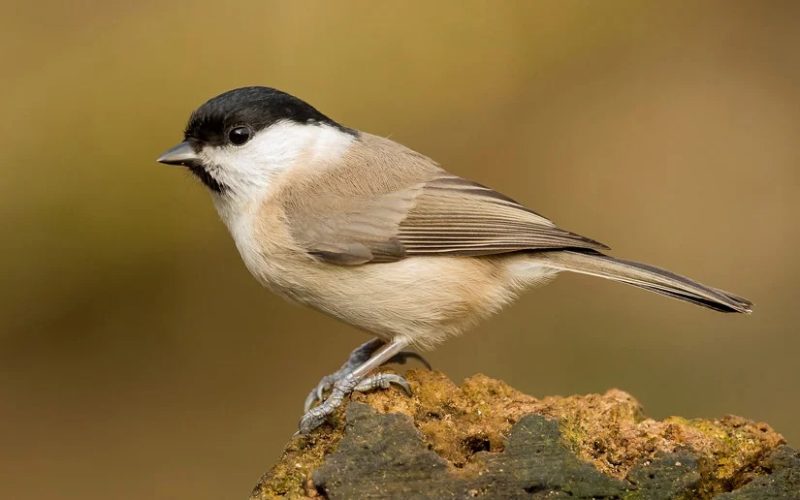
The Eurasian Marsh Tit is a small and rather plain bird, with a glossy black cap, pale cheeks, and soft brownish-grey body. Its song is a soft, nasal “pitchou,” and it can be confused with its close relative, the Willow Tit, though subtle differences exist in their call and behavior.
Marsh Tit is found throughout temperate forests in Europe and parts of Asia, especially favoring moist deciduous woodland with dense undergrowth. They prefer secluded environments and are more elusive than other tit species, often remaining hidden in thick foliage.
Their diet consists of insects, seeds, and berries, and they often stash food in bark or crevices for later use. Marsh Tit is territorial year-round, forming strong pair bonds that last through all seasons. They are cavity nesters, usually taking over abandoned woodpecker holes or natural hollows.
Eurasian Willow Tit
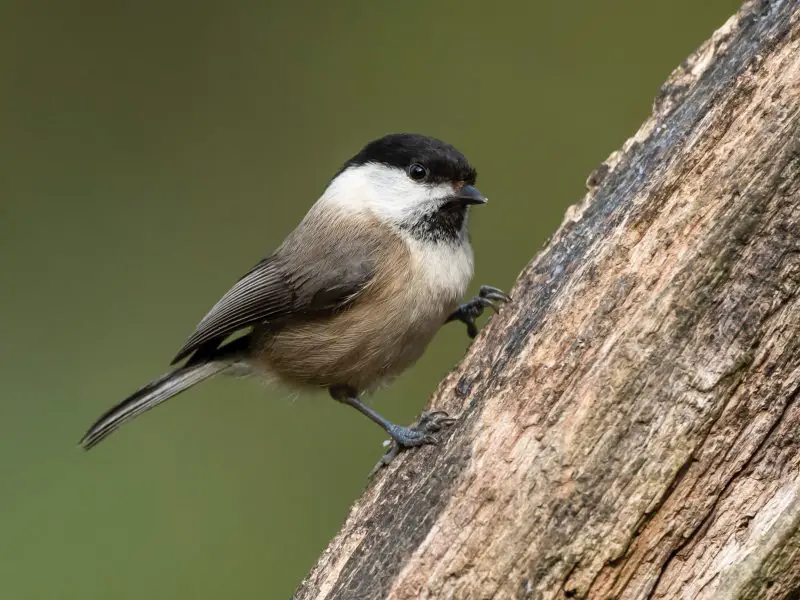
The Eurasian Willow Tit is similar in appearance to the Marsh Tit, with a black cap and pale cheeks, though it often shows a small pale wing panel and a slightly more robust build. Its song is a nasal, descending “dee-dee-dee,” helping distinguish it in the wild.
It inhabits damp woodland, especially near streams, swamps, and wetlands, across parts of Europe and Asia. The Willow Tit prefers areas with decaying wood, where it often excavates its own nesting cavities—an uncommon behavior among tit species.
Though secretive, it is active and vocal during the breeding season. It primarily feeds on insects, larvae, and seeds. Unfortunately, populations have been in decline due to habitat loss and fragmentation, making it a concern for conservation in some regions.
Eurasian Crested Tit

The Eurasian Crested Tit is easily recognized by its spiky black-and-white crest, giving it a distinctive, almost punk-like appearance. Its greyish-brown body and black throat patch complete the look, making it a charming and photogenic forest bird.
It is a resident species of coniferous forests in central and northern Europe, especially thriving in Scots pine woodlands. It prefers mature woodlands with abundant deadwood, which it uses for nesting and foraging. Unlike many other tit species, it does not migrate.
Crested Tit is agile and vocal, often foraging in pairs or small groups. Their diet includes insects, seeds, and spiders, and they frequently cache food for winter. Their elaborate nesting behavior and unique look make them a favorite among woodland birders.
List of Reptiles & Amphibians That Start With E
Eastern Coral Snake
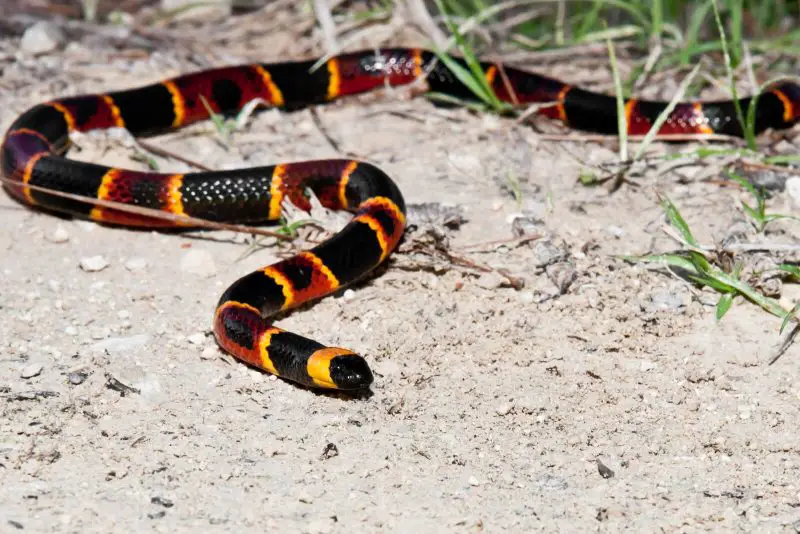
The Eastern Coral Snake is a highly venomous species known for its striking red, yellow, and black banded pattern. Its small head and smooth, slender body help it stay hidden under leaf litter or burrowed in sandy soil. This snake is often mistaken for nonvenomous mimics like the Scarlet Kingsnake, but its color pattern follows the rhyme “red touch yellow, kill a fellow.”
Native to the southeastern United States, the Eastern Coral Snake is found in pine forests, hammocks, and scrublands. It spends most of its time underground or beneath logs and debris, making it elusive despite its vivid appearance. These snakes prefer undisturbed habitats with loose soil or organic matter for hiding.
Eastern Coral Snakes are rear-fanged and possess potent neurotoxic venom, though bites to humans are rare due to their shy and reclusive nature. They primarily feed on other snakes and small reptiles. Despite their danger, they play an important role in the ecosystem by controlling populations of smaller serpents.
Eastern Box Turtle
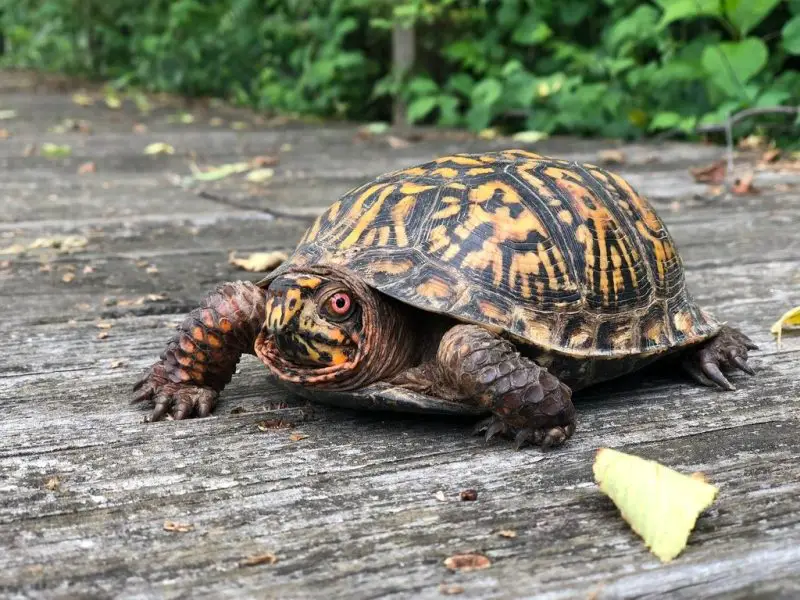
The Eastern Box Turtle is a terrestrial turtle known for its domed shell and ability to completely close itself inside, thanks to a hinged plastron. Its carapace varies in color but usually displays intricate yellow or orange patterns on a dark brown or black background. This feature gives each turtle a unique look.
This species is native to the eastern United States and prefers moist forested areas, meadows, and floodplains. They are most active after rain and during warm weather, often seen slowly foraging in leaf litter or along forest edges. They are known for their longevity, often living 40 to 50 years or more in the wild.
Eastern Box Turtles are omnivores, eating insects, worms, fruits, fungi, and vegetation. They have strong homing instincts and often stay within a few acres their entire lives. Unfortunately, habitat destruction and road mortality have contributed to population declines, making conservation efforts increasingly important.
Eastern Fence Lizard
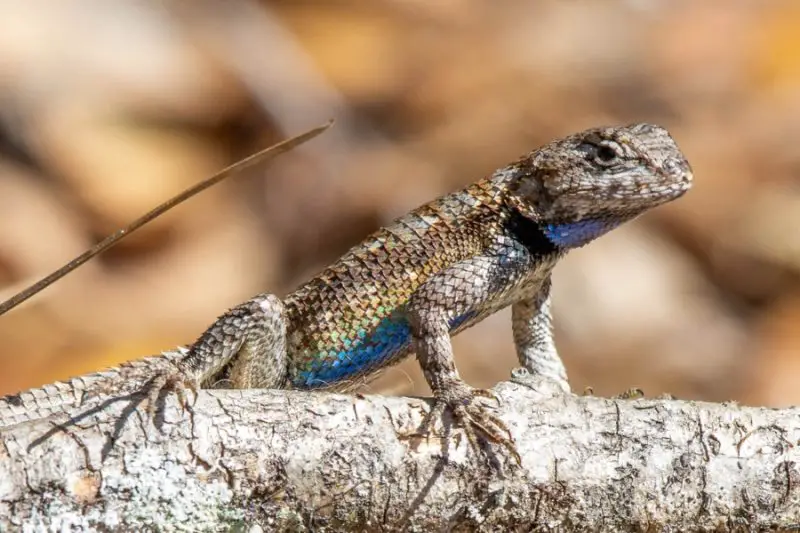
The Eastern Fence Lizard is a medium-sized lizard with rough, spiny scales and a gray to brown body that provides excellent camouflage against bark and rocks. Males often display blue patches on their throat and belly, especially during the breeding season.
It inhabits dry, open forests, rocky hillsides, and wooden fences across much of the eastern and central United States. True to its name, it frequently basks on fences, logs, or tree trunks. It relies on its agility and camouflage to escape predators and regulate its body temperature through sun exposure.
Eastern Fence Lizards are insectivorous, feeding primarily on ants, beetles, spiders, and other small invertebrates. They exhibit fascinating behaviors like push-up displays for territorial or courtship purposes. During cooler months, they hibernate under logs or in crevices, emerging in spring to breed and forage.
Eastern Glass Lizard
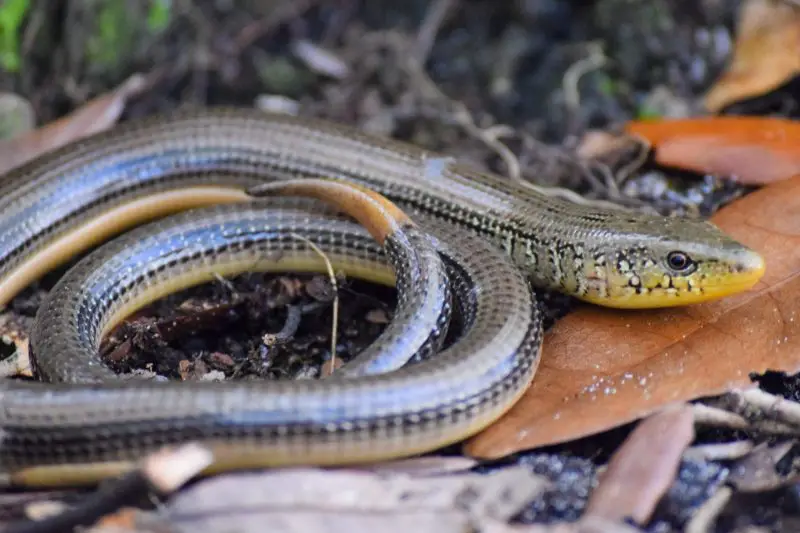
Despite its snake-like appearance, the Eastern Glass Lizard is actually a legless lizard, distinguished by its movable eyelids and external ear openings. Its body is long, slender, and smooth with a greenish to brown coloration and faint stripes or speckling.
This species is found in the southeastern United States, inhabiting sandy pine flatwoods, grassy fields, and coastal dunes. It prefers moist, loose soil and is often found under logs, leaf litter, or in grassy areas. Glass lizards get their name from their fragile tails, which easily break off when threatened.
Eastern Glass Lizards feed on insects, spiders, and small invertebrates. Unlike snakes, they lack flexible jaws and chew their prey. Their tail autonomy serves as a vital defense mechanism, allowing them to escape while predators are distracted by the detached tail. Over time, the tail regrows, though never quite as long.
Eastern Green Mamba
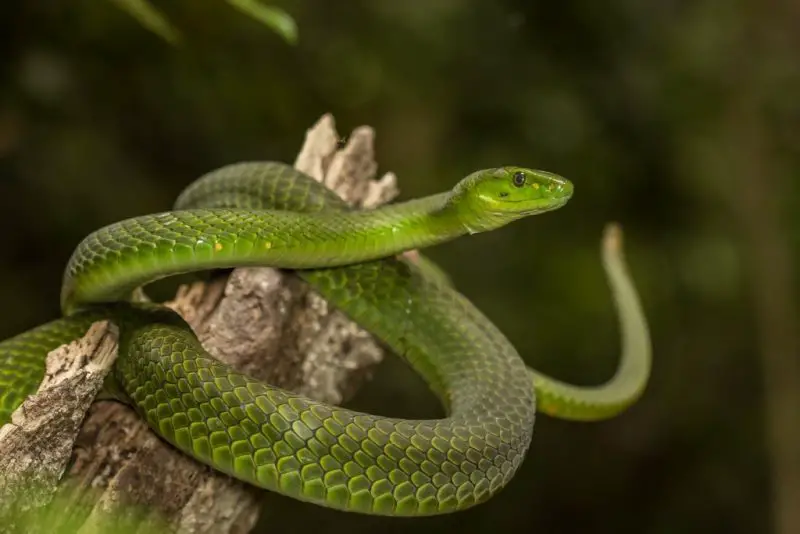
The Eastern Green Mamba is a highly venomous tree-dwelling snake known for its bright green scales and graceful movements. It has a slender body and a coffin-shaped head, making it both beautiful and intimidating. Unlike its more aggressive cousin, the Black Mamba, this species is relatively shy.
Native to the coastal forests and woodlands of East Africa, including Kenya and Tanzania, the Eastern Green Mamba prefers dense vegetation and spends most of its time in trees. It’s rarely encountered by humans due to its arboreal lifestyle and camouflage among leaves and branches.
Its diet consists of birds, eggs, and small mammals, which it subdues with its potent neurotoxic venom. Despite its danger, the Eastern Green Mamba is generally non-confrontational and will flee if given the chance. Encounters are rare, but bites can be fatal without prompt antivenom treatment.
Eastern Hognose Snake
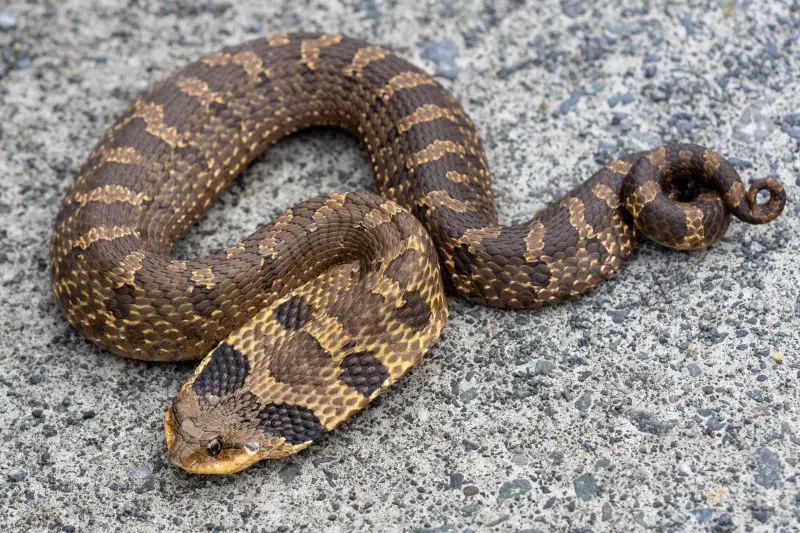
The Eastern Hognose Snake is a non-venomous snake easily identified by its upturned snout, used for digging in sandy soil. Its coloration varies widely, ranging from yellow and brown to black or orange, often with dark blotches down its back. When threatened, it flattens its neck like a cobra or plays dead—flipping onto its back with mouth agape and tongue out.
This snake is commonly found in sandy woodlands, fields, and coastal plains across the eastern United States. It favors areas with loose soil where it can burrow and search for toads, its primary food source. Though it may appear dramatic when threatened, it rarely bites and poses no danger to humans.
Eastern Hognose Snakes are fascinating for their elaborate defense displays and harmless nature. Their bluffing behavior includes hissing, striking without biting, and theatrical death-feigning to confuse predators. These snakes are a valuable part of the ecosystem, helping to control amphibian populations.
Eastern Indigo Snake

The Eastern Indigo Snake is the longest native snake in the United States, reaching lengths up to 9 feet. Its glossy, deep-blue to purplish-black scales give it a striking iridescent appearance, especially under sunlight. Though large and imposing, it is nonvenomous and known for its docile temperament.
This species is primarily found in the southeastern U.S., especially in Florida and southern Georgia. It inhabits pine flatwoods, sandhills, and coastal dunes, often taking refuge in gopher tortoise burrows. The snake prefers dry, open habitats but may venture into wetlands during certain times of the year.
Eastern Indigo Snakes are active hunters that prey on a variety of animals including other snakes (even venomous ones), amphibians, birds, and small mammals. They play an important ecological role and are protected under federal law due to habitat loss and population declines. Their calm nature makes them a favorite among herpetologists.
Eastern Racer
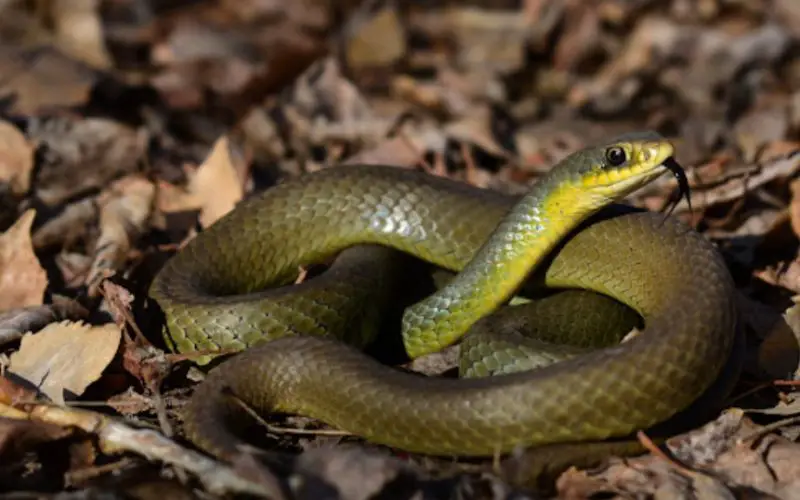
The Eastern Racer is a fast-moving, slender-bodied snake with smooth, black scales and a white or grayish belly. It is known for its exceptional speed and keen eyesight, which it uses to chase down prey. Juveniles are often light gray with dark blotches, gradually darkening as they age.
It ranges widely across the eastern and central United States and inhabits a variety of environments, including grasslands, forest edges, wetlands, and suburban areas. It prefers open spaces where it can swiftly move through vegetation while hunting or escaping threats.
Despite its name, the Eastern Racer doesn’t typically strike when cornered; instead, it relies on speed to evade danger. It feeds on insects, frogs, rodents, and even smaller snakes. When threatened, it may vibrate its tail and release a musky odor, but it’s nonvenomous and generally harmless to humans.
Eastern Rat Snake
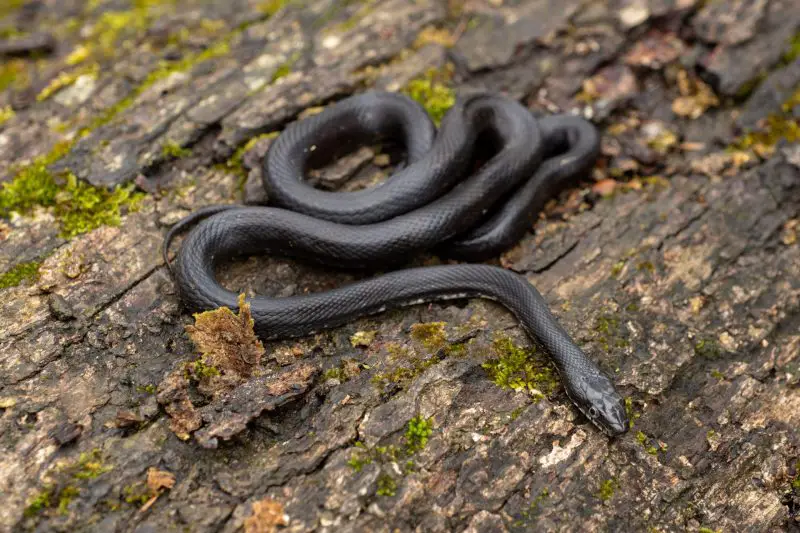
The Eastern Rat Snake, also known as the black rat snake, is a nonvenomous constrictor with shiny black scales, a white chin and throat, and a lightly checkered belly. Juveniles are gray with black blotches and resemble other young snake species.
It thrives throughout the eastern United States and can be found in forests, farmland, barns, and suburban areas. Excellent climbers, they often ascend trees and buildings in search of bird nests or shelter. They hibernate in crevices, tree hollows, or abandoned burrows during colder months.
These snakes help control rodent populations and are crucial to local ecosystems. While they may hiss or shake their tail when threatened, they’re nonaggressive and usually try to flee. Farmers often appreciate their presence, as they reduce crop damage by preying on rodents.
Eastern Tiger Snake
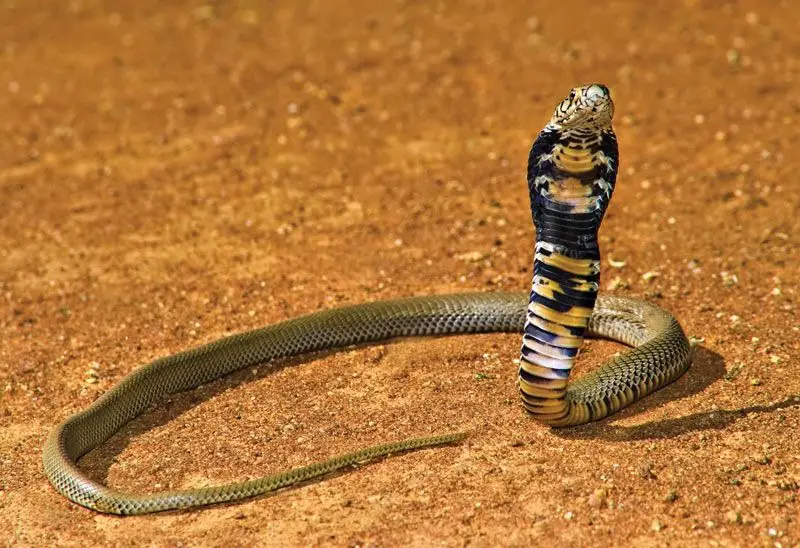
The Eastern Tiger Snake is a highly venomous species native to southeastern Australia and Tasmania. It is recognized by its bold, tiger-like bands of yellow and black (though some individuals may appear solid black or olive). Its thick body and large head make it appear intimidating, even from a distance.
It inhabits wetlands, coastal scrublands, woodlands, and grassy plains, often near bodies of water. Tiger snakes are excellent swimmers and may be found basking near water or under vegetation. They prefer cooler regions and are most active during the day in spring and fall, shifting to nocturnal habits in summer.
These snakes have potent neurotoxic venom but are generally shy and will retreat if not cornered. When threatened, they may flatten their necks and hiss loudly. Their diet includes frogs, fish, birds, and small mammals. Though dangerous, they are important predators in their habitats.
Edible Frog
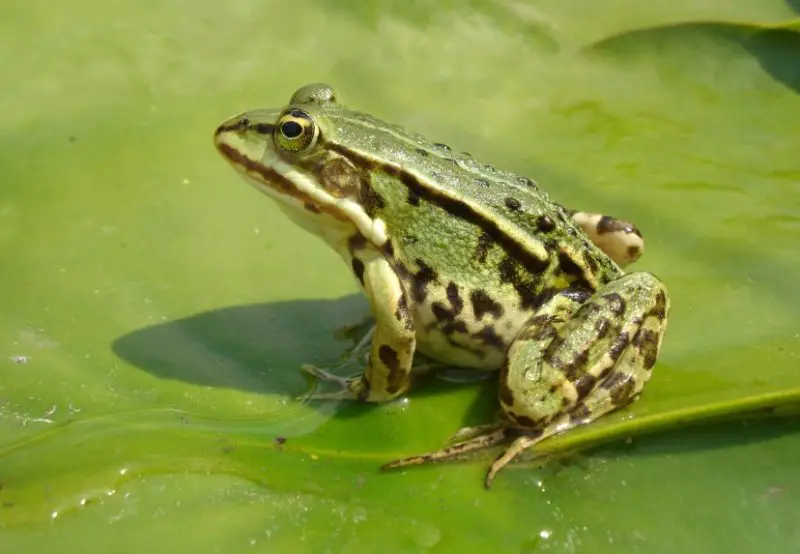
The Edible Frog, also known as the Common Water Frog (Pelophylax kl. esculentus), is a hybrid species between the pool frog and the marsh frog. It has a green to olive coloration with darker spots and a smooth, moist skin. Males have vocal sacs that inflate like balloons during mating calls.
Native to central and northern Europe, the Edible Frog lives in freshwater habitats such as ponds, lakes, and marshes. It prefers shallow, sunny waters with ample vegetation. It hibernates in mud or underwater during the winter months and emerges in spring to breed.
This species is omnivorous and feeds on insects, spiders, worms, and small aquatic animals. Historically, it has been consumed as a delicacy in French cuisine, hence the name “edible frog.” Despite its culinary history, it plays a key role in wetland ecosystems by controlling insect populations.
Eft
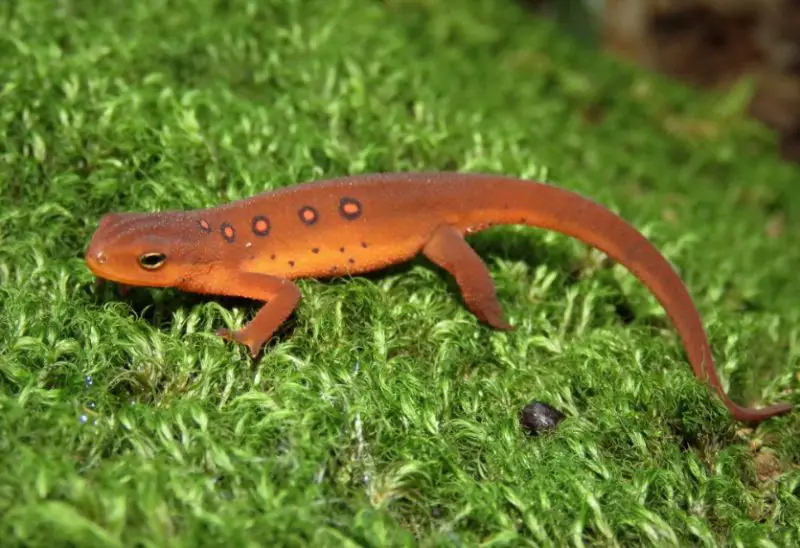
The Eft is the juvenile stage of the Eastern Newt (Notophthalmus viridescens), known for its bright orange or red skin with black spots. This striking coloration serves as a warning to predators of its toxic nature. Efts are small, reaching lengths of about 3 inches and are primarily terrestrial during this stage, making them easy to spot in moist woodlands and wetlands.
Efts are commonly found in the eastern United States and Canada, especially in damp, wooded areas near ponds, lakes, and streams. They require a moist environment to maintain hydration and to support their diet of small invertebrates, such as insects, worms, and larvae.
As juveniles, Efts have a vibrant appearance to warn potential predators, signaling that they are poisonous. They spend several months in their bright-colored eft stage before undergoing metamorphosis into aquatic adults. Their diet consists mainly of small invertebrates and, occasionally, amphibian eggs. Despite their toxicity, they play an important role in controlling insect populations.
Egyptian Tortoise
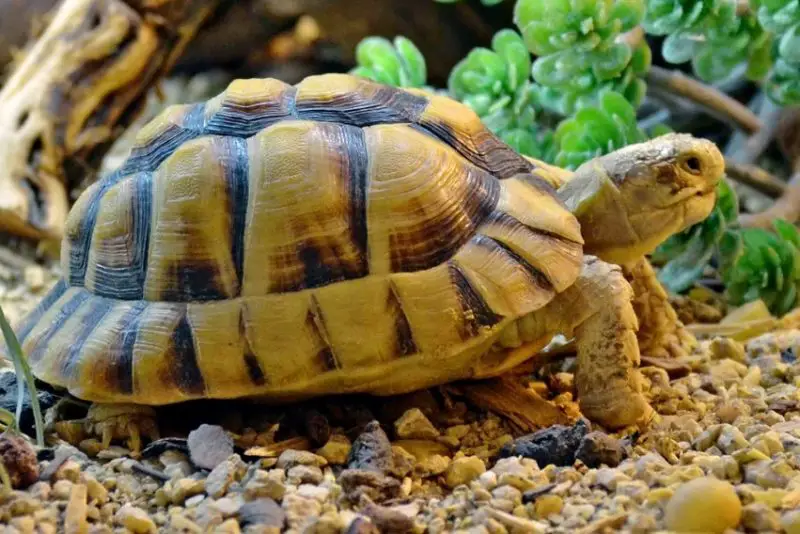
The Egyptian Tortoise (Testudo kleinmanni) is a small species of tortoise native to the deserts of North Africa, primarily Egypt and Libya. It has a high-domed, yellowish-brown shell adorned with dark markings and is one of the smallest tortoises in the world, typically growing up to 6-8 inches in length.
This tortoise is adapted to the harsh desert environment, where it spends much of its time in rocky, arid regions. It requires a warm climate and avoids areas with high humidity or extreme cold. Egyptian Tortoises are herbivores, feeding on grasses, leaves, and fruits, and they tend to remain mostly inactive during the hottest parts of the day, seeking shelter in burrows or under rocks.
Unfortunately, the Egyptian Tortoise is critically endangered due to habitat loss, illegal pet trade, and climate change. Conservation efforts are underway to protect this small, unique species and its desert home. They are primarily active in the morning and late afternoon, avoiding the midday heat.
European Common Frog
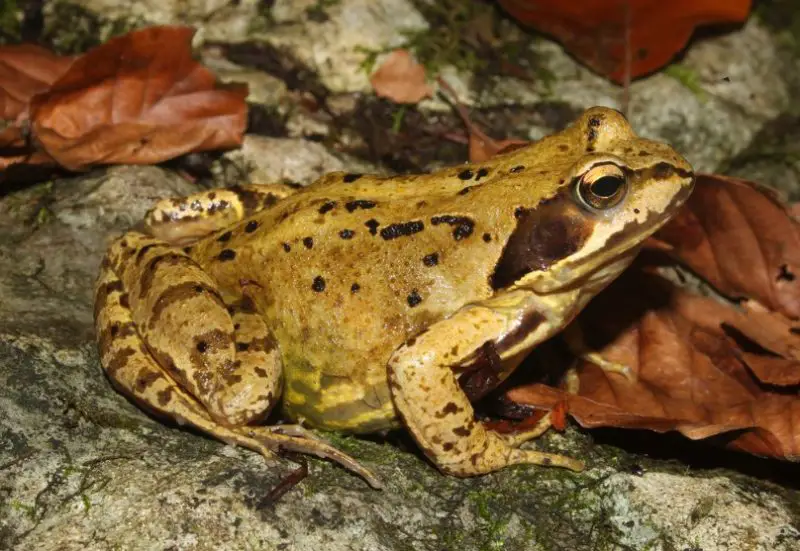
The European Common Frog (Rana temporaria) is one of the most widely distributed frog species in Europe. Typically, it has a smooth, olive-brown or green body with dark spots and a pale belly. These frogs grow to about 2-4 inches and are known for their loud croaks, especially during the breeding season in spring.
Commonly found in a variety of habitats, including woodlands, grasslands, and urban areas, the European Common Frog prefers damp environments near ponds, lakes, and marshes. They spend much of their time in water, using it for breeding and shelter. Their diet includes insects, small invertebrates, and occasionally plant matter.
These frogs are active during both day and night, although they are particularly known for their calls at night, especially during mating periods. They are an important part of their ecosystems, helping to control insect populations while also serving as prey for larger animals. Despite their wide range, they face threats from habitat destruction and pollution, leading to a decline in some areas.
European Grass Snake

The European Grass Snake (Natrix natrix) is a non-venomous snake commonly found across Europe, especially near water bodies like ponds, lakes, and rivers. This snake has a slender body, typically green or olive in color, with a characteristic yellow or white collar around its neck, resembling a “collar” on its otherwise smooth, sleek body.
Grass snakes thrive in areas with abundant vegetation, wetlands, and forests. They are excellent swimmers and are often seen near water, where they hunt for amphibians, fish, and small mammals. Grass snakes primarily prey on frogs, small birds, and fish, using constriction to subdue their prey.
Despite their intimidating appearance, European Grass Snakes are non-venomous and are generally not aggressive toward humans. They are often shy and will usually retreat if threatened. Their ability to swim and their diet make them an important predator in their ecosystems, particularly in controlling amphibian populations.
List of Fish & Marine Animals That Start With E
Eel
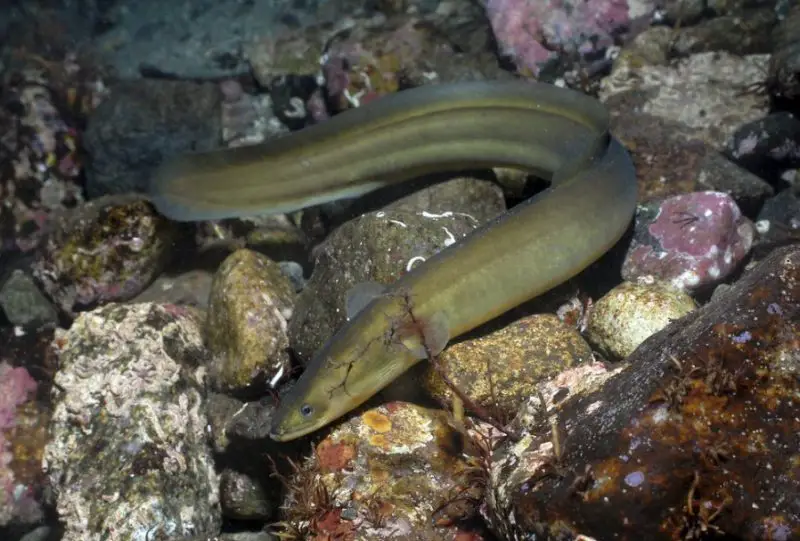
Eels are elongated, snake-like fish found in both saltwater and freshwater environments. They are known for their slippery bodies and their ability to wriggle into narrow crevices. With over 800 species, eels come in various sizes and habitats, ranging from the well-known European eel (Anguilla anguilla) to the more exotic moray eels. They have smooth, cylindrical bodies, which help them navigate through underwater tunnels and caves.
Eels inhabit a variety of environments, including the deep oceans, freshwater rivers, and even brackish waters. Some species are migratory, such as the European eel, which travels thousands of miles from European rivers to the Sargasso Sea to spawn. They primarily feed on smaller fish, crustaceans, and invertebrates, using their keen sense of smell to track down prey.
Despite their often-elusive nature, eels play an essential role in marine ecosystems as both predators and prey. Due to their unique life cycles and importance in aquatic food webs, eels are a subject of significant scientific research. However, many eel populations are facing declines due to overfishing and habitat degradation.
Electric Eel
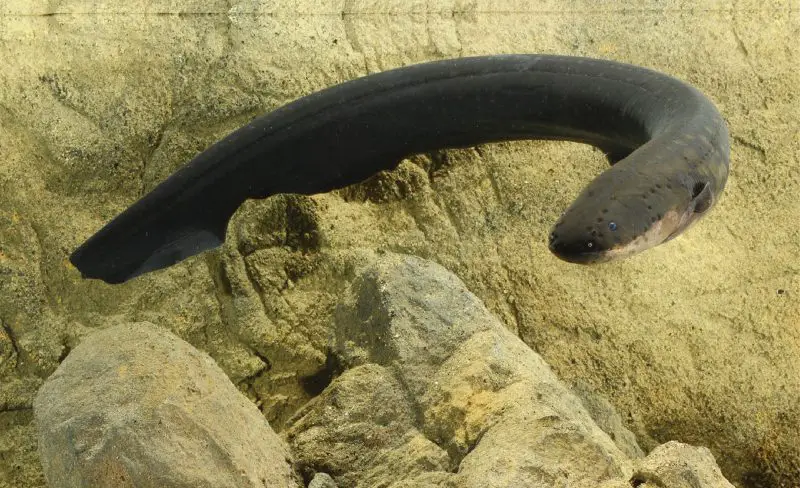
The Electric Eel (Electrophorus electricus) is a fascinating fish known for its ability to generate powerful electric shocks. Native to the Amazon and Orinoco basins in South America, the electric eel can produce electric discharges of up to 600 volts to stun prey or defend itself. This ability is made possible by specialized cells called electrocytes that store and release energy, creating electric pulses.
Electric eels inhabit slow-moving rivers and swamps, where they prefer muddy, shallow waters. They have a long, cylindrical body that can reach up to 8 feet in length. These eels are carnivorous and use their electric shocks to stun fish, which they then swallow whole. They primarily feed on small fish, amphibians, and invertebrates.
Despite their menacing name, electric eels are not aggressive toward humans unless threatened. They rely on their electric abilities to navigate, communicate, and capture prey in the dark, murky waters where they live. Their electric capabilities are so powerful that they have even been studied for medical and technological advancements in bioelectricity.
Eagle Ray
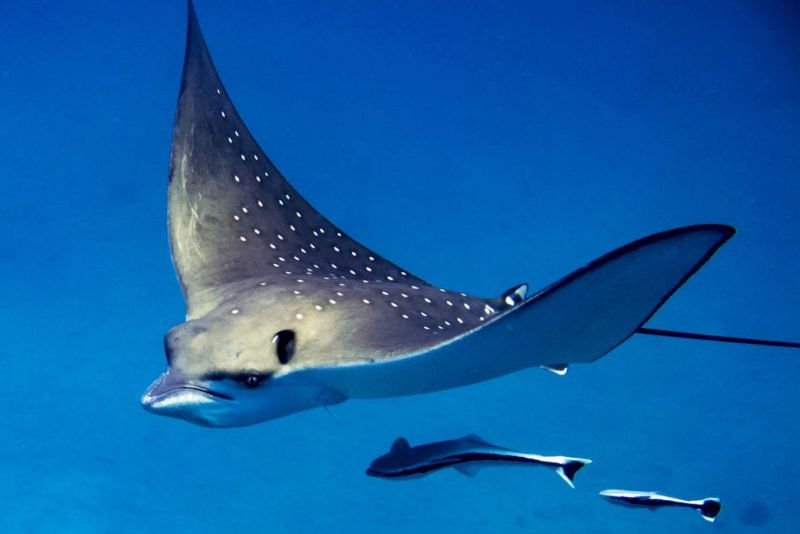
The Eagle Ray (Aetobatus narinari) is a species of ray fish found in tropical and subtropical waters around the world. Known for their graceful swimming and distinct wing-like pectoral fins, eagle rays can reach up to 10 feet in width. They have a long, whip-like tail and a characteristic triangular shape, resembling the wings of an eagle, which is how they got their name.
These rays prefer shallow coastal waters, often near coral reefs, sandy flats, and seagrass beds, where they hunt for their food. Eagle rays primarily feed on mollusks, crustaceans, and small fish, using their flattened bodies and sharp, flattened teeth to crush prey. They are also known for their ability to swim at high speeds and leap out of the water, often in spectacular displays.
Eagle rays are peaceful creatures and are not considered dangerous to humans. They are sometimes hunted for their meat and for display in aquariums, though they face threats from habitat loss and environmental degradation. Conservation efforts are in place to protect these beautiful animals and their delicate ecosystems.
Eelpout

The Eelpout is a species of fish belonging to the family Zoarcidae, primarily found in cold waters of the Northern Hemisphere. Eelpouts have a snake-like, elongated body, with small pectoral fins and a head that is relatively small in comparison to their long bodies. They are often confused with eels due to their similar appearance but are in fact a distinct group of fish.
Eelpouts can be found in deep, cold waters, particularly along the ocean floor, where they prefer rocky or muddy habitats. They are primarily benthic, meaning they live close to the seabed, where they hunt for invertebrates, small fish, and detritus. Some species of eelpouts are known to live in deep ocean trenches, where little light penetrates.
Eelpouts are not commonly encountered by humans, as they live in relatively inaccessible areas of the ocean. Their ability to survive in extreme cold waters makes them an important part of the food web in their ecosystems. However, due to their remote habitat, eelpouts are rarely studied in great detail.
Emperor Angelfish

The Emperor Angelfish (Pomacanthus imperator) is a brightly colored fish found in the coral reefs of the Indo-Pacific region, including the Red Sea, the Great Barrier Reef, and the Philippines. These fish are easily recognized by their bold, striking patterns of blue, yellow, and black, with vertical stripes that run across their bodies. As adults, they can grow up to 15 inches long.
Emperor Angelfish thrive in warm, shallow waters, particularly in areas with abundant coral reefs, where they find both shelter and food. They are primarily herbivores, feeding on algae, sponges, and small invertebrates found on the reef. Their strong jaws allow them to scrape algae from rocks and corals efficiently.
In addition to their vibrant appearance, Emperor Angelfish are known for their territorial nature. They tend to defend their home reefs from other fish species. While they are not considered endangered, they are often targeted by the aquarium trade, which can impact their populations in the wild. Conservation efforts help ensure that these beautiful fish continue to thrive in their natural habitats.
Escolar
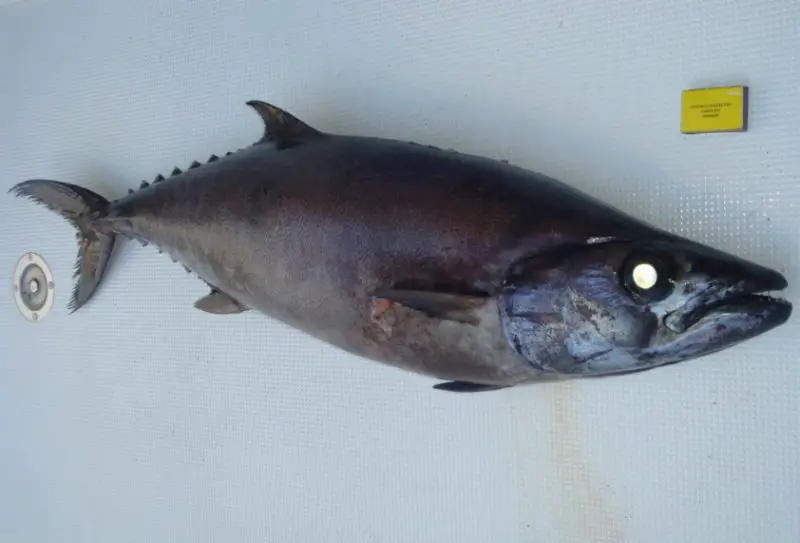
Escolar (Lepidocybium flavobrunneum) is a deep-sea fish that is known for its high fat content, which makes it particularly rich in oil. This species is often called the “butterfish” or “oilfish” because of its fatty flesh. Escolar can grow up to 6 feet in length and is found in tropical and subtropical waters, primarily in the Indian Ocean and the Pacific Ocean. The fish has a sleek, elongated body with a silvery sheen that helps it blend into its environment.
Escolar typically inhabits deep waters and is known for its predatory behavior. It hunts smaller fish, squid, and invertebrates. This species is not commonly fished commercially, but it has become a popular choice in certain parts of the world, especially in gourmet cooking. Despite its popularity, consuming large amounts of escolar can lead to digestive issues, as the fish’s high wax ester content can cause gastrointestinal discomfort.
Escolar is often served in high-end restaurants, especially in sushi dishes, where its rich, buttery texture is highly valued. However, due to its potential to cause digestive problems, many countries have regulations on its sale. As a result, some places have adopted labeling requirements to inform consumers of the potential side effects.
Elephant Fish

The Elephant Fish (Callorhinchus milii) is a unique species of ray-finned fish native to the coastal waters of Australia and New Zealand. It is named after its distinctive appearance, featuring a long, trunk-like snout that resembles an elephant’s trunk. This snout is used to search for food on the seafloor, where the elephant fish feeds on small invertebrates, crustaceans, and mollusks. The body is soft and silvery, with a relatively small size, typically growing up to 1.5 meters in length.
Elephant fish are usually found in shallow waters along the coastlines, often in sandy or muddy habitats where they can burrow into the substrate. They are most active at night when they use their long, flexible snouts to forage for food. Although they are primarily benthic, meaning they live close to the ocean floor, elephant fish can also be found in deeper waters at certain times.
While the elephant fish is not commonly eaten by humans, its appearance and behavior make it an interesting subject for scientific study. It is also a part of the family of species that is important to the marine ecosystems of southern Australia and New Zealand. Due to its unusual anatomy and feeding habits, the elephant fish continues to fascinate marine biologists and nature enthusiasts alike.
Electric Catfish
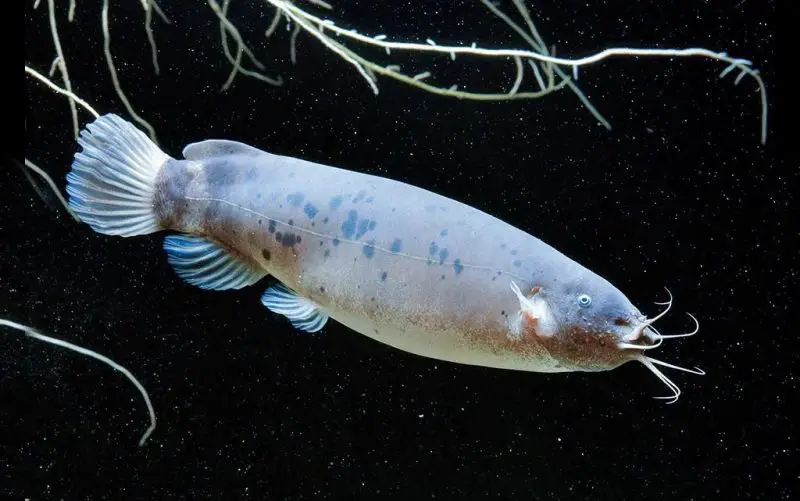
The Electric Catfish (Malapterurus electricus) is a fascinating species of freshwater fish native to the rivers and lakes of Africa. Known for its ability to generate electric shocks, the electric catfish can produce a powerful electrical discharge of up to 350 volts. This ability is used both for hunting and self-defense. The electric organs, located in the fish’s body, are capable of producing the electrical pulses that stun prey or ward off potential threats.
Electric catfish are typically found in slow-moving rivers, lakes, and marshes with warm, tropical climates. They prefer muddy, low-visibility waters where they can easily ambush their prey. They primarily feed on smaller fish, invertebrates, and even amphibians. Their electric abilities also help them navigate and communicate in their dark aquatic environments.
Though they are not a common catch for commercial fisheries, electric catfish are important to local ecosystems, where they help control populations of smaller fish and invertebrates. However, their electric discharge can be dangerous if not handled carefully, especially for fishermen or divers who come into contact with them. In some areas, electric catfish are also studied for their potential medical applications, including bioelectricity research.
Edible Crab
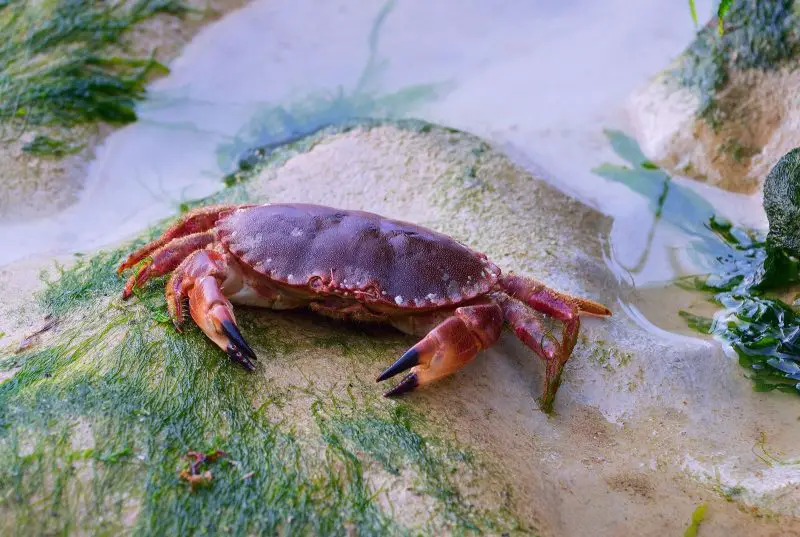
The Edible Crab (Cancer pagurus), also known as the brown crab, is a species of crab found in the coastal waters of the North Atlantic. It is one of the most commonly consumed crab species and is highly valued for its tender, sweet meat. The shell of the edible crab is hard and rough, typically colored brown or reddish with a pale underside. Adult crabs can reach up to 10 inches in width and are easily recognizable by their large, robust claws.
Edible crabs are primarily found in shallow waters, often in sandy or rocky habitats along the coasts of Europe and parts of the western Atlantic. They are scavengers, feeding on a wide variety of food sources, including mollusks, small fish, and other marine invertebrates. Crabs use their powerful claws to crush and crack open shells to access their prey. They also use their claws for defense and to establish territory.
The edible crab is a staple in many cuisines, particularly in coastal regions where they are harvested both commercially and recreationally. Their meat is prized for its delicate texture and flavor, and they are often prepared by boiling or steaming. In addition to their culinary importance, edible crabs also play a significant role in marine ecosystems by contributing to the balance of marine food webs.
List of Insects & Invertebrates That Start With E
Earthworm
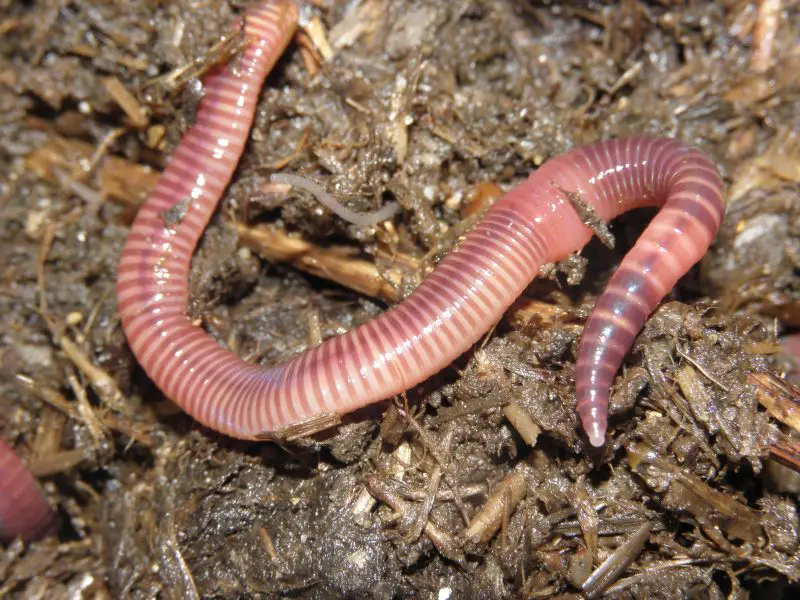
Earthworms are essential creatures in the ecosystem, often referred to as “nature’s plows” due to their role in aerating and enriching the soil. These worms are segmented and can range in size from small, 2-inch varieties to large species, such as the giant earthworm, which can grow up to 10 feet in length. They are typically found in moist, rich soils where they burrow and feed on organic matter like decaying leaves and plant material. Their movements through the soil help break down organic matter, enhancing soil fertility.
Earthworms are predominantly found in gardens, forests, and agricultural fields, where their activity is crucial to the health of the soil. They live in tunnels that they create by ingesting soil and organic material. As they digest this material, they excrete nutrient-rich castings, which improve soil structure and help retain moisture. Earthworms are typically nocturnal, emerging at night or during wet conditions to avoid desiccation under the sun.
Earthworms are not only important for agriculture and gardening but also for biodiversity. Their presence enhances the ecosystem by promoting nutrient cycling. Interestingly, certain bird species, such as robins, are known to rely heavily on earthworms as a primary food source. The presence or absence of earthworms in an area can also serve as an indicator of soil health.
Earwig
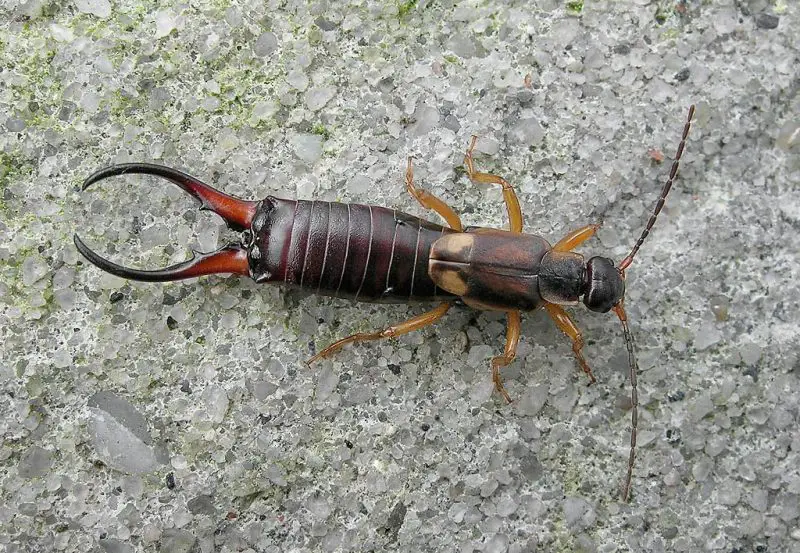
The earwig (Forficula auricularia) is a small, nocturnal insect known for its distinctive pincers, or cerci, at the rear of its body. These pincers are used primarily for defense and during mating rituals. The earwig’s body is long and narrow, typically brown or black, with flat, leathery wings that it rarely uses for flight. Earwigs can grow up to 1.5 inches long and are commonly found in moist environments, including gardens, leaf litter, under stones, and in crevices.
Earwigs are omnivorous, feeding on a variety of organic matter. Their diet includes leaves, decaying plant matter, and small insects, making them both beneficial and sometimes problematic in gardens, where they can damage young plants. Despite their reputation, earwigs are not harmful to humans and do not “crawl into ears,” as their name might suggest. They are generally shy creatures that prefer to hide during the day and emerge at night to feed.
Though earwigs are not major pests, they can become a nuisance in certain areas. They are especially attracted to damp conditions and are often found in large numbers in environments that provide them with shelter and moisture. Interestingly, some species of earwigs are known to exhibit parental care, a rare trait among insects, where the mother guards her eggs and young nymphs until they are old enough to fend for themselves.
Emperor Dragonfly

The Emperor Dragonfly (Anax imperator) is one of the largest and most impressive dragonfly species in Europe, known for its striking appearance and predatory behavior. With a body length of up to 3 inches and a wingspan that can reach 5 inches, the emperor dragonfly is hard to miss. It has bright blue coloration on its thorax and abdomen, contrasted by black markings that make it easily recognizable. The dragonfly’s large eyes cover most of its head, providing it with exceptional vision, which is crucial for hunting.
Emperor dragonflies are found near bodies of freshwater such as ponds, lakes, and marshes. They spend the majority of their lives as larvae, living underwater where they hunt smaller aquatic creatures. After emerging as adults, emperor dragonflies become skilled hunters, preying on flying insects such as flies, bees, and other dragonflies. They are fast fliers, able to catch their prey mid-air with impressive accuracy.
The emperor dragonfly is often admired by entomologists and nature enthusiasts for its aerial acrobatics and hunting efficiency. Its life cycle, which includes an extended aquatic larval stage, is of particular interest to researchers studying the behavior and physiology of insects. While it is not considered threatened, the health of emperor dragonfly populations can indicate the quality of freshwater habitats, making them useful indicators of environmental health.
Emerald Cockroach Wasp
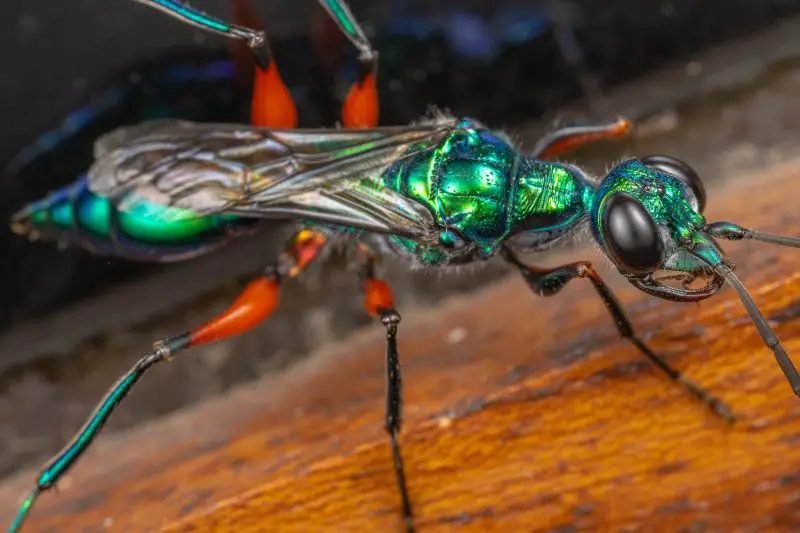
The Emerald Cockroach Wasp (Ampulex compressa) is a fascinating and highly specialized species known for its unique and somewhat eerie behavior. This parasitic wasp targets cockroaches, using them as living hosts for its larvae. The wasp first stings the cockroach, injecting venom into its brain, which essentially “zombifies” the roach. Afterward, the wasp leads the dazed cockroach to its burrow, where it lays an egg on the roach’s abdomen. The egg hatches, and the larva feeds on the cockroach, slowly consuming it while it is still alive.
This parasitic relationship is one of the most remarkable examples of behavior manipulation in nature. The venom injected by the wasp makes the cockroach lose its will to flee and becomes an easy meal for the wasp’s offspring. The process ensures the larvae have a fresh food source that will not escape before they are fully developed. Once the larva completes its life cycle inside the cockroach, it will emerge, ready to continue the cycle.
Emerald cockroach wasps are found primarily in tropical and subtropical regions and are often studied for their remarkable biological and neurological effects on cockroaches. Despite their terrifying method of reproduction, these wasps are not harmful to humans and are generally solitary creatures. Their behavior serves as a fascinating example of parasitism and evolution in the natural world.
Eyed Click Beetle
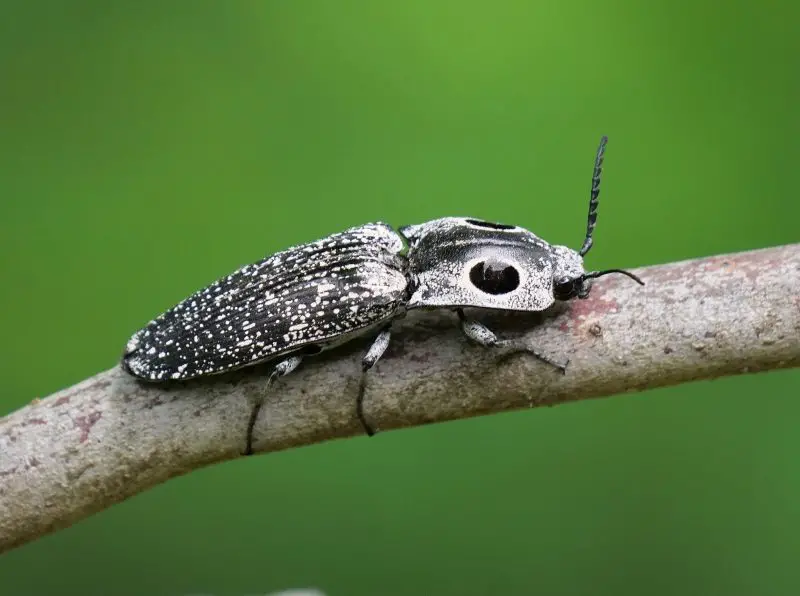
The Eyed Click Beetle (Alaus oculatus) is a large beetle species notable for the distinctive “eyes” on its thorax that resemble those of a predator, such as a bird, designed to intimidate potential threats. These markings, often pale or yellow with black centers, help confuse and deter predators. The beetle’s body is long and cylindrical, typically dark brown or black, with some species exhibiting iridescent colors. One of the most fascinating features of the Eyed Click Beetle is its ability to produce a loud “clicking” sound. This noise is made when the beetle flips itself into the air by snapping its thorax against its abdomen, a behavior used to escape from predators or flip itself over if it gets stuck.
Eyed Click Beetles are primarily found in wooded areas, especially in deciduous forests where they reside under tree bark, in leaf litter, and decaying wood. The larvae, which are often white or cream-colored, live in rotting wood and are considered important decomposers, breaking down dead organic material. As they mature into adults, they take on the role of feeding on plant matter, although their primary diet tends to consist of rotting wood.
These beetles are relatively harmless to humans, with their most remarkable trait being the unique clicking mechanism they use to escape danger. The Eyed Click Beetle is also an important part of the forest ecosystem due to its role in the decomposition process. Though not a common sight, their unusual appearance and behavior make them a fascinating species to study for entomologists and nature enthusiasts alike.
European Corn Borer

The European Corn Borer (Ostrinia nubilalis) is a significant agricultural pest known for its destructive effects on corn crops. Native to Europe, this moth species has spread across North America and other regions, where its larvae damage corn plants by burrowing into the stalks and ears. The adult moth has a light brown or grayish appearance with distinctive darker markings on its wings, making it recognizable by its unique coloration. The larvae, however, are the real problem, as they tunnel through the corn, weakening the plants and reducing crop yields.
European Corn Borers are typically found in agricultural fields, especially cornfields, where they thrive in warm, temperate climates. They tend to lay their eggs on the leaves of corn plants, and once hatched, the larvae enter the stalks or ears of the corn to feed. This feeding behavior can cause significant economic losses, as it makes the corn plants more susceptible to disease and fungal infections. The larvae grow through several stages, eventually pupating in the soil before emerging as adult moths to continue the cycle.
Farmers often use various control measures to manage European Corn Borer populations, such as insecticide application, crop rotation, and the introduction of natural predators. Despite the challenges they pose to agriculture, these pests are also a prime subject for studying pest management techniques and the ecological interactions between insects and their environments.
Echinoderm

Echinoderms are a diverse group of marine invertebrates that include well-known species such as starfish, sea urchins, sea cucumbers, and sand dollars. They are characterized by their radial symmetry, a hard, spiny exoskeleton, and a unique water vascular system that helps them move and feed. Echinoderms are primarily found on the ocean floor, from shallow coastal waters to deep sea environments, where they play essential roles in the ecosystem, often acting as scavengers or predators. Their hard outer shells help protect them from predators and environmental conditions, while their tube feet, located on the underside of their bodies, assist in movement and food gathering.
The diet of echinoderms varies depending on the species. For example, starfish are opportunistic feeders that use their tube feet to pry open shellfish and consume them, while sea urchins graze on algae. Sea cucumbers, on the other hand, sift through sediment on the ocean floor to extract organic matter. This feeding behavior is important for maintaining the health of marine ecosystems, as it helps control algae growth and facilitates nutrient recycling in the ocean.
Echinoderms also have fascinating regenerative abilities. Many species, such as starfish, can regrow lost limbs, and some sea cucumbers can regenerate entire bodies. Their ability to regenerate makes them a subject of interest in scientific research, particularly in studies on healing and tissue regeneration. Despite their simple appearance, echinoderms are complex creatures that play critical roles in maintaining the balance of marine ecosystems.
List of Prehistoric Animals That Start With E
Elasmosaurus

Elasmosaurus was a large marine reptile that lived during the Late Cretaceous period, about 70 million years ago. It is most notable for its incredibly long neck, which made up about half of its total body length. Elasmosaurus had a relatively small head with sharp teeth, which suggests it preyed on fish and small marine invertebrates. This creature was part of the plesiosaur group, a diverse group of reptiles that thrived in the oceans during the Mesozoic Era. Despite its size, Elasmosaurus was not particularly fast, but it likely used its long neck to hunt prey over wide areas of the ocean.
Elasmosaurus lived in warm, shallow seas, where it could swim in search of food. Its long neck allowed it to reach into tight spaces between rocks or to search for prey in the water column. It had four flippers that helped it maneuver through the water, making it a proficient swimmer. This species was distributed in what is now North America, and its fossils have been found in various parts of the continent. Its environment was rich in marine life, providing an ample food source for such a specialized predator.
Elasmosaurus is an iconic example of prehistoric marine life, and it has captured the imagination of paleontologists and enthusiasts alike. Its distinctive long neck and body structure set it apart from other marine reptiles, and it remains one of the most well-known creatures from the age of dinosaurs. The fossilized remains of Elasmosaurus have provided important insights into the evolution of marine reptiles and the environments they once inhabited.
Elasmotherium
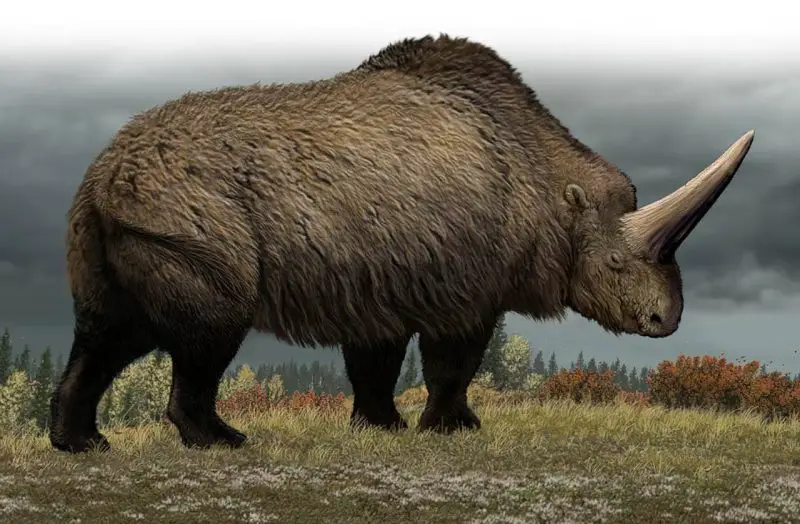
Elasmotherium, often referred to as the “Siberian unicorn,” was a massive prehistoric rhinoceros that lived during the Pleistocene epoch. This extinct species is known for its enormous size, reaching lengths of up to 16 feet and standing nearly 6 feet tall at the shoulders. One of the most striking features of Elasmotherium was its long, single horn that could have grown up to 5 feet in length. This horn was likely used in combat, social interactions, or for defense against predators, although its exact function is still debated by scientists.
Elasmotherium lived in the open grasslands and steppes of Eurasia, from present-day Russia to Central Asia. It thrived in cold, arid environments and was well-adapted to harsh climatic conditions, feeding on a diet of grasses, shrubs, and other vegetation found in these regions. Elasmotherium was part of a larger group of megafauna that roamed the Earth during the Pleistocene, but it eventually went extinct around 39,000 years ago, possibly due to climate change or hunting pressures from early human populations.
The “unicorn” moniker comes from the creature’s single, impressive horn, which led to ancient myths and legends. Elasmotherium’s relatively recent extinction has fascinated researchers, as it lived during a time when humans were beginning to spread across the globe. Fossil evidence, including skulls and horn fragments, continues to provide valuable insights into the life and habits of this prehistoric giant.
Embolotherium
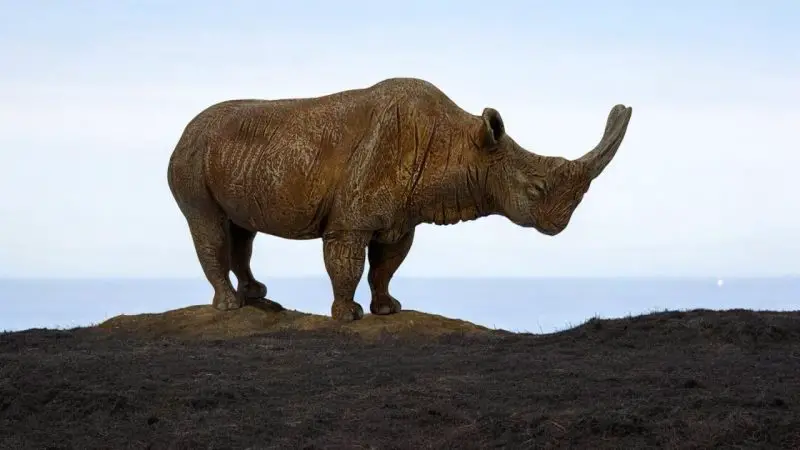
Embolotherium was a large herbivorous mammal that lived during the Eocene epoch, about 40 million years ago. It belonged to a group of animals called entelodonts, which are often referred to as “hell pigs” due to their aggressive and terrifying appearance. Embolotherium had a large, robust body with powerful jaws and teeth, suited for consuming tough vegetation. One of its most distinctive features was its broad, flat skull and wide mouth, which may have been adapted for stripping and chewing vegetation, although its teeth suggest it may have also been opportunistic in its diet.
This animal lived in warm, temperate regions of what is now North America and Europe, where it would have inhabited forested areas. Embolotherium’s behavior and ecology remain somewhat mysterious, but it likely roamed in herds for protection, as its size and strength could have been intimidating to predators. Fossils of Embolotherium have been found in areas that once held lush forests, indicating that the creature was well-suited to environments rich in plant life.
Despite its seemingly harmless herbivorous diet, Embolotherium was part of a group of animals that had the potential to be quite dangerous. With its powerful jaws and massive size, it would have been a formidable presence in its environment. The remains of Embolotherium provide valuable insights into the early evolution of mammalian species and the ecosystems they lived in during the Eocene period.
Eryops
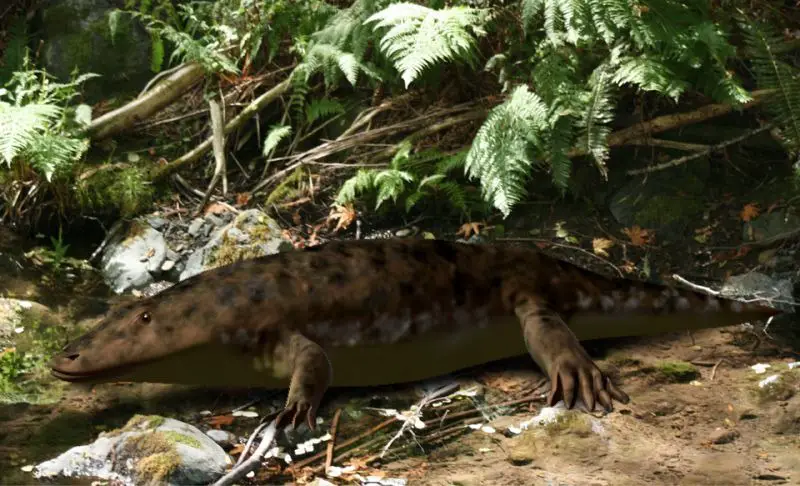
Eryops was a large, carnivorous amphibian that lived during the early Permian period, around 290 million years ago. It was a prominent predator of its time, with a body length of up to 6 feet. Eryops had a broad, flat body and a large head filled with sharp teeth, which it likely used to catch and consume smaller vertebrates and invertebrates. Its powerful limbs and muscular build suggest that it was well-suited for both land and aquatic environments, making it an excellent swimmer and a formidable hunter on land.
Eryops inhabited swampy, freshwater environments such as ponds, rivers, and wetlands, where it could easily access prey. These areas were rich in the small vertebrates, insects, and crustaceans that made up the bulk of its diet. Eryops spent a significant amount of time in the water, using its strong legs to move along the riverbeds and capture its prey. As an amphibian, it was one of the first vertebrates to fully adapt to life both in and out of the water, marking an important step in the evolution of land-dwelling creatures.
The fossilized remains of Eryops have provided paleontologists with crucial information about the transition from aquatic to terrestrial life during the early stages of vertebrate evolution. Its size and position in the food chain made it a dominant predator in its ecosystem, and it represents an important link in the history of amphibians and early land animals.
Epidexipteryx
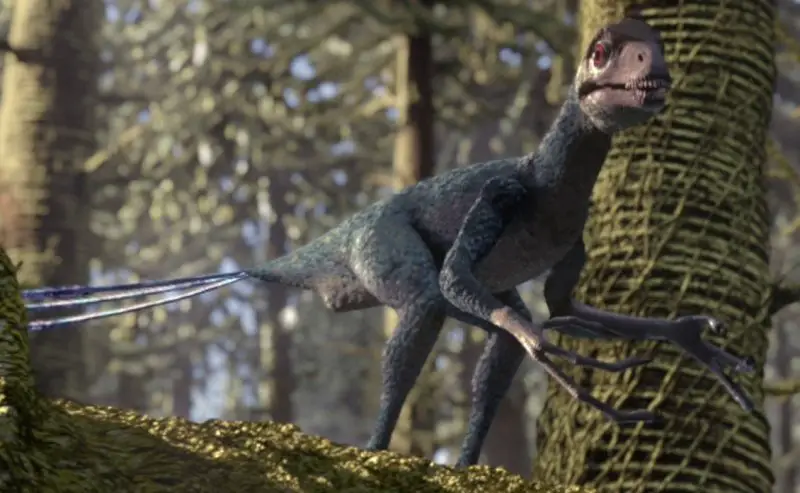
Epidexipteryx was a small, feathered dinosaur that lived during the Late Jurassic period, approximately 161 million years ago. It belonged to the group of dinosaurs known as theropods and is closely related to modern birds. Epidexipteryx had a lightweight body with long, delicate feathers on its arms and tail, which suggests that it might have been capable of gliding, if not true flight. Its tail was particularly long, adorned with several long, ribbon-like feathers that extended beyond its body. These features made Epidexipteryx one of the earliest known examples of feathered dinosaurs, shedding light on the evolutionary transition from dinosaurs to birds.
This dinosaur likely lived in forested or woodland environments where it could take advantage of the cover provided by trees and shrubs. It probably fed on insects, small vertebrates, and other available resources in its environment, using its agility to chase down prey. Epidexipteryx’s small size and flight-like characteristics suggest that it may have spent a lot of time in trees or other high places, using its feathers for balance or possibly gliding short distances to escape predators or move between feeding areas.
Fossils of Epidexipteryx have provided important evidence about the development of feathers in dinosaurs and their potential use for flight or other purposes. While it may not have been capable of sustained flight like modern birds, the unique feather structure and its relationship to theropods offer critical insights into the evolutionary link between dinosaurs and birds.
Euoplocephalus

Euoplocephalus was a large, armored dinosaur that lived during the Late Cretaceous period, around 75 million years ago. It belonged to the group of dinosaurs known as ankylosaurs, characterized by their heavy bony armor and clubbed tails. Euoplocephalus was one of the most well-known ankylosaurs, and its body was covered in thick, bony plates and spikes that offered protection from predators. The most distinctive feature of this dinosaur was its massive, club-like tail, which it could use as a weapon to defend itself against carnivores such as theropods.
Euoplocephalus lived in what is now North America, where it roamed the forests and floodplains. It was a herbivore, feeding on low-lying plants, ferns, and shrubs. Its low-slung body and wide stance allowed it to move through dense vegetation while grazing. The heavy armor on its back protected it from attack, and its tail was likely used as a deterrent or to fight off predators that came too close. This creature was relatively slow-moving due to its heavy armor but was well-protected by its defensive adaptations.
The discovery of Euoplocephalus fossils has provided valuable insights into the life of armored dinosaurs and their defense mechanisms. Its well-preserved remains allow scientists to study its skeletal structure and better understand the evolution of ankylosaurs and their role in prehistoric ecosystems.


